.webp)

Everest Base Camp Trek
.webp)
Kathmandu |
Kathmandu | Nepal
Max Altitude
Trekking Km
Help & Support
67000 /person $ /person.
- September-2024
- October-2024
- November-2024
- USD 1500 +5% GST for Non-Indians and OCI card holders
- +5% GST (Goods and Services Tax)
- Services from Kathmandu to Kathmandu.
- Lukla flight, Food & Stay in Kathmandu included.
Offload 5300
Backpack offload is optional
Choose add-ons during booking. If missed, log in and add them later.
Book off-load at least 10 days before the trek.
For offline bookings at the base camp, a convenience fee of Rs. 6500 applies.
Cancellations made before the trip date will receive a full refund.
For more information. Please complete this form.
Trek Name: Everest Base Camp Trek
Adventure Type: Trekking
Base Camp: Kathmandu
Season: Summer | Autumn |
Month: March | April | May | September | October | November |
Country: Nepal
Altitude: 18200 Ft.
Grade: Difficult
Rail Head: Kathmandu is not connected to any Railways
Stay: Hotel and teahouse
Food: Meals while on trek & at Hotel/Guesthouse (Veg & Eggs)
Location: Kathmandu
Distance: 108 Km.
Trail Type: Circle trail | Camping in various locations, starting and ending at the same point.
AirPort: Kathmandu (Tribhuvan International Airport)
Why Everest Base Camp Is A Must-Do Trek
When it comes to trekking in the Himalayas, Mt. Everest is the most celebrated peak and not just in our country but all across the globe. For avid trekkers and mountaineers, getting up close to the highest mountain peak in the world is a once-in-a-lifetime experience. This classic trek takes place in the Bagmati Zone of Nepal and allows you to experience the immense beauty of the surroundings. Along your trek, you will get to witness 4 of the 6 highest mountain peaks in the world — Cho Oyu (8,201 m), Mt. Makalu (8,470 m), Mt. Lhotse (8,516 m), and Mt. Everest (8,848 m).
Everest Base Camp is a teahouse trek, which means you will stay at some of the highest villages in the world and get a close look at their cultures and traditions, and life in the remote corners of the Himalayas. Staying at the Sherpa villages you will get to learn a lot about the mountain lifestyle and how inextricably the people are connected to the mountains. There are many notable junctures throughout the trek and Kala Patthar is one such point. Standing at an altitude of 5,500 m it offers an astonishing view of Mt. Everest . EBC trek presents a wonderful opportunity to experience the grandeur of the Himalayas, the imposing challenge and thrill of the climb, and the charming culture of Nepal.
Trekking in Nepal is all about trekking amidst the biggest mountain ranges and on this trek, you will see mountains surrounding you. All along the way, you can feel the sense of legacy left behind by the greatest mountaineers. Crossing the route beyond Namche Bazaar, you will come across, Tenzing Norgay Stupa, a tribute to the great mountaineer, who was the first to scale Mt. Everest along with fellow mountaineer Edmund Hillary. Also, just near Dughla on Everest highway, there are memorials for distinguished mountaineers who dedicated their lives on the slopes.
Reaching Everest Base Camp means trekking through the traditional Sherpa villages, with warm and friendly villagers, hidden Gompas, picturesque mountain views, and exceptional natural beauty. Those who take part in such a trek will never forget the amazing experience.
About The Trek
Your journey will start at Kathmandu from where you will take a short flight to Lukla. The iconic trek starts at Lukla in the southern part and the trail weaves towards Namche Bazaar in the north. We will stay a day here, acclimatizing to the higher altitudes. It then diverges in the northeast direction towards Pheriche and Dingboche. Once we reach Dingboche, we will spend a day at Dingboche as a rest day. From Dingboche, the route continues to Lobuche. Everest Base Camp is a little further east from here and the Kala Patthar viewpoint can be seen towards the west.
There are other variations to the trek route as well, where the trek bifurcates towards Gyoko Ri early on at Namche Bazaar. The route then follows the left side to arrive at the Base Camp. Sometimes people also prefer trekking from Jiri village instead of Lukla, Jiri is a short bus ride away from Kathmandu. However, trekking from Jiri adds a couple of days to the trek as Jiri is considerably further away from Lukla. The EBC trek follows a gradual ascent up to the base camp, following which there is a steep descent. The entire journey lasts for 13 days and in between, we also have acclimatization days as well.
What Can You Expect At The Trek
It is a difficult grade trek. Trekking to the Everest Base Camp requires exceptionally high physical fitness and while the trek is not dangerous, you need to prepare well for it. A variety of factors add to the difficulty of the trek like the terrain, the duration of the trek, the distance covered every day, and the number of days spent at high altitude and a difficult exit in case of emergencies. While all trek is not especially tricky but it is surely an endurance test.
It is a high altitude trek and as such chances of AMS are quite high but with adequate hydration, proper rest, and a well-planned itinerary taking into consideration the acclimatization criteria will help counter such issues. Our trek leaders are mountaineering-certified individuals with a keen understanding of AMS and other high-altitude issues. They can detect the signs of AMS early on and adopt necessary measures for the prevention of the same. Our Trek Leaders are also all Wilderness First Aid Responders, who are diligent in handling emergencies.
The trek from Lukla to Everest Base Camp is 50 km and it takes 13 days to complete the trek starting from Kathmandu. To mitigate the risks of being at a higher altitude for such a long time, we have incorporated acclimatization and rest days in the itinerary. Mt. Everest can be spotted multiple times on the trek even in the initial part of the trial.
In cold conditions, batteries drain pretty quickly be it phones, cameras, or Kindles. Make sure to bring spare batteries with you. Some teahouses allow you to charge your phone and other electronics but they will charge you for it.
Be prepared for extreme weather conditions as the weather at high altitudes is unpredictable. Layer properly to regulate your body temperature and stay comfortable while trekking. When its sunny, the weather can get quite warm and you may even have to discard a couple of layers in the first few days of trekking, however, the temperature at night drops pretty quickly. Make sure to drink a lot of water to stay hydrated and avoid altitude sickness. Also, remember that sunburn happens much quicker at higher altitudes so always wear sunscreen and keep your sunglasses ready.
Accommodations at Everest Base Camp will be in teahouses in Sherpa villages or mountain lodges. Also, keep enough cash with you as there are no ATMs in Lukla. Also, if you want to do some last-minute shopping for trekking gear and equipment, Kathmandu is a good place to do so.
- Who can Participate
- Important Links
- How to Reach
- Trek Essential
Who Can Participate
- Age; 15 years.
- Experience of any high altitude trek, at least 1 treks of 4,000m/13,100ft.
- The climber must be fit and have sufficient stamina to cover 6 km of distance in 35 minutes without stress.
- The climber should be able to carry a 12-16 kg backpack.
Arrive At Kathmandu
- Altitude: 1,400 m/ 4.600 ft.
- Spend the day exploring Kathmandu.
- A short briefing session in the evening.
- Stay in a hotel (included in cost).
Welcome to trekkers’ paradise, Nepal. Nepal is characterized by beautiful Himalayan summits, rich natural biodiversity, and beautiful culture and history. Once you arrive at Kathmandu airport, you can take a taxi to the booked hotel in Kathmandu. There are loads of taxis available at the airport and you can easily find one to drop you off at the hotel. Once you check in to the hotel, you can freshen up, and in the evening, you will receive a briefing session where you will learn about the trek and your schedule for the upcoming days. If you have any questions about the trek, then you can clear them at the time of the briefing session. Post the briefing session, you can explore Kathmandu and do some last-minute gear and equipment shopping if you want.
Note that, from April 2019 most flights have been diverted to Ramechhap airport due to construction and crowding at Kathmandu Airport. Ramechhap is a small Airport Ramecchap in Manthali and 4 hrs drive away from Kathmandu. In this case, your flight will be booked for the next day. So take an early night flight to Kathmandu and get ready to leave Kathmandu City by 1 o’clock so that you can take an early morning flight from Ramechhap airport.
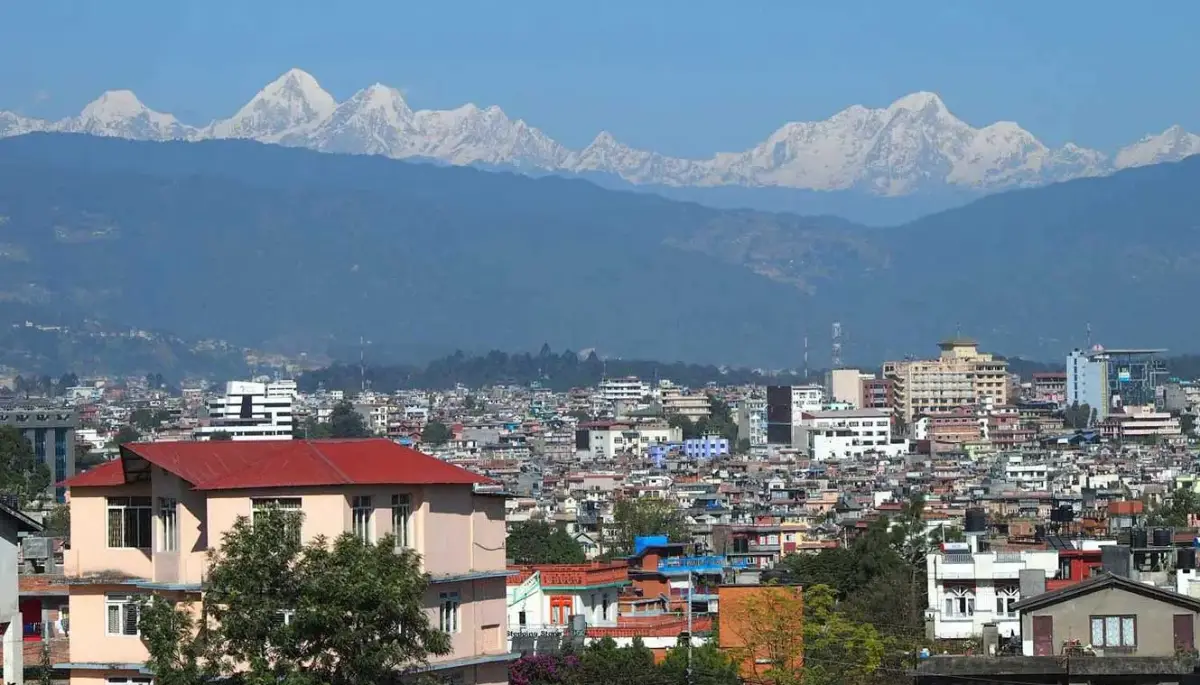
Fly to Lukla, Trek To Phakding | Enjoy A Scenic Flight Journey
- Altitude: Lukla - 2,850 m/ 9,350 ft | Phakding - 2,600 m/ 8,500 ft.
- Trek Distance: 9 km | 4-5 hrs.
- Altitude Gain: 1200 m/ 3,900 ft.
- Early morning flight to Lukla (30 minutes).
- Easy and gradual descent.
- Cheplung village lies en route from where you can see Mt. Khumbila.
- You can buy or refill your water bottles from teahouses on the way.
Get ready for a beautiful flight from kathmandu or ramechap to Lukla. Its a short flight of about 35 minutes that will take you over a panoramic landscape. On these flights, the planes are quite small but the journey is quite scenic. Our representatives will meet you at Lukla airport and this is where your trek towards Everest Base Camp starts.
After arriving at Lukla, we will start our trek towards Phakding after some refreshments. The trail is 9 km long and passes through Nepali mountain villages, green mountains, suspension bridges, and forests to Phakding. It takes about 4 to 5 hrs to complete the trek. From Lukla, the trek begins with a gradual ascent, with a few ups and downs along the way. Along the route, you will witness amazing views of Kusum-Kanguru as you cross a suspension bridge on your way. After a short climb, you will arrive at Ghat Village and after another one and a half hours of gradual walking, you will arrive at Phkading. En route, you will also spot boulders that are carved with Buddhist Prayers. We will stay overnight in Phakding.
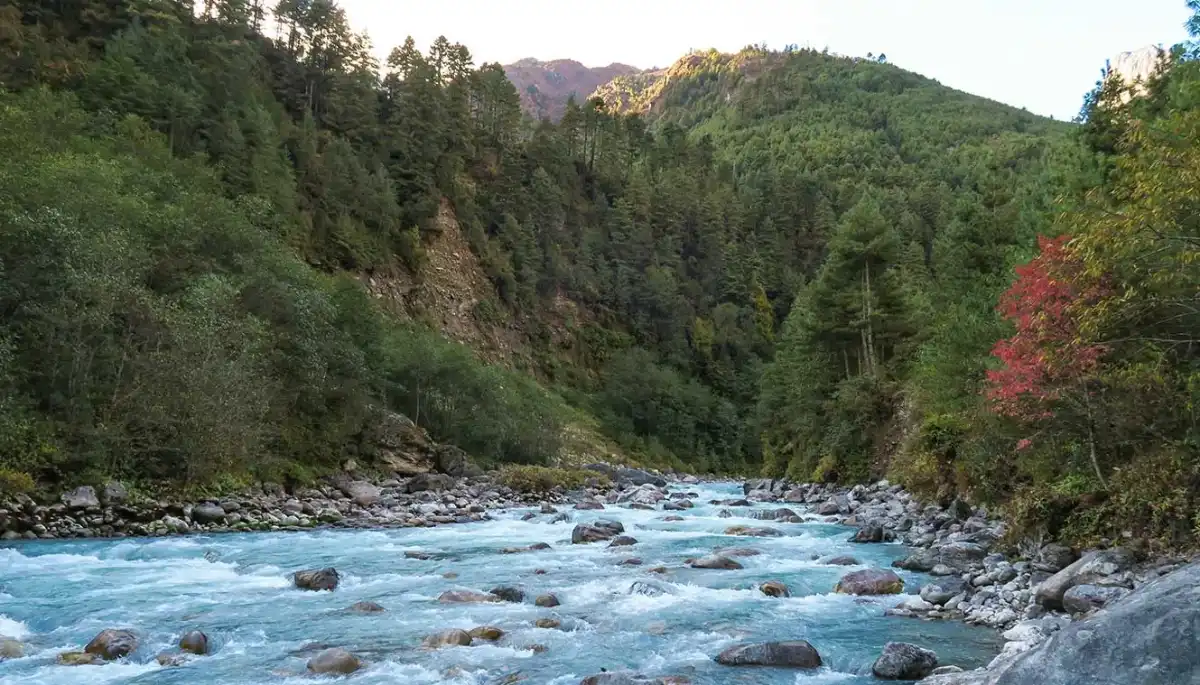
Phakding To Namche Bazaar | A Major Trading Hub In Khumbu
- Altitude: 3,450 m/ 11,300 ft
- Trek Distance: 10 km | 7 hrs.
- Altitude Gain: 850 m/ 2,800 ft.
- Moderate level of climb and steep climb before Namche Bazaar.
- Namche Bazaar is the capital of the Khumbu region.
- You will get the first views of Mt. Everest today.
- You will spot Kongderei and Thamserku Peak.
- Monjo village is the mid-point of the trek.
- A Swiss suspension bridge on the Dudhkosi River. It is one of the major attractions.
- Dudhkosi River is considered the lifeline of the Khumbu Region.
- Today you will enter the Sagarmatha National Park (a UNESCO World Heritage Site).
Post breakfast, we will start our trek toward Namche Bazaar. The route today is surrounded by green mountains and will take you through suspension bridges over the Dudh Koshi and Bhote Koshi rivers. Before entering the Sagarmatha National Park, you will have to obtain permits and then the trail follows a steep ascent before arriving at Namche Bazaar. Namche Bazaar is an important trading hub of the Khumbu region.
We will start our trek early in the morning from Phakding and soon you will cross a suspension bridge over the Dudh Koshi River, the walk from here is easy and pleasant with short uphill and downhill climbs. You will cross another suspension bridge over the Bhote-Koshi River. It is a busy area and you may notice a multitude of trekkers and porters here. After a 20-minute climb from this area, you will arrive at Monjo. Monjo is a pit stop for many trekkers and many people also camp here. At Monjo, you will see interesting watermills that are used to grind barley, a staple diet of the Sherpas. Monjo is situated right below the majestic Thermasarkhu peak (6,608 m) and quite close to this village is the entrance to the Sagarmatha National Park.
Treading along the Dudh Koshi River, you will arrive at the Sagarmatha National Park. At this point, your trekking permit will be checked and the officials will keep a record of all the trekkers going ahead. Sagarmatha is a UNESCO World Heritage Site that showcases stunning mountain views and rich biodiversity. Here, you may spot rare Himalayan species like snow leopards and the lesser panda. The presence of Sherpa settlements with their unique culture makes the trek even more interesting. A gradual walk from Sagarmatha National Park will lead you to Namche Bazaar. From Namche Bazaar, you will catch the first glimpses of Mt. Everest. Namche Bazaar is a historic trading center of the Khumbu area and you can stock up on essentials from this point. At night we will stay here at a guesthouse.
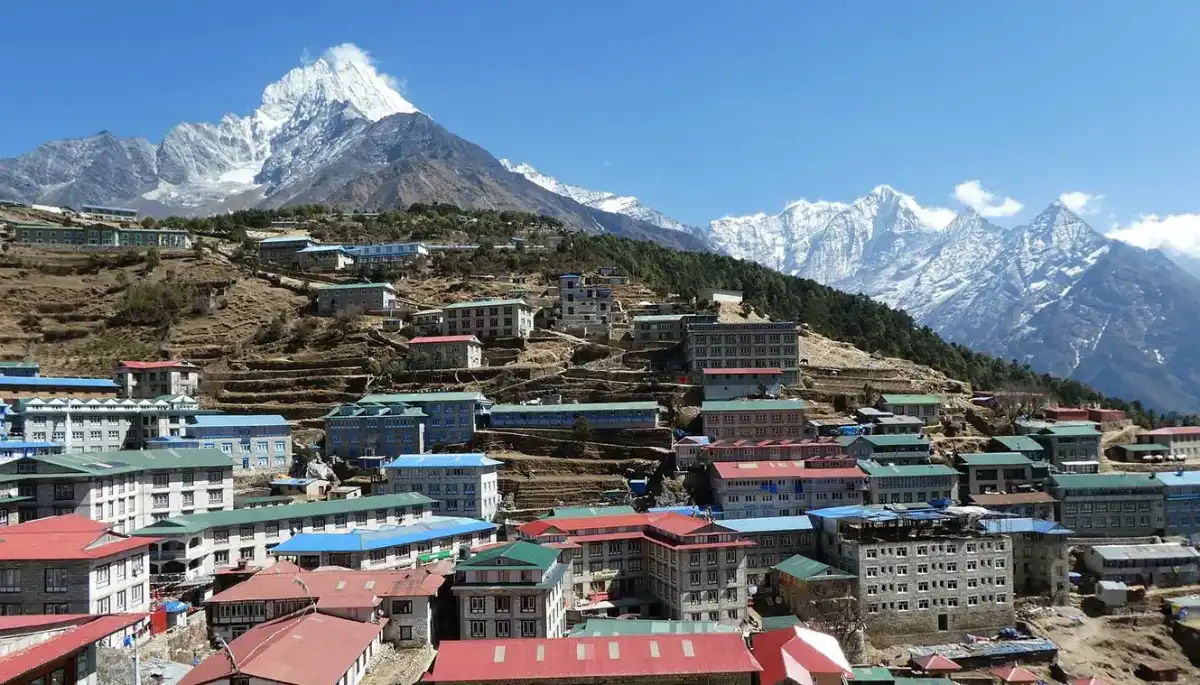
Acclimatization Day | Explore Namche Bazaar
Wake up to the beautiful views of the highest Himalayan peaks and enjoy a delicious breakfast. Today we will stay in Namche Bazaar allowing our bodies to acclimatize to high altitudes. You can spend the day exploring the surroundings and enjoy the culture and hospitality of Nepal. Namche Bazaar is a commercial hub so you can do any last-minute trek shopping from here. The market has a vibrant atmosphere and there are a couple of restaurants and coffee shops as well.
You can do a short hike to Sagarmatha National Park headquarters. From here, you can get a good view of Ama Dablam, Mt. Everest, and other Khumbu peaks. Sherpa Cultural Museum is close by and lies just above Namche Bazaar. The museum gives you a fair amount of details about the history of the Himalayas, the geographic and cultural aspects, mountaineering history, and information about the various flora and fauna in the region. You will see many pictures of Tenzing Norgay and Edmund Hillary from their climb and maps detailing their trails as well. In the evening, take acclimatization walks around the market, preparing your body for higher altitudes. Soak in the Nepalese Buddhist culture, food, and traditions. Namche Bazaar gained popularity during the time when Tibetan salt was traded for grains from Nepal\\s lowlands. Nowadays, you can see a roaring trade of rugs, clothing, dried meat, and salt in the village center. There are many shops that also offer locally made handicraft items, you can buy them as souvenirs or gifts for your friends and families. You will stay the night at a guesthouse in Namche Bazaar.
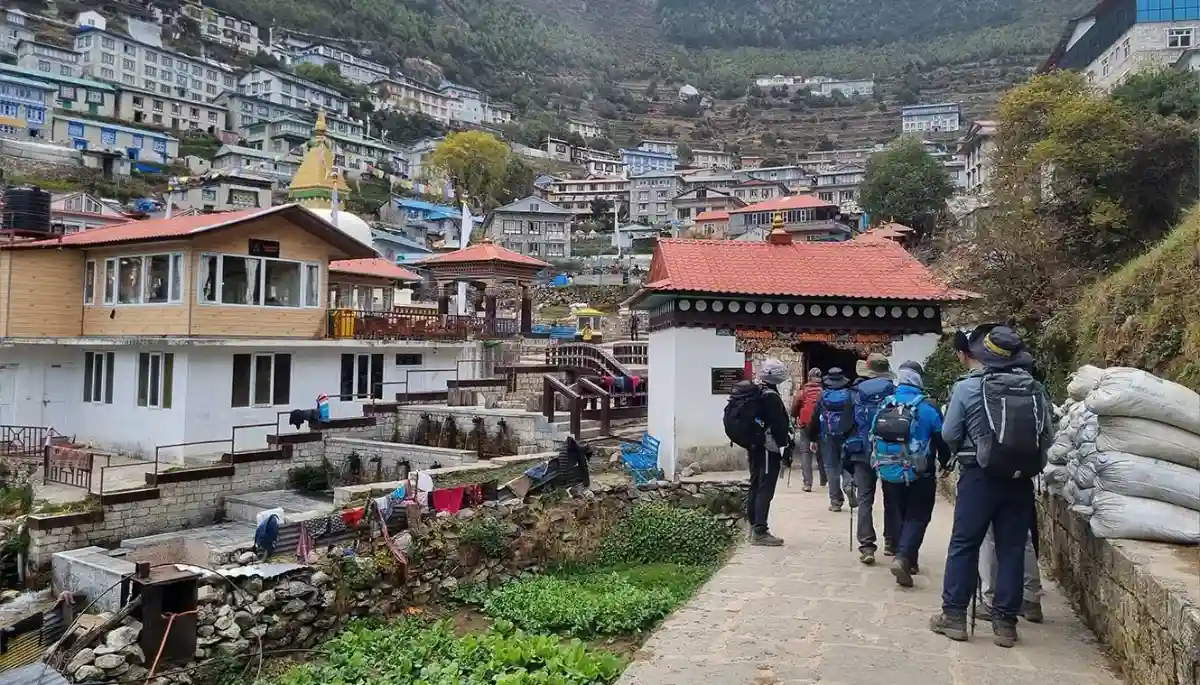
Namche Bazaar To Tengboche | Visit The Largest Buddhist Monastery Of Khumbu
- Altitude: 3,850 m/ 12,650 ft.
- Altitude Gain: 400 m/ 1,350 ft.
- Trek Distance: 8 km | 5 - 6 hrs.
- Mixed ascent till Phunki Tenga.
- Steep ascent after Phunki Tenga to Tengboche.
- Tengboche has the biggest monastery in the area.
- You can attend a prayer ceremony held by the monks to invoke protection on your expedition.
- Cross another high bridge at the village of Phunki Tenga.
Start your day with a delicious breakfast and get ready for your trek to Tengboche from Namche Bazaar. It’s an 8 km long trail and is a fairly easy trek accompanied by the views of the majestic Himalayas. You will also spot Himalayan Wildlife on the way as well.
Tengboche is a small alpine valley that is situated at an altitude of 3860 m and the trek starts with an easy walk. The trek from Namche Bazaar to Tengboche is extremely beautiful and along your trek, you will get a bird’s eye view of Dudh Koshi River down below and the epic mountain views as Thamserku (6,608 m), Kantega (6,782 m), Ama Dablam (6,812 m), Lhotse (8,516 m) and Everest (8,849 m) comes into view.
A 20-minute walk from Namche Bazaar will take you to the top of Namche Bazaar. From here the trek descends to Khumjung, a Sherpa village and then climbs up the sides of the mountains through some stairs and then diverges from the Everest Highway at Sanasa. You will be able to catch glimpses of Lhotse, Nuptse, and Mt. Everest from here. This is probably the best view of Mt. Everest you will get until you reach Gorakshep when climbing to Kala Patthar. Two hours of pleasant walking will bring you to Sanasa. Up to Sanasa, it is a walk-through forest covered with Oak and Rhododendrons. It is a great location for bird watching and you may spot the Danphe Pheasant, the national bird of Nepal. Musk-deer and Himalayan Tahr, a Himalayan goat that looks like an antelope are commonly spotted in these areas. You will also spot the Tengboche monastery from here which you will reach in the later part of your trek.
Next, following a gradual descent, you will reach the Imajtse River at Phungitenga at an altitude of 3,250 meters. Phunki Tenga is a small Himalayan settlement with teahouses and army posts. The climb down can be a little tougher as the terrain is rocky and uneven. You will reach a suspension bridge over the river and after you make the crossing, you will need to get permits at a checkpoint to proceed further in your trek. From here it is a strenuous climb of about an hour that will take you to a Buddhist monastery just before Tengboche and finally to Tengboche village. This is the last part of today’s trek and you can expect the trail to be rocky with a couple of switchbacks. Don’t push yourself too hard, take it slow and steady as you make your trek uphill.
Tengboche Monastery, locally known as Dawa Choling Gompa is the largest monastery in the Khumbu region. It overlooks the beautiful region and the mountain landscapes around it. There are daily prayers that occur around 7:00 am and once around 3:30 pm. You can take part in the prayers if you truly want a cultural experience. It is one of the important cultural aspects of the EBC Trek. Enjoy the serenity at this revered place of worship and night your stay will be in the guesthouses at Tengboche.
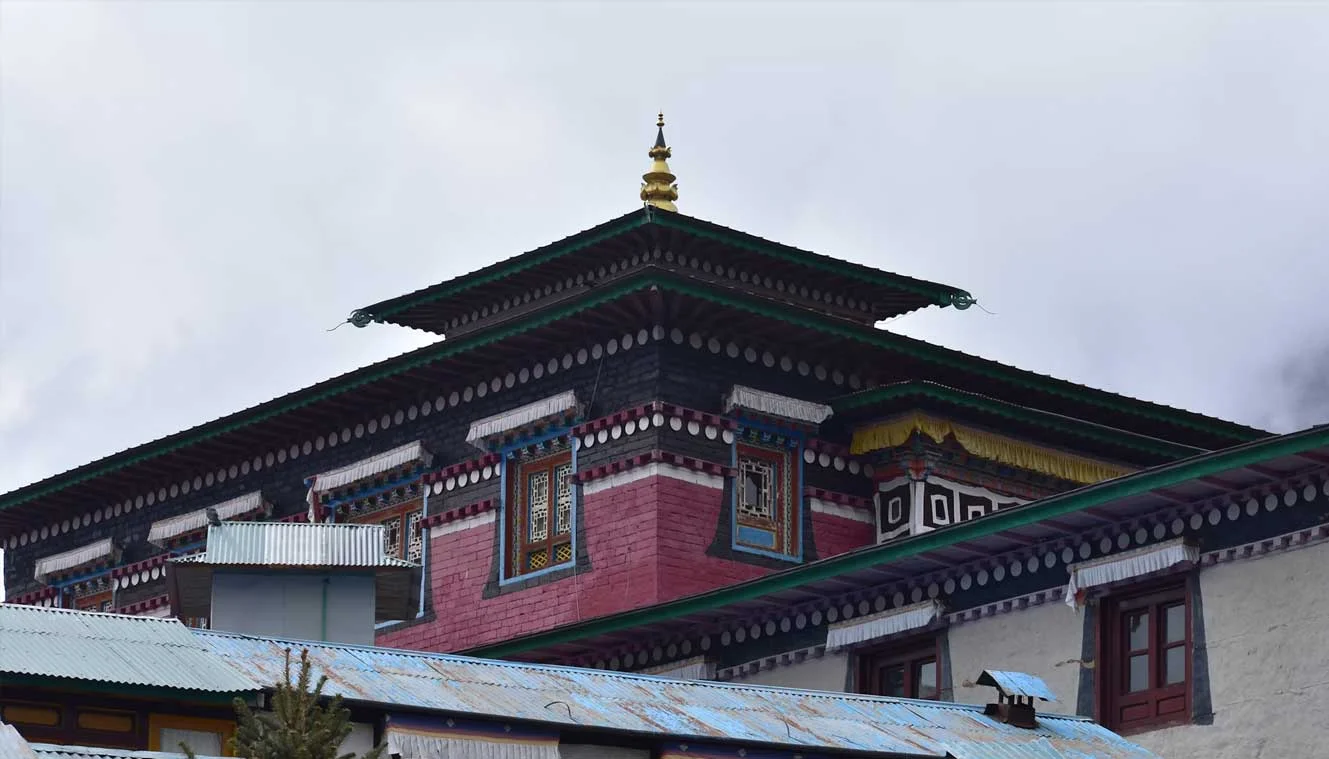
Tengboche To Dingboche | Stunning Views Of Ama Dablam
- Altitude: 4,350 m/ 14,250 ft.
- Altitude Gain: 500 m/ 1,600 ft.
- Trek Distance: 9 km | 6-7 hrs.
- Gradual descent and a little bit of ascent after Lobuche River to Dingboche.
- The trail passes through lush forests of birch, conifer, and Rhododendron trees.
- The route offers amazing views of Ama Dablam standing over you.
- The trail crosses the Imja River to reach Pangboche.
- Continue along the Imja Valley and Lobuche River before ascending to Dingboche.
Today, we will begin our trek towards Dingboche. From Tengboche, cross bridges and rivers accompanied by beautiful mountain views to Dingboche. Stone steps will lead you through forests of Rhododendrons, conifers, and birches, and at the bottom of the forest lies the Deboche village. From here, the trail rises and enters into the alpine meadows and Dingboche. Dingboche is the only place in the entire Khumbu region where barley is grown. The views of the Himalayas are amazing from Dingboche. Start your trek from Tengboche and walk towards Pangboche Village, you will get to see some beautiful views of Mt. Ama Dablam and from Pangboche we will trek towards Pheriche and to Imja Valley. The beautiful Lobuche River passes through Imja Valley and from here a steep hike will take you to Dingboche. The trek takes about 6 to 7 hrs and for the most part, the difficulty is moderate.
At the beginning of the trail, you will first descend into a forest trail passing the small settlement of Deboche. As you trek from Tengboche to Dingboche, the scenery changes as you gain altitude, greenery slowly giving way to barren landscapes, and the trails gradually becoming more rugged and it will also start getting cold and windy. In the initial part of the trek, you will pass by a wall with stone inscriptions and a small stream will keep you company along the trail. You will have to cross the stream to the left-hand side of the valley. The majestic Ama Dablam dominates the skyline ahead of you. About two hours into the trek, you will arrive at Pangboche, a mountain village, where you get beautiful views of Mt. Everest. From Pangboche, you will hike upwards towards the valley, and throughout the trek, you will slowly gain elevation. Although the trek is mostly uphill, the slope is relatively easy without extremely steep inclines. Ama Dablam continues to stay in view, however, you will only get to see a tiny sliver of the top of Mt. Everest. Lhotse and Nuptse become quite prominent now.
Soon you will arrive at the village of Shomare, your last village before Dingboche. Ama Dablam remains in view but now you will get to see a different angle of the mountain from what you have seen before. The trail continues winding to the valley side and you will cross another river before entering Dingboche village. Dingboche is a lovely Himalayan hamlet and you will see agricultural fields protected by stone walls. Once at the village, we will check into a guesthouse and we will stay the night in the guesthouse.
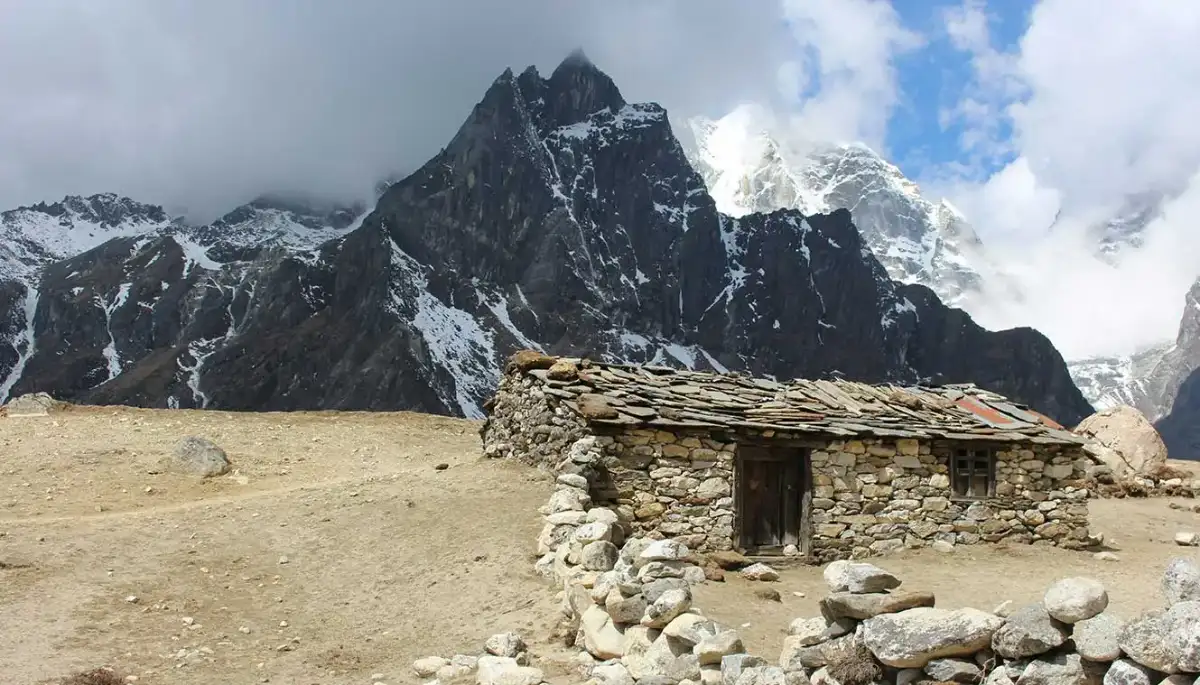
Dingboche (Rest Day) | Acclimatize To Higher Altitudes
Today is a rest day at Dingboche, which will help us acclimatize to the high altitude. As we exert a good deal of energy on the trek, our body needs to get accustomed to less oxygen at higher elevations. So instead of taking a rest day, if continue to gain elevation it can result in altitude sicknesses like dizziness, nausea, and headache or potentially even more dangerous conditions like cerebral or pulmonary edema. To prevent these issues, we start our acclimatization process at the 11,500 ft mark. Since Namche Bazaar is quite near that elevation, we start our acclimatization process from Namche Bazaar itself.
For acclimatization, you can walk around the village. Dingboche village has many farms and crop fields sparse across the village, native crops include barley, potatoes, and buckwheat. You can also do a short hike around the village to Chukung. Its a 3 - 5 hrs trek that takes you to an altitude of 4,730 m. Chukung lies in the Imjatse Valley towards the east. Although the trek is gradual you can feel the effects of thinning air. Chukung has a couple of teahouses as well and you get a superb view of the surrounding areas from here. Some of the views are exceptionally beautiful as you continue to climb higher and higher. Explore the valley and the surrounding areas, return back to the guesthouse. This hike will prepare your body for the next few days at higher altitudes.
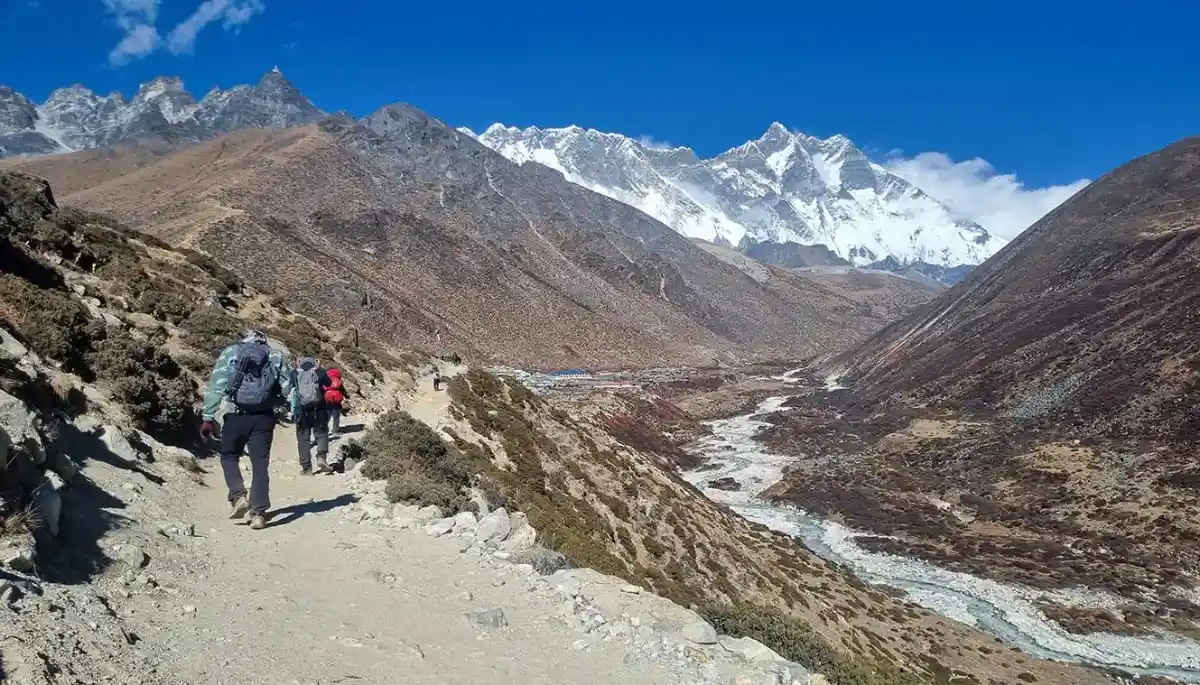
Dingboche To Lobuche | Pay Your Respects In Everest Memorial
- Altitude: 4,950 m/ 16,200 ft.
- Trek Distance: 7 km | Duration: 6 hrs.
- Altitude Gain: 600 m/ 1,950 ft.
- Tricky climb on moraine and rocky terrain.
- You can visit the memorial shrine.
- The top of the ridge is filled with prayer flags and stones which are memorial shrines for climbers who lost their lives on Mt. Everest.
- As you cross Khumbu Glacier, you will see Mt. Nuptse (7,861 m).
Today’s walk will take you from Dingboche to Lobuche through alpine pastures and in the summertime, you can see Yaks grazing in these pastures. You will trek towards the end of the moraine of the Khumbu Glacier offering spectacular views of Mt. Nuptse. At the moraine, you will see stone monuments, these are dedicated to six Sherpas who died in an avalanche along with monuments dedicated to other mountaineers. From here, it’s a steep climb towards Lobuche where you will get a magnificent view of Mt. Nuptse and the sunset over this mountain peak is even more spectacular. From Dingboche, you will have to ascend a small ridge behind the village, towards the north you can see Lobuche Peak (6119 m) and the snowfields of Cho La. Later you will cross Khumbu Khola, the huge glacier moraines of the Khumbu Glacier flowing from Everest. Crossing the memorial cairns, and following the valley stream, you will arrive at Lobuche in the early afternoon. The 6 hrs trek covers 7 km and brings us much closer to the Everest Base Camp.
Start the hike from Dingboche along the inclined path running alongside the mountain’s wall and go further into the valley. As you make your turn along the path and inside the valley, you arrive at the village of Pheriche, we will be staying here on our way back from the base camp. For the next 2 to 2.5 hrs, you will follow into the valley, while the incline is not very difficult but you are at a high altitude, so take it slow and steady and avoid using too much energy too quickly. A river lies in front of you and crossing the river, you will arrive at the village of Thukla. This is a great spot to rest for a couple of minutes, refuel yourself and continue on the trek.
The next part is going to be the toughest part of the trek today as you climb to Lobuche. The climb takes you along a zig-zag path all the way to the Thukla Pass and it becomes steeper and steeper as you climb until you reach the edge of the Khumbu Glacier and the Everest Memorial. The oxygen gets less and less from here and the temperature also starts to get lower. The remaining part of the trek follows the left side of the glacier as you reach the village of Lobuche and you will also gain a little elevation from the glacier as you arrive at Lobuche. In front of you, you get to see a beautiful view of Nuptse in front of you. Lobuche is a small Himalayan village with only a handful of teahouses. We will stay the night here before we head out to the last village on the trek tomorrow.
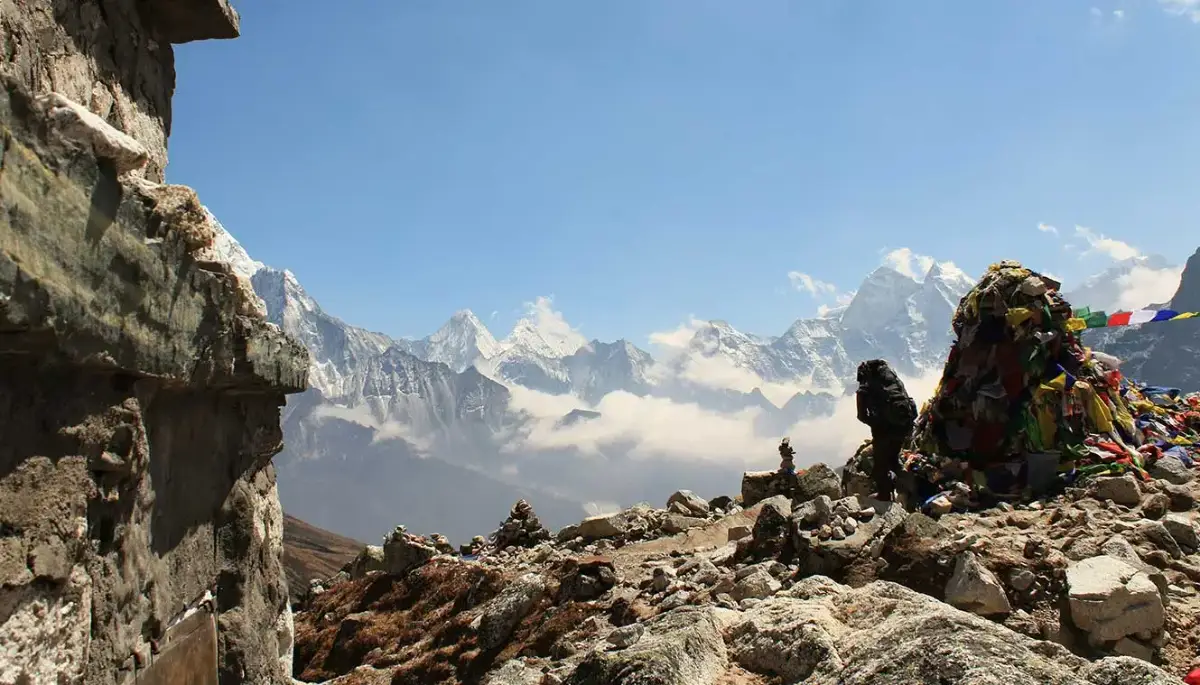
Lobuche To Gorkhashep | Excursion To Everest Base Camp
- Altitude: Gorakshep - 5,150 m/ 16,900 ft | Everest Base camp - 5,350 m/ 17,700 ft.
- Altitude Gain: 200 m/ 800 ft.
- Lobuche To Gorakshep : 6 km | 3-4 hrs.
- Gorakshep To EBC : 3 km away each | 3hrs.
- It’s Everest Base Camp Day Today.
- Good steep climb to Gorakshep.
- It takes about 3 to 4 hrs to reach Gorakshep.
- Lunch is at Gorak Shep.
- A steeper climb to Everest Base Camp.
- The trek to Everest Base Camp is not very difficult.
- Trekker's stop point is just below the actual base camp.
- Most tour groups are not allowed to enter or stay in EBC.
- Make sure you carry your day pack since you will need water.
- You can enjoy amazing views of Nuptse, Khumbutse, and Pumori mountains from the base camp.
- Overnight stay in Gorakshep.
Note: Drinking water in Gorakshep is chargeable. We don’t include drinking water on the trek which you can buy from a number of places between $1 to $3 a bottle (it gets more expensive towards the base camp). The better alternative is to buy water tablets in Kathmandu/Pokhara for around $2 and treat the water.
Today is the most exciting day of the trek as you make an excursion to the Everest Base Camp. An adventurous journey and a great trekking experience await you. Waking up early, have your breakfast, and gear yourself up. We will follow the trail from Lobuche through narrow gaps in the mountains and glacial moraines along the Khumbu glacier to Gorak Shep, the last village on the trek. Post lunch in Gorak Shep, we begin our trek to the Everest Base Camp, the ultimate adventure of this entire journey. We follow the lead of Sherpas as the trail changes every season as the glaciers move. It takes about 7 hrs of walking to reach Everest Base Camp. Spend some time at the base camp, celebrate your victory, capture some stills, and descend back to Gorakshep. Overnight stay will be at Gorakshep.
The trek today can be broken down into two parts, the first part is the trek from Lobuche to Gorakshep and the second part is an excursion to EBC and back to Gorakshep. After breakfast at Lobuche campsite, we begin our trek towards Gorakshep. It is a 6 km hike that takes about 4 hrs. Walking along the sandy and rocky parts, you will gradually gain elevation as you walk alongside the Khumbu Glacier. Mt. Nuptse looms on the horizon in front of you. Some sections of the trail are a little steeper than others. On the way, you will pass Sherpa flag monuments indicating that you are getting closer to the Everest Base Camp.
The last section of the trail directs into a glacier before you reach Gorak Shep. the terrain is rocky and uneven with inclines and declines. Be cautious and watch your step in this part and always pay heed to the trek leader's advice to complete the patch safely. You can see a sliver of the top of Mt. Everest from here, right behind Nuptse. Soon the village of Gorak Shep comes into view guarded by Kala Patthar and Pumori in the back. Make your way into the guest house have some lunch, reenergize yourself and get ready for the next part of the trek.
From Gorak Shep, you will walk right along the Khumbu Glacier, the Everest Range lies right behind it. It is a vast glacier and as you continue walking along the side of the glacier, you will constantly gain elevation until you reach the base camp. The incline is not very steep and is slightly moderate. A technical terrain lays ahead of you with a mixture of sand and rocks and it can get pretty slippery at some points as well. As long as you watch your steps, you will be good. Continue on and you will reach a point where the Khumbu icefall comes into better view as it winds down from the mountain to the valley. More Sherpa prayer flags mark the way to the base camp. In the final stretch of the trail, you will see numerous prayer flags flowing in the wind and the popular Everest Base Camp Rock. You have made it to the Base Camp, congratulations! While this is not the actual base camp, it is a trekker’s base camp. Most tour groups are not allowed to enter or stay in EBC. Once you have had enough time to enjoy the area around EBC, it is time to head back to Gorakshep. Follow the rocky trail back to Gorak Shep. We will stay the night in Gorak Shep.
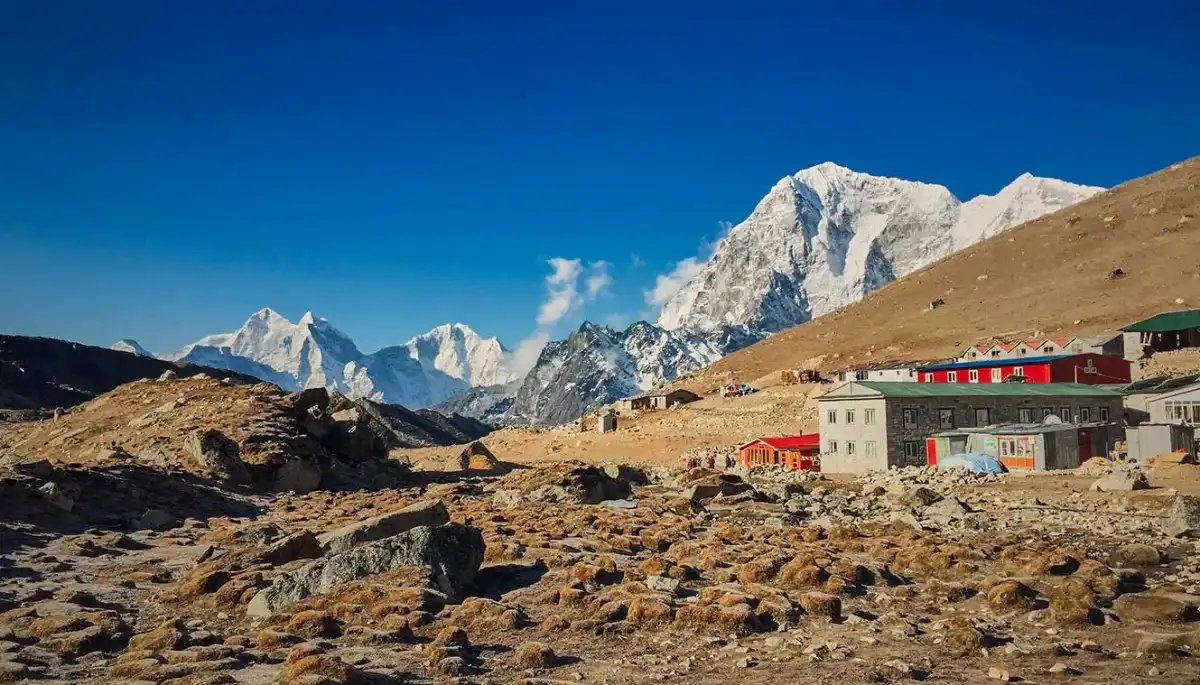
Hike To Kalapatthar And Retreat Trek To Pangboche | Enjoy Arresting Views Of Mt. Everest
- Altitude: Kalapatthar - 5,550 m/ 18,200 ft | Pangboche - 4,000 m/ 13,100 ft.
- Gorakshep To Kalapatthar: 2 km each way | 3 - 4 hrs.
- Gorakshep To Pangboche: 18 km | 6-7 hrs.
- Altitude Loss: 1,150 m/ 3,800 ft
- Steep climb to Kalapatthar (difficult).
- Gradual descent to Pangboche.
- Start early in the morning to avoid early morning clouds.
- Kala Patthar is the rocky hilltop below Pumori.
- Views from the summit: Everest, South Col, Lhotse, Makalu, Khumbu Glacier & icefall, Pumori & Everest Base Camp.
- Breakfast at Gorakshep after the Kalapatthar hike.
After your trek to EBC and back to Gorakshep, you are now ready to climb Kala Patthar. Gorakshep is also a good place to roam around, it has a couple of teahouses and it also used to be the base camp for climbing Mt. Everest in the 1950s. The trek starts with an easy walk from Gorakshep and you will be walking on sandy fields. After this, there is a steep climb of 45 minutes. After the strenuous climb, you will come to level fields and the walk is easy and gradual. You will have the comfort of walking for the next one hour, post which there is another steep climb to Kalapatthar for about half an hour. Mt. Everest from this point looks closer than you can imagine. From here, you will trek down to Pangboche.
Start your day early and leave your stuff at Gorakshep, only carry a daypack with the essentials as you will return to Gorakshep. As you cross the sandy trail and begin ascending, you will notice the Gorakshep village and Khumbu Glacier behind you including Ama Dablam. The top of Mt. Everest begins to peek out above the surrounding mountain ranges. The more you gain altitude the more Mt. Everest will come into view. The best part of today’s trek is that all along the trek you can enjoy the landscape of the surroundings and not just on the summit. The higher you get, the rockier and trickier the trail gets. Be mindful and watch your steps. The last patch is especially rocky.
The summit is a little difficult to navigate as well. You will know you are near the summit when the Sherpa prayer flags and weather reading device come into view. Take your time and dont rush to the summit to avoid any accidents. Once you reach the summit, you will get to see the breathtaking views of the entire Sagarmatha National Park but the main attraction is of course Mt. Everest itself. You will get the best view of Mt. Everest from here. Below Everest lies the Khumbu icefall that feeds into the Khumbu Glacier and to the right is the face of Mt. Nuptse. On the opposite side of the lake, you will see even more glaciers, lakes, and mountains, as far as your eyes can see. After spending some time at the top, descend the same path that you came in. When you are back in Gorakshep have a nice meal and refuel yourself as we will descend to Pangboche.
On the trek down, the first village will be Lobuche and throughout the trek, you will again be alongside the Khumbu Glacier. You have already completed this section while ascending up so you now have an idea of what to expect. The trek is a little tricky till Sagarmatha National Park sprawls out in front of you and the rest of the part is manageable. You can have some snacks at Lobuche before heading down to Pangboche.
As you descend, you will come to the intersection where one path diverges towards Dzonghla village, Cho la pass, and Gyoko Ri, and the one on the left heads towards Pangboche. Stay on the left side of the trail and you will come across another difficult patch of the trek. You will head down from the moraine wall of the Khumbu Glacier and descend to the Thukla Pass. Crossing the Everest Memorial, begin a tricky hike down to the river below and soon you will arrive at Pangboche.
Pheriche lies just below Dingboche so after crossing Thukla, you can take the lower path towards Pheriche instead of taking the higher path towards Dingboche. Once we arrive at Pangboche, you will check into a teahouse, have your dinner, and rest for the night before heading down to Namche Bazaar the next day.
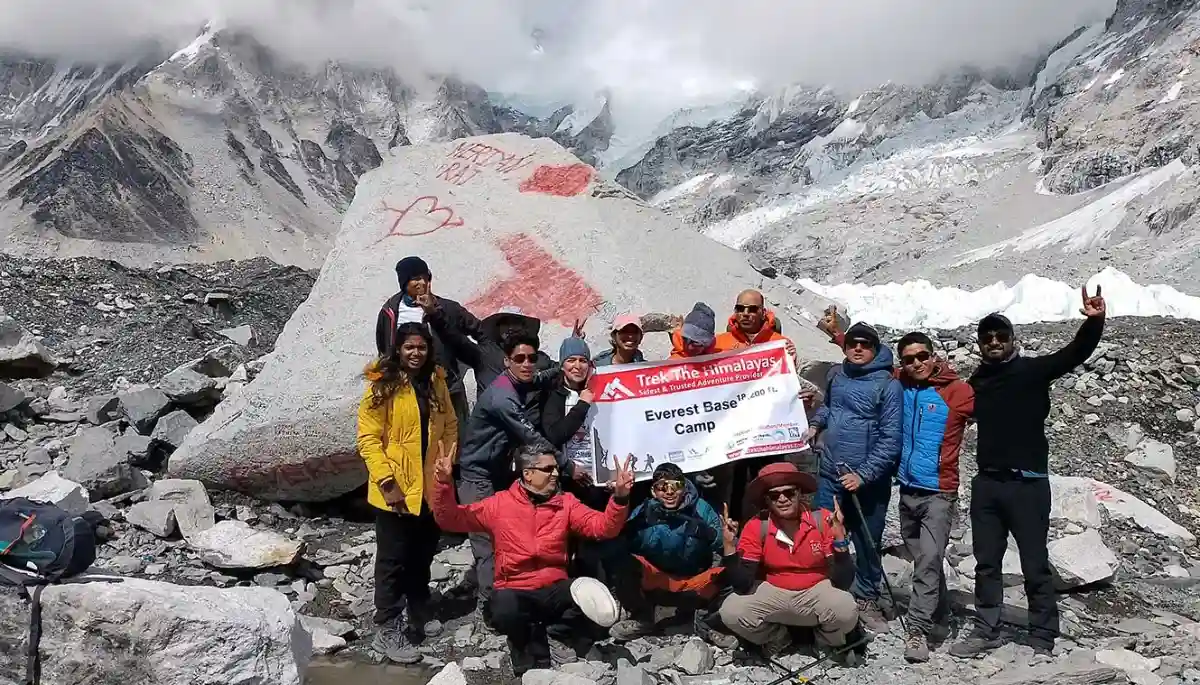
Pangboche To Namche Bazaar | Buy Some Souvenirs
- Altitude: 3,450 m/ 11,300 ft.
- Trek Distance: 12 km | 6 - 7 hrs.
- Altitude Loss: 550 m/ 1,800 ft.
- Moderately, continuous descent and short ascent just before Namche Bazaar.
After your descent to Namche Bazaar, the cumbersome part of the trekking is almost over. From here on the descent will be easy after having the Everest Base Camp trek. But we recommend starting early as it is a long walk. Start the journey by heading down to the village, across the river, and again climbing back up the valley wall. You can rest here for some time, and catch your breath before resuming your decline down the valley.
Once you have declined the path, you will cross a suspension bridge followed by a 2 km incline along the valley wall. As you zig-zag up towards the trail, it becomes forested and once you have completed the uphill ascent, it is a fairly smooth walk for the remaining 5 km to Namche Bazaar. The path to Namche Bazaar is etched on a valley wall and there’s the river below. Soon the path bends inwards and you are welcomed with views of Namche Bazaar. Descend down to the village below and check into a teahouse. Rest well. Tomorrow will be the last day of your trek.
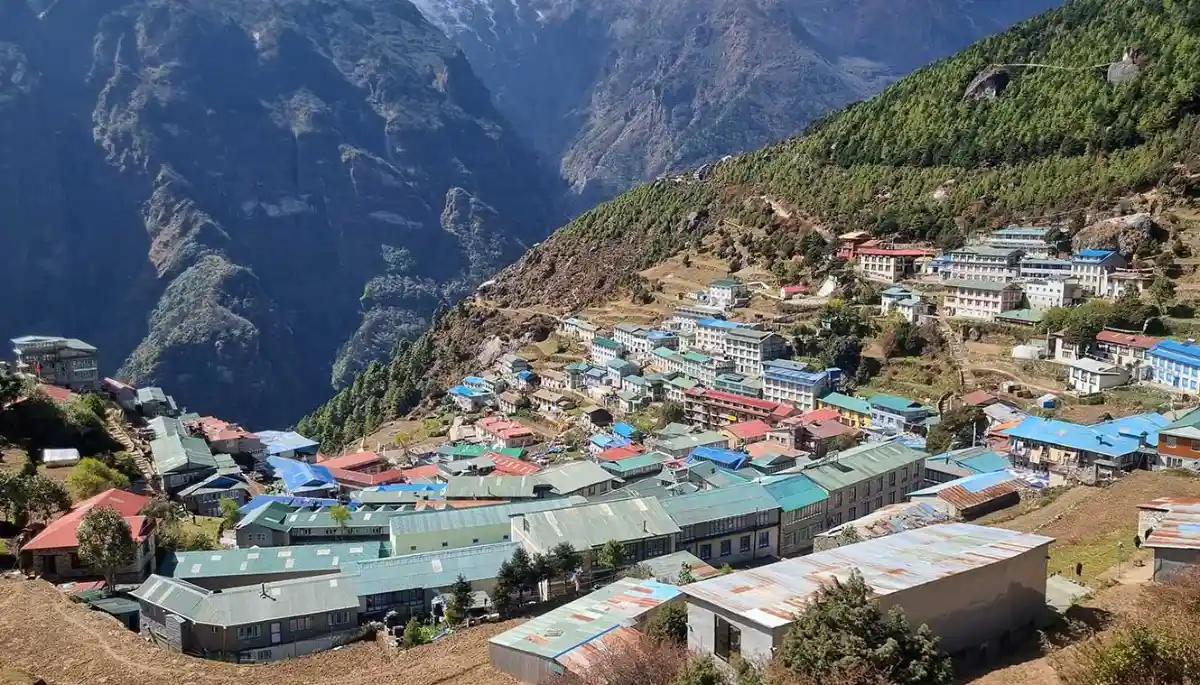
Namche Bazaar To Phakding To Lukla | Last Day Of Trekking
- Altitude: Phakding - 2,600 m/ 8,500 ft, Lukla - 2,850 m/ 9,350 ft.
- Altitude Loss: 600 m/ 1,950 ft.
- Trek Distance: 19 km | 7 - 8 hrs.
- Moderate, continuous descent till Phkading and gradual ascent to Lukla.
- Start your trek early in the morning as it is a long day trek.
- Stop at Phakding for lunch.
- Stay in Lukla.
Waking up to the lovely weather at Namche Bazaar, you can visit the place and roam around a little bit. You can explore the market and buy souvenirs from your trip to the Everest Base Camp and buy gifts for your friends and family. There are several local handicraft stores in Namche Bazaar as it is the biggest trade hub in the Khumbu region. You can also take a small walk-in around the Sagarmatha National Park and enjoy the local cuisine as well. Post which treks down to Phakding, it is an easy trek down to the village. The beauty of the distant mountains with several waterfalls adds to the beauty of your journey. This is the beauty of Nepal trekking, there will be a few uphill climbs but you will manage it very easily. The lush green beauty and forests will take your pain away. After this easy walk, you will reach Lukla. This will be your last day with the Sherpas and other crew members, so you would like to enjoy the day with a delicious dinner and a few drinks.
Right at the beginning of the trek, you will begin to lose elevation, after about 45 minutes of walking, you will arrive at a rest stop, the same that you came in on when ascending towards the basecamp. This is where you will get the last glimpses of Mt. Everest. After this point, there are no mountain views anymore only little peeks from behind the forest covers. You will cross a few suspension bridges and continue alongside the river as the initial steep decline eases into a more moderate decline. While most of the trek is downhill, there are a few uphill climbs as well. Pass by Sherpa stones into the village of Phakding. You are more than halfway to Lukla by now. We will stop at Phakding for lunch before descending further down the valley with river views, mountain ridges, and suspension bridges. You will also have several stair sections and an incline path all the way through. Passing by a few more villages, you will arrive at Lukla, your final stop for the day.
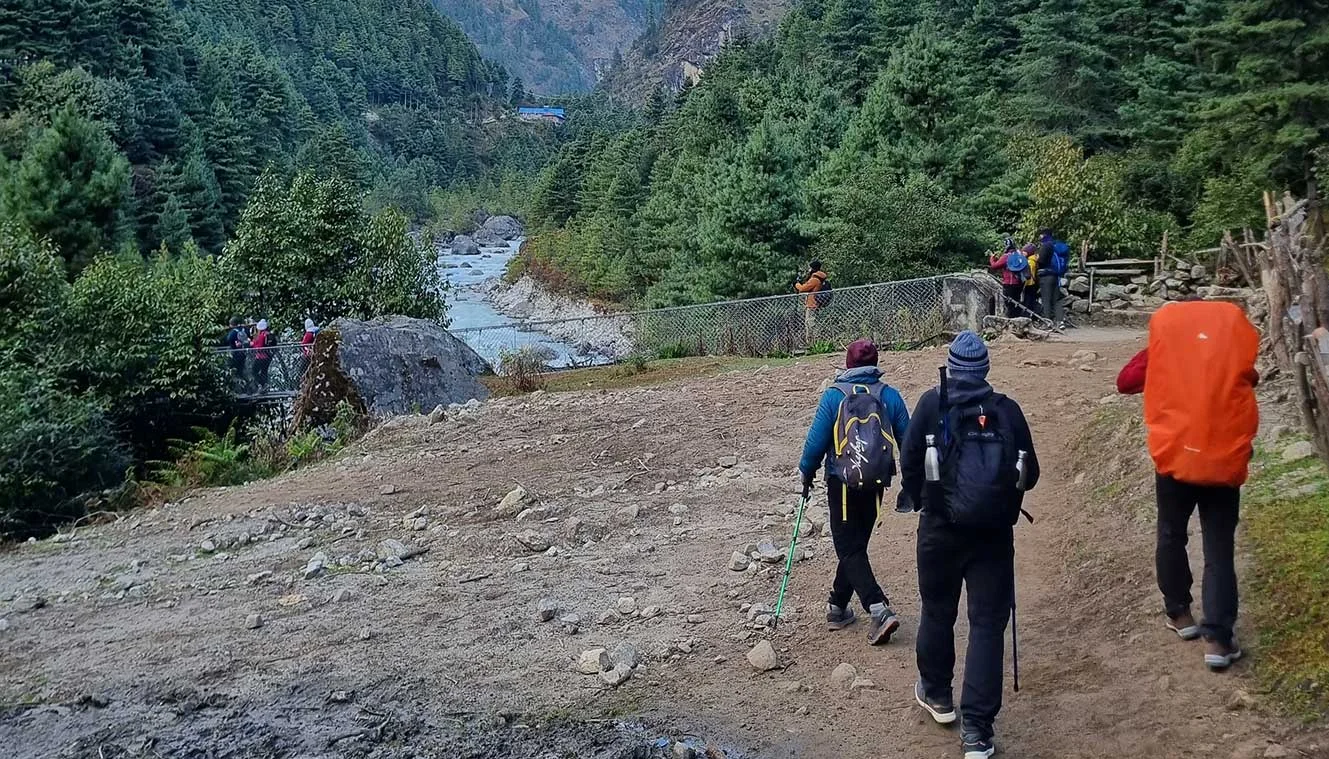
Fly Back To Kathmandu | Bid Adieu To The Mountains
- Morning flight to Kathmandu.
- Your trek to Everest Base Camp is over.
- Spend the day in Kathmandu or fly back to your onwards destination.
- Hotel accommodation in Kathmandu is included in the cost.
Note: Weather conditions may cause flight cancellations. Delays are possible any time of the year but are more typical on summer departures. Keep one or two buffer days.
Today you will have to wake up early as flights to Kathmandu are generally scheduled in the morning. This is because during the daytime, the weather is generally windy and there might be a delay in the flight timings. However, you can expect a slight delay in your early morning flight as well if the weather is not suitable. As you make your way through the security checks and your flight takes off from Lukla airport, you will have a magnanimous view of the surroundings. Drive back to Kathmandu from Ramechhap Airport and overnight stay in a hotel. You can book your further journey from here. We wish you a great journey towards your home with lots of memories.
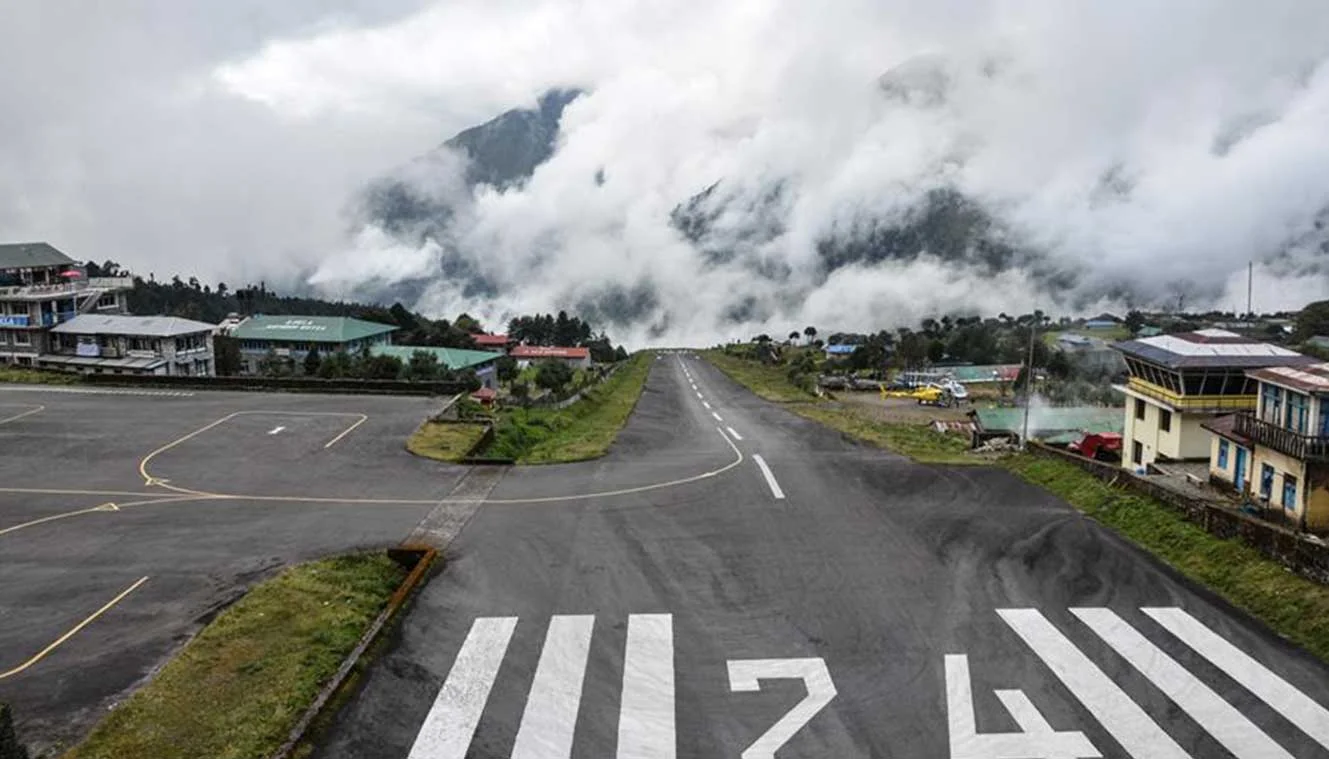
Day-1: Arrive At Kathmandu
Day-2: fly to lukla, trek to phakding | enjoy a scenic flight journey.
- Altitude : Lukla - 2,850 m/ 9,350 ft | Phakding: - 2,600 m/ 8,500 ft.
Note: Flights to Lukla are prone to delay due to weather, keep one or two buffer days in your plan.
Day-3: Phakding To Namche Bazaar | A Major Trading Hub In Khumbu
- Trek Distance: 10 km | 7 hrs.
Day-4: Acclimatization Day | Explore Namche Bazaar
- Today is acclimatization day.
- You can hike up to Sherpa Cultural Museum to get a view of Everest and Ama Dablam.
- It’s worth exploring the town, a good place to buy trekking gear.
- ATMs, internet cafes, shops, and restaurants are available at extra cost.
- Stay in the guesthouse.
Day-5: Namche Bazaar To Tengboche | Visit The Largest Buddhist Monastery Of Khumbu
Day-6: tengboche to dingboche | stunning views of ama dablam, day-7: dingboche (rest day) | acclimatize to higher altitudes.
- Rest Day helps you acclimatize well to high altitudes.
- A small hike today will show you the world’s six tallest peaks including Lhotse (8,516 m), Makalu (8,463 m), and Cho Oyu (8,188 m).
- From another location, you can see the Imja Khola Valley and Dingboche Valley.
Day-8: Dingboche To Lobuche | Pay Your Respects In Everest Memorial
- Trek Distance: 7 km | 6 hrs.
Day-9: Lobuche To Gorkhashep | Excursion To Everest Base Camp
- Gorakshep To EBC : 3 km each way | 3hrs.
Day-10: Hike To Kalapatthar And Retreat Trek To Pangboche | Enjoy Arresting Views Of Mt. Everest
Day-11: pangboche to namche bazaar | buy some souvenirs, day-12: namche bazaar to phakding to lukla | last day of trekking.
- Altitude: Phakding - 2,600 m/ 8,500 ft | Lukla - 2,850 m/ 9,350 ft.
Day-13: Fly Back To Kathmandu | Bid Adieu To The Mountains
Note: Weather conditions may cause flight cancellations. Delays are possible any time of the year but are more typical on summer departures. Keep one or two buffer days.
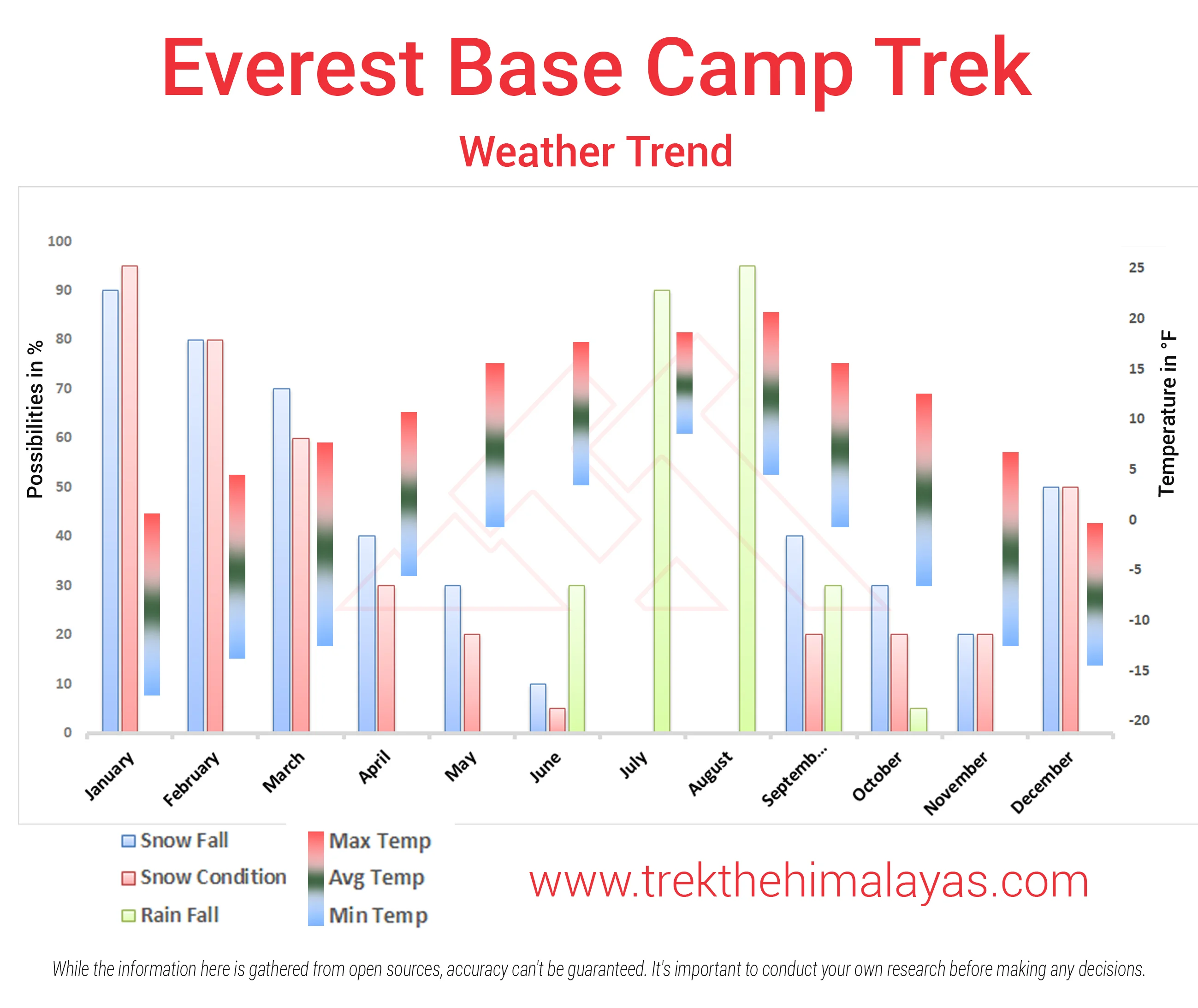
Pulse rate at rest must be in between (60 to 90 beats per minute).
Blood Pressure Reading must be in between (DIASTOLIC 70 – 90, SYSTOLIC 100 - 140 mm Hg).
Respiratory rate at rest must be in between (12 to 20 breaths per minute).
Should not have Liver and kidney issues.
Should not have Diabetes Mellitus, Bronchial Asthma, Heart problems, Hypertension, etc.
No pacemaker implant.
People with Sinus issues, Epilepsy please contact to trek coordinator before booking the trek.
If your BMI is not normal, Please contact our Trek coordinator before Trek booking.
Medical & Disclaimer Form (Mandatory Documents) Click here to download Medical & Disclaimer Form
- Government Employees can avail the benefit of Special Casual Leave (SCL) when they join us for a trekking expedition. As per the rules of the Pay Commission, Special Casual Leave can be availed for up to 30 days in a calendar year for trekking/mountaineering expeditions through a registered organization. Trek The Himalayas is a registered adventure tour operator by the Indian Mountaineering Foundation (IMF) and the Ministry Of Tourism (MOT).
- Trekkers have to apply for leave at least 20 days before the trek departure date.
- This service is exclusive to Indian government employees and is applicable only for treks within India.
- Do mail at info@trekthehimalayas to apply and mention your booked trek date and trek name.
Junior trekkers (below 15 years) should have a company of parents/guardians.
Trekkers between 15 to 18 years can come solo with the disclaimer form signed by parent/guardian.
- Medical & Disclaimer Form (Mandatory Documents) Click here to download Medical & Disclaimer Form
Exercise For Difficult
Fitness Regime For:
Calculate Your Bmi
Your BMI value is
Congratulations, your body is in good conditions!
Medical & Disclaimer Form (Mandatory Documents) Click Here.
How To Reach
Pick-up information.
- It is essential for everyone to arrive at Kathmandu (1:00 pm).
- Upon booking the trek, you are required to come to our hotel. Your trek coordinator will provide you with details such as the name of the Kathmandu hotel, its location, and the contact person's number.
Options to Reach Kathmandu
The best way is to fly to Kathmandu Tribhuvan International Airport, which receives airlines mostly from South-east Asia and Europe. A number of direct flights fly from Delhi, Mumbai, Kolkata, Bangalore and Varanasi to Kathmandu. Popular airlines that operate regularly are Jet Airways, Air India, IndiGo and Nepal Airlines.
Delhi to Kathmandu by train + bus
- Day 1: Take a train from Delhi to Gorakhpur. The Vaishali Express leaves Delhi at around 19:45 and arrives at Gorakhpur Junction at 09:10 next morning, or there's another train from New Delhi at 17:20 arriving Gorakhpur at 06:35 next morning. The fare is around Rs. 2440 (£35 or $54) in AC1, Rs. 1240 (£18 or $27) in AC2, Rs. 785 (£12 or $18) in AC3 or Rs. 315 in Sleeper Class - check current times and fares at www.indianrail.gov.in or www.irctc.co.in.
- Day 2: Take a bus or jeep from Gorakhpur to the Nepalese frontier at Sunauli (Indian side) and Bhairawa (Nepalese side, often also called Sunauli). Journey time about 3 hours, Rs. 55 (£1 or $2).
3. Walk across the frontier, it's then a few minutes’ walk to the Bhairawa bus station. Take a bus or jeep on to Kathmandu. Buses take 9 to 12 hours, cost about 120 Nepalese Rupees or 230 Indian Rupees (£1 or $2). There are many buses daily, either daytime buses leaving regularly until about 11:00 or overnight buses leaving regularly from about 16:00 until 19:00. Indian rupees may be accepted here in Bhairawa, but not further into Nepal.
4. It's also possible to travel via Varanasi An overnight train links Delhi & Varanasi. Buses link Varanasi with the Nepalese border.
Drop-Off Information
- For your return journey from Kathmandu, you have the flexibility to choose between road or air transport options. Please note that our services extend only to the hotel, and the standard hotel check-out time is 11:00 am.

1. Accommodation (as per the itinerary):
- Day 1 and Day 13 Hotel Accommodation in 3 Star Hotel in Kathmandu with Bed & Breakfast.
- Day 2 to Day 12 Accommodation in Teahouse.
2. Meals (Veg + Egg):
- All meals Lukla to Lukla from Day 2 Lunch to Day 13 Breakfast
- Fresh fruit after dinner every day.
3. Support:
- 1 Versatile base camp manager handles communication and deploys extra manpower in emergencies.
- 1 Mountaineering & First aid qualified professional trek Leader.
- Local experienced guides (Number of guides depending on the group size).
- Enough support staff.
4. Trek equipment:
- Sleeping bag.
- Gaiters & Crampon (if required).
5. First aid:
- Medical kit, Stretcher, Oxygen cylinder, Blood pressure monitor, Oximeter, Stethoscope.
6. Transportation (as per the itinerary):
- Arrival Departure Airport Transfer as per itinerary.
- Domestic airport transfers for Lukla.
- Kathmandu to Ramecchap /Lukla, and back.
7. Mules/porters to carry the central luggage. 8. Clock room facility available at the base camp for additional luggage. 9. All necessary permits and entry fees, up to the amount charged for Indian. 10. Services from Kathmandu to Kathmandu. 11. TIMS card. 12. EBC Map. 13. Farewell Dinner in Kathmandu. 14. Trek Completion Certificate 15. Complementary Trekking Kit Bag (Duffle bag if opted for Porter facility).
1. Insurance (Mandatory). 2. Food during the transit. 3. Any kind of personal expenses. 4. Mule or porter to carry personal luggage. 5. Emergency evacuation, hospitalization charge, etc. 6. Anything not specifically mentioned under the head Inclusion.
7. Extra Expenses.
- Porters for the personal bag*.
- Wifi, charging batteries, and hot showers.
- Customary gratuities for guides & porters.
8. Nepal entry visa (approximately USD 40, Bring Two Passport Size photos) only for foreigners (Not for Indians). 9. Unforeseen costs due to flight cancellation, weather conditions, etc. 10. Extra night accommodation in Kathmandu.
Things can be provided on demand and availability (participant has to pay extra for these things).
1- Satellite phone/set phone - a type of mobile phone that connects via radio links via satellites orbiting the Earth instead of terrestrial cell sites like cell phones. Therefore, they can operate in most geographic locations on the Earth's surface.
2- Gamow/PAC HAPO Bag (Portable Hyperbaric Bag) - is a unique, portable hyperbaric chamber for the treatment of acute mountain sickness (AMS), also known as altitude sickness.
3- AEDs (Automated External Defibrillators) - are portable life-saving devices designed to treat people experiencing sudden cardiac arrest, a medical condition in which the heart stops beating suddenly and unexpectedly.
Cancellation terms:
Cancellations prior to 25 days from the start of the Trip
Refund options
- 5% deduction of trek fee
- 100% cash voucher for any trip till one year
- Transfer your trek (any trek, any date) to your friend
Cancellation between 24 days and 15 days to the start of the Trip
- 30% deduction of trek fee
- 100% cash voucher for same trip till one year
- 85% cash voucher for any trip till one year
- Transfer your trek (same trek, any date) to your friend
Cancellation between 14 days and 10 days to the start of the Trip
- 50% deduction of trek fee
- 80% cash voucher for same trip till one year
- 70% cash voucher for any trip till one year
- Book the same trek, in the same season, with any other batch
Cancellation less than 9 days to the start of the trek
- No cash refund
- 20% cash voucher for the same trip till one year
- 10% cash voucher for any trip till one year
- Transfer your trek (same trek, same date) to your friend
Note- If a booking is made using a voucher or discount code, the policies related to vouchers and discounts cannot be modified.
In the unlikely event that TTH cancels a trek prior to the scheduled departure date:
While it is extremely rare for TTH to cancel a trek, we understand that unforeseen circumstances or natural disasters may occasionally require us to do so before the scheduled departure. These circumstances could include continuous rain or snow, thunderstorms, snowstorms, landslides, floods, earthquakes, or any other natural calamity that poses a risk to the safety of our trekkers. Additionally, unforeseeable events such as local riots, curfews, pandemics, lockdowns, government orders, or any similar situations that compromise the safety of the trekking experience may also necessitate a cancellation.
In the event of such a cancellation, TTH will provide you with a voucher equivalent to the amount you paid for the trek. This voucher can be redeemed for any of our treks within the next year, allowing you to still enjoy an adventure with us at a later date.
The issuance of a voucher is not applicable in situations where you are required to descend from the trek for any reason. The trek leader may make the decision to send you down from the trek due to factors such as insufficient fitness level, symptoms of Acute Mountain Sickness (AMS), high blood pressure, exceeding the designated turn-around-time, health concerns, or if you are found smoking, drinking, or violating the rules set for the trek. In such cases, the provision of a voucher does not apply.
In the rare event that TTH shifts a trek:
We would like to emphasize that weather conditions in high-altitude areas are highly unpredictable and can undergo sudden changes at any time, irrespective of the day. Additionally, circumstances beyond our control, such as natural disasters, political unrest, pandemics, and lockdowns, may impact the feasibility of conducting a trek. In cases where we are unable to proceed with an event due to such circumstances that are beyond our direct control, we will make every effort to provide you with an alternative trek that is safer and more suitable.
In such situations, we will issue a voucher to offset the cost difference between the originally scheduled trek and the alternative trek. This voucher can be redeemed at any time within one year from the date of issue. Please note that a refund fee or reimbursement of the cost difference is not applicable in these cases.
- Change of trek batch is dependent on the availability of seats in the batch
- In case of transferring a trek to a friend, he/she should satisfy all the mandatory requirements put forward by TTH
- TTH holds the right to change/cancel the policies, without prior notice
- Cash refund is applicable only in case of bookings made without using any promotional offer code or vouchers
Cash Voucher Terms:
- This is a non-transferable voucher
- The voucher cannot be merged with any other offer of Trek The Himalayas
- The voucher is valid for Trek booked directly with Trek The Himalayas in India
- To avail the voucher please use your register phone number or e-mail id
- All the other Terms of booking a trek with Trek The Himalayas are applicable to the voucher
- Trek The Himalayas holds rights to add/remove any of the Terms and Conditions without prior notice
Itineraries are based on information available at the time of planning and are subject to change. "Trek The Himalayas" reserves the right to change expedition dates, people or itineraries as conditions warrant. If a trip must be delayed or the itinerary changed due to bad weather, road conditions, transportation delays, government intervention, airline schedules, sickness, or other contingency for which TTH or its agents cannot make provision, the cost of delays and/or other changes are the responsibility of the participant. TTH reserves the right to decline, or accept, any individual as a trip member for any reason whatsoever.
Trek Essentials
PDF Of Trek Essential Download
Frequently Asked Questions(FAQ)
How to register/create an account with tth.
To register with TTH, visit our website - www.trekthehimalayas.com and create your account. To create your account you will need to use your email address and fill in all the details, set your unique password and your account is ready to use.
How to book a trek?
- To book a trek with TTH, you first need to register with us and create an account.
- Choose the trek that you want to do and click on available dates.
- You will land at the login page, fill in the required details.
- Add Participants, choose add-on services click on the Pay now button, choose your preferred payment method, and make the payment. TTH accepts multiple payment options, including credit/debit cards, net banking, and UPI.
- You will receive a confirmation email from TTH with all the necessary details about the trek, including the meeting point, transportation, accommodation, and other important instructions.
Made a payment but did not receive any confirmation.
please send an email to us at [email protected] or reach out to the numbers provided in the Help and Support section of your Trek Page. We will ensure that your issue is promptly resolved.
How to book off-load luggage and transportation?
To book services such as off-load luggage and transportation, you can find them listed as add-ons. These additional services can be booked at the time of your initial booking. If you miss booking add-ons during the initial reservation, you can log in anytime and easily book 4 days before the departure date add-ons through the platform.
If I have booked the wrong trek or date, how can I make changes?
In such a situation, please log in to your account and transfer your trek or date to the desired one within 12 hours or drop us an email at [email protected] 10 days before the departure date of the trek. After the initial 12-hour period, any changes will be processed according to the cancellation policy.
I am a beginner and confused which trek to book.
We recommend visiting our "Suggest Me a Trek" page. By filling out the form, our experts will contact you with the best possible trek options based on your preferences and experience level. Alternatively, you can reach out to us via email at [email protected] or give us a call using the numbers provided on our website for personalized assistance and recommendations.
How is family trek different from regular trek?
Family treks differ from regular treks by focusing on ease of difficulty, offering shorter durations for younger participants, Kid-friendly and easily digestible foods, child-friendly activities, maintaining a higher guide ratio for diverse age groups, and implementing additional safety measures for families.
Ideal treks for children.
Family Trek with Kids recommendation Only Dayara Bugyal and Chopta Chandrashila Trek.
Minimum age for children to trek with TTH.
Minimum age for TTH treks is typically 7 years, though this may vary depending on the specific trek.
Can we take children to high altitudes with their guardian?
Yes, you can take a kids to a high-altitude trek with a parent. Discuss with a trek expert before booking a trek.
Can we send kids without Parents/guardian?
Medical & Disclaimer Form (Mandatory Documents) Click here to download medical and disclaimer form
How to prepare a child for a high altitude trek?
Physical Fitness: Ensure your child is physically fit. Engage them in regular exercise, outdoor activities, and hikes to build stamina and endurance. Hydration: Emphasize the importance of staying hydrated at high altitudes. Encourage your child to drink water regularly, even if they don't feel thirsty. Proper Nutrition: Provide a well-balanced diet with sufficient carbohydrates for energy and foods rich in iron to prevent altitude sickness. Adequate Sleep: Ensure your child gets enough sleep in the days leading up to the trek. Quality rest is crucial for altitude adaptation. Educate on Altitude Sickness: Teach your child about the symptoms of altitude sickness, such as headache, nausea, and dizziness. Encourage them to communicate any discomfort immediately. Appropriate Clothing and Gear: Dress your child in layers to adjust to changing temperatures. Ensure they have appropriate trekking gear, including sturdy footwear. Positive Mindset: Foster a positive mindset. Encourage your child, and let them know it's okay to take breaks when needed. Medical Check-Up: Schedule a medical check-up before the trek to ensure your child is fit for high-altitude activities. Consult with a healthcare professional about any potential health concerns.
Kind of food will be served during the trek for children.
TTH takes special care to provide wholesome and nutritious food for children on treks. Here are some of the foods that are typically served for children: Breakfast: For breakfast, TTH serves a variety of options like porridge, cornflakes, bread, butter, jam, honey, boiled eggs, omelettes, and pancakes. Children can choose from these options to fuel themselves for the day's trek. Lunch: For lunch, TTH serves lunch which includes rotis, vegetables, rice, dal, and salad. The rotis are usually made fresh on the trek and are a good source of carbohydrates. The dal and vegetables provide protein and other essential nutrients. Snacks: TTH provides healthy snacks like fresh fruits, dry fruits, energy bars, cookies, and biscuits to keep the children energized throughout the day. Dinner: For dinner, TTH serves a hot and wholesome meal which includes soup, rice, dal, vegetables, and a non-vegetarian dish (if requested in advance). Children can also choose from a variety of desserts like custard, jelly, and fruit salad. Dietary requirements: If a child has any special dietary requirements, TTH can cater to those needs as well. For example, if a child is lactose intolerant or allergic to nuts, the kitchen staff can make arrangements to accommodate those requirements.
How to choose the right trek?
Choosing the right trek for a beginner can be a bit overwhelming as there are many factors to consider such as distance, elevation gain, terrain difficulty, weather, and time of year. Here are some tips that can help you choose the right trek for a beginner:
1. Determine fitness level: Assess the fitness level of the beginner to understand their physical capabilities. This will help you select a trek that is challenging but not too difficult.
2. Choose a well-traveled trail: A well-traveled trail will have more amenities such as signposts, water stations, and shelter. It is also safer as there will be other hikers on the trail.
3. Consider the length of the trek: For beginners, it is recommended to start with a shorter trek that can be completed in a day or two. This will help them get acclimatized to trekking and build their confidence.
4. Look for gradual elevation gain: Choose a trek with a gradual elevation gain rather than steep ascents. This will make the trek easier and more enjoyable.
5. Check the weather: Check the weather forecast before selecting a trek. Avoid treks during the monsoon season or winter when the trails can be slippery or dangerous.
6. Research the trail: Read about the trail to get an idea of the terrain, altitude, and difficulty level. This will help you select a trek that is suitable for the beginner.
7. Consult with an expert: If you are unsure about which trek to choose, consult our trek expert Mr. Nitin (+91 70600 59773) between 10 AM to 6 PM (Tuesday - Friday). Mr. Nitin will provide you valuable advice and guidance.
Overall, it is important to choose a trek that is enjoyable, challenging but not too difficult, and suitable for the beginner's fitness level and experience.
Can a beginner choose a tough trek?
It is not recommended for a beginner to choose a difficult Himalayan trek. Trekking in the Himalayas can be physically and mentally challenging, especially if you are not used to the high altitude, steep slopes, and rugged terrain. Choosing a difficult trek without the proper experience, fitness level, and preparation can be dangerous and put you at risk of altitude sickness, injury, and other hazards.
If you are a beginner, it is recommended to start with an easier trek and gradually build up your skills and experience. This will help you understand the challenges of trekking in the Himalayas, and also prepare you physically and mentally for a more difficult trek in the future. It is also important to choose a trek that matches your fitness level, experience, and interest.
What is the age limit for a beginner trekker?
There is no specific age limit for a beginner trekker. However, it is important to consider your physical fitness, health condition, and personal interests before embarking on a trek. Trekking in the Himalayas can be physically and mentally demanding, and requires a certain level of physical fitness and endurance.
If you have any pre-existing medical conditions or are above a certain age, it is recommended to consult with a doctor before embarking on a trek. It is also important to listen to your body and take breaks as needed during the trek to prevent exhaustion or injury.
If I am solo, can I join the trek in a group?
Yes, you can join the trek. We have fixed departure groups where you can simply book your trek and we will take care of curating a group.
How does my family get updated about my Trek?
Before you start the trek, it is recommended that you make all the necessary phone calls as during the trek you may or may not receive network coverage, once you come back to the Base Camp, you can reconnect with your family via phone once again. You can share your trek coordinator contact detail with your family members to get the latest updates about your trek batch.
What food can I expect?
At TTH, we provide wholesome and nutritious meals during the trek. The food is vegetarian and includes a variety of dishes such as rice, dal, vegetables, chapati, paratha, pasta, noodles, and soup. We also offer snacks such as biscuits, and salty, and dry fruits during the trek. Special dietary requirements such as vegan, gluten-free, or Jain food can also be arranged if informed in advance.
I am allergic to some foods.
If you are allergic to some foods, you need to let us know in advance so that we can make arrangements accordingly.
How safe is trekking with TTH?
TTH is a trekking company that prioritizes the safety of all its participants, including women trekkers. They have a comprehensive safety system in place, which includes a dedicated team of experienced and trained trek leaders and support staff who are equipped to handle emergency situations and provide first aid.
TTH also takes specific measures to ensure the safety and comfort of women trekkers. They have a separate tent accommodation for women trekkers, female trek leaders, and support staff. They also provide separate toilet facilities for women and encourage a safe and respectful environment for all trekkers.
Moreover, TTH has a strict policy against any kind of harassment and has a zero-tolerance policy towards such incidents. They have a designated Internal Complaints Committee (ICC) to investigate and address any complaints related to harassment or misconduct. Overall, TTH has a good reputation for safety and responsible trekking practices, and women can feel comfortable and safe while trekking with them.
How TTH will manage if I am the only woman in the group?
In case you are the only women in the group, we provide a single sleeping arrangement. Also, during the trek, the trek leader will always remain by your side to provide optimum safety and reassurance.
How can I know that other women are in the batch?
You can reach out to the trek coordinator to inquire about the number of female trekkers and their respective states who have booked the trek. Please note that the trek coordinator cannot disclose personal details of any trekker. Once you've confirmed your booking, a WhatsApp Group will be created for all the trekkers in your batch. This allows you to connect with fellow trekkers before the trek begins.
Can I know in advance, which trek is led by a women Trek Leader?
While many of our treks are led by female trek leaders, however, it is not possible to know which trek leader is assigned to which group. But nonetheless, whether the trek leader is male or female you can be completely assured of your safety and security with us.
Can I trek with periods? If yes, then where can I dispose of the sanitary pad?
Yes, it is possible to trek with periods. However, it is important to take some extra precautions and preparations to ensure a comfortable and safe trekking experience.
Here are some tips that can help you trek during your period:
1. Use menstrual hygiene products that you are comfortable with, such as tampons, pads, or menstrual cups. It is recommended to carry enough supplies for the entire duration of the trek.
2. Pack wet wipes, hand sanitizer, and plastic bags to dispose of used hygiene products.
3. Wear comfortable and breathable clothing that allows for easy movement and reduces friction. Avoid wearing tight or restrictive clothing that can cause discomfort.
4. Carry pain relief medication, such as ibuprofen or acetaminophen, in case of menstrual cramps.
5. Stay hydrated and maintain a balanced diet to support your energy levels and overall health.
6. Take breaks as needed and listen to your body. If you feel uncomfortable or experience any unusual symptoms, seek medical attention immediately.
It is also recommended to consult with a doctor before going on a trek during your period, especially if you have a pre-existing medical condition or are taking medication. By taking necessary precautions and being prepared, you can have a safe and comfortable trekking experience even during your period.
We provide proper disposal facilities for sanitary pad disposal during the trek.
How will the accommodation be during the trek?
We offer three person tents with twin-sharing for optimum comfort. A woman trekker will share a tent with another woman trekker and if you are the only woman in the group, you will be given a single accommodation for your comfort and privacy.
Are trek poles, Jackets and other equipment available for rent from Trek The Himalayas?
Yes, we do provide gears on rent. You can book it using you TTH account directly.
Who will be with us on the trek from Trek The Himalayas?
Mountaineering qualified Experienced and first aid certified Trek Leader, First Aid Certify local guide, Cook, helpers and supporting staff.
Who can not join the trek?
People suffering from Bronchitis, Asthma, High blood pressure, Epilepsy (got faints), TB , Heart problem or on higher BMI side are strictly not allowed to go on any Himalayan trek. Apart from this if you had any medical history, please let us know.
When it gets really cold can I consume alcohol?
No. Alcohol and smoking isn’t allowed while on trek. It is totally misconception that it will keep you warm. Your body need to acclimatize properly and for that eat properly and drink enough water; these things will keep you warm.
What type of toilet facility is TTH providing at the trek?
Toilet tents provide a convenient solution for answering nature's call in the great outdoors. Dry toilets, in particular, offer a highly sanitary approach. By digging a pit and utilizing mud and a shovel, you can easily cover up your waste. This method ensures cleanliness and hygiene while camping or exploring in the forest.
Remember to pack essential toiletries to complete your outdoor bathroom kit and maintain proper personal hygiene during your adventures. With these practices in place, you can enjoy nature while also respecting it.
How do I manage the negative temperatures on the trek at higher camps? Do I need special jackets?
Layer Up From Head To Toe Eat Full Meals, never sleep empty stomach You can keep warmee (if you’re more susceptible to cold). Use sleeping bag in right way and don’t leave free space in sleeping bag.
For upper body – Thermal layer – T-shirt (full-sleeves) – Fleece T-shirt (for extreme colds) – Fleece layer – Thick Jacket/Down Jacket – Waterproof or Windproof layer (outermost layer, when it is snowing or raining) - For Lower Body – Thermal layer – Hiking pants (normal) or Winter hiking pants
Based on how warm you feel you can skip any of the above layers. Your outer later should be windproof since it is windy at high altitude. The idea behind layering is that the more insulation you have the less cold you feel, and instead of wearing a very thick jacket if you wear multiple layers, your body will be better insulated against the cold.
Do you provide crampon/micro spikes and gaiters?
Yes, we provide micro spikes and gaiters, if required.
What documents need to carry on trek?
Mandatory documents: 2 xerox of ID having address (addhar card/driving license), 2 Passport size photographs, hard copy Medical form signed & sealed by doctor, disclaimer form sign by trekker and high altitude insurance.
If we come prior the trek date, Do you provide accommodation?
No. We don’t but we can suggest you good hotel/Stay nearby pick up location.
Do we get enough water for drinking?
Yes, trekker must carry 2 water bottles 1 litre each so they can refill it at campsite for drinking and keep themselves hydrate.
What kind of shoes we should buy for the trek?
You should buy shoes which has these three features –Good grip, Ankle Support and additional water resistant layers. Generally, we advise Quechua Trek 100, MH 500 and MH 100.
What happens if some members of the team need to turn back before the summit?
No one is forced to go on. There is always enough staff to split the party according to need and regroup later at the camp. Most people have no trouble reaching the highest campsite. If some members decide not to climb the final distance they can wait for the climbers to come back down the same way or take a lateral path to the descent route.
Where is Everest Base Camp located?
Everest Base Camp is located in the Khumbu region of Nepal, at an altitude of approximately 18,200 ft above sea level.
What is the altitude of Everest Base Camp?
The altitude of Everest Base Camp is approximately 18,200 ft above sea level.
How do I get to Everest Base Camp?
To get to Everest Base Camp , you need to first fly to Lukla from Kathmandu and then trek for around 8-12 days through the Khumbu region of Nepal.
Do I need a permit to trek to Everest Base Camp?
Yes, you need to obtain a Sagarmatha National Park Permit and a TIMS (Trekkers' Information Management System) card to trek to Everest Base Camp.
How long does it take to trek to Everest Base Camp?
It takes 13 days to complete Everest Base Camp, depending on your fitness level and the route you take.
What is the best time to trek to Everest Base Camp?
The best time to trek to Everest Base Camp is during the spring (March-May) and autumn (September-November) seasons when the weather is dry and stable.
What is the weather like at Everest Base Camp?
The weather at Everest Base Camp can be unpredictable and harsh, with temperatures ranging from -20°C to 15°C (-4°F to 59°F) and strong winds.
What type of accommodations are available at Everest Base Camp?
There are teahouses and lodges available at Everest Base Camp that offer basic accommodations and food.
What kind of food is available at Everest Base Camp?
The food at Everest Base Camp mostly consists of Nepali and Tibetan cuisine, including dal bhat (rice and lentils), momos (dumplings), and noodle soup.
Is it safe to trek to Everest Base Camp?
Trekking to Everest Base Camp can be challenging and there are risks associated with high-altitude trekking, but with proper preparation and guidance from experienced guides, it can be a safe and rewarding experience.
What are the risks associated with trekking to Everest Base Camp?
The risks associated with trekking to Everest Base Camp include altitude sickness, hypothermia, falls, and avalanches.
Do I need any special gear to trek to Everest Base Camp?
Yes, you need to bring proper trekking gear, including warm clothing, trekking boots, a sleeping bag, and a backpack.
What physical fitness level is required for trekking to Everest Base Camp?
Trekking to Everest Base Camp requires a moderate to high level of physical fitness, as you will be trekking 8 for several days at a high altitude.
What are some other popular trekking destinations near Everest Base Camp?
Other popular trekking destinations near Everest Base Camp include Gokyo Lakes, Cho La Pass, and Island Peak.
- Date and Price
Rent A Gear
Trek Articles
Quick Links
Trekking & Hiking
Mountaineering
Multi Sports
Himalayan Pilgrimage
Website Privacy
Terms & Condition
Contact Info
Get in touch with us. E-mail us Monday-Saturday (10 AM to 6 PM)
Trek The Himalayas, Kaintura Plaza, Badrinath Road Tapovan, Rishikesh, 249201
Phone: 8191004846
Email: [email protected]
2010 Trek The Himalayas. All rights reserved
How to trek to Everest Base Camp

Jun 20, 2023 • 10 min read

From permits to teahouses, here's everything you need to know about trekking to Everest Base Camp © Mint Images / Getty Images
Top of many people's travel bucket lists, the trek to Everest Base Camp is often the first thing people think about when they start dreaming of a trip to Nepal .
The walk takes trekkers past Sherpa villages and Tibetan-style monasteries, right up into the heart of the high Himalaya, into a breathtaking world (literally) of iconic glaciers, lakes and the tallest peaks on earth. It's probably the world's most famous trek.
But what is it actually like to trek to Base Camp? Is it something within your capabilities or budget? What should you bring? And, most importantly, can you get a proper coffee en route?
I just returned from trekking to Everest Base Camp for Lonely Planet's Nepal guide . Here’s what I think you need to know.

What's so great about the Everest Base Camp (EBC) trek anyway?
Firstly, the mountain scenery surrounding the world's highest peak is truly spectacular. The sublime views of Ama Dablam, Pumori, Nuptse and Thamserku peaks are unbeatable and constantly change as you progress along the walk. The Sherpa villages and monasteries are fascinating places to visit and the lodges (called teahouses) are the best in the world.
The knowledge that you are walking in the expedition footsteps of Hillary, Tenzing, Messner and others is a thrill. Anyone who has read Into Thin Air will be moved by the memorial stupas of Rob Hall, Scott Fischer and others who have lost their lives on the mountain. And then there's the fact that you will have reached the base of the world's highest peak; whether you call it Chomolongma (Tibetan), Sagarmatha (Nepali) or Everest, it’s a rush all the same.
And what’s not so great about the Everest Base Camp trek?
Well, if you force us to play devil's advocate… EBC is one of the busiest trails in Nepal. In the high season months of October and November you'll be walking with thousands of other trekkers, competing with them to get a bed, a lunch order or an airplane seat. There will be lines at checkpoints and even at moments on the trail itself. In bad weather you might be stranded at Lukla airport with hundreds of other trekkers, all trying to get on the first flight out. It's not quite the Zen-like wilderness experience you may have been imagining.
Bear in mind also that even after a solid week of walking, your view of Everest will be partial at best (for infinitely more dramatic Everest views visit the northern Everest Base Camp in Tibet ). If you trek outside of May's expedition weather window you won’t actually find much to see at Base Camp beyond a boulder hastily spray-painted with "Everest Base Camp".
If this has put you off, don’t worry; there are dozens of other fantastic treks in Nepal .

How long does it take to trek to Everest Base Camp?
The walk from the airport at Lukla to Everest Base Camp and back takes a minimum of 15 days. Several of the days are surprisingly short, but this is because you have to figure in time to acclimatize to the high altitudes.
If you can, it's definitely worth adding on a couple of extra days to this basic itinerary. Some of the most dramatic (and least visited) views are from detours off the main trail. I always add two days to visit Thame, two days to visit Chhukung and, if possible, three or four days to visit the lakes of the Gokyo Valley – probably the most beautiful scenery in the Everest region.
Be sure to also budget an extra day or two as a transport buffer. Weather-related flight delays in and out of Lukla are not uncommon (I had to wait six days for a flight to Lukla on my recent trip) so you need some buffer time if heading back for an international flight home.
How challenging is the trek to EBC?
In terms of physical effort, the EBC trek itself is not especially tough. There are only a couple of steep climbs, lasting about an hour each, and most days involve less than four hours of walking.
The thing that makes the EBC trek tough is the altitude. Base Camp is at 5600m (18,373ft) and you will need to spend one or two nights above 5000m (16,404ft). Above 4000m (13,123ft) you are going to feel increasingly lethargic and out of breath as the amount of oxygen in the air decreases. Combine this with the cold, the discomfort of being at altitude and the compounded tiredness from walking for two weeks straight, and you can see why the whole trek experience is definitely a physical challenge.
While you don't need to be an athlete to walk to EBC it is still a good idea to start a fitness regime in the weeks leading up to your trek. You'll enjoy the walk so much more if you are in decent shape.
When is the best time to trek to Everest Base Camp?
October and November bring the best weather and the clearest skies but these are also the most popular months. The second most popular season is April to early May, when spring blooms and expedition traffic bring extra interest to the trail. To avoid the crowds but still enjoy clear views, pack an extra thermal layer and come in December or March.

What can I do to avoid altitude sickness?
The majority of people who fail to reach Base Camp do so because they failed to acclimatize properly to the altitude. It's essential not to gain altitude too quickly by following the recommended overnight stops and limiting your daily altitude gain to a maximum of 400m (1312ft) when above 3000m (9843ft).
Be sure to add in acclimatization days at both Namche Bazaar and Dingboche, during which it's a good idea to hike to higher altitudes during the day, returning to sleep lower at night.
What are the teahouses like?
At lower altitudes the Everest lodges are the most comfortable in Nepal. Private rooms are the norm, many of which have private bathrooms. Showers are available at most places, though the hot water supply can be patchy. All have cozy dining rooms with tables arranged around a central dung-fueled stove. There are even a few luxury lodges along the trail.
In budget lodges, or when you get above Dingboche, things get simpler, with rooms offering little more than a collection of plywood walls, a solar light and a foam mattress. Toilets are a mixture of seats and squatters; sometimes outdoors, always freezing. A blanket is normally supplied but be sure to bring a four-season sleeping bag rated to well below 0°C (32°F).
What's the food like?
Menus in teahouses range from pasta and pizza to spring rolls, fried potatoes and soups, though the most popular meal is a daal bhaat , a set Nepali meal of rice, lentil soup and fried vegetables, normally served with a papad and pickle, and with a refill included. It's the most filling and environmentally sustainable meal you can order.
In villages such as Namche Bazaar and Dingboche you will also find bakery-cafes serving espresso and slices of delicious apple pie, plus shops selling everything from Snickers bars to bottles of beer. This is one trek where you might actually gain weight!
Can I get wi-fi or phone coverage?
Most lodges offer wi-fi, either free of charge or for a few dollars per day (at higher elevations). Above Namche Bazaar you will likely have to buy a scratch card, giving you unlimited data for twelve hours (AirCell) or a specific amount of data over a month (Everestlink). Depending on your network provider you'll likely get data and a phone signal at lower elevations, and possibly even at Everest Base Camp, but not at other high altitudes. So yes, in theory, you can Skype all your friends from Base Camp!
What should I bring?
Warm clothes are a must, and you should pack thermal underwear, a down jacket and fleece hat. Comfortable hiking boots and good, padded socks are also essential. Sun block, a sun hat with a brim and good sunglasses are important against the strong high-altitude light.
Morale-boosting snacks like chocolate and salami are always helpful, as is a book and smartphone with mapping software like Maps.me. Bring water purification of some sort. If you forget something, don’t worry, you can buy almost anything you might want in Namche Bazaar these days (from ice axes to cans of Pringles), though at prices higher than in Kathmandu .

Do I need a porter and guide?
In terms of finding your way you don't need a guide if you are an experienced walker, as the route is clearly marked and well-trod. A guide can be useful for smoothing your way at teahouses, making sure you get your food on time and helping you pay your bill. It's important not to trek alone, so solo trekkers should find a companion or take a guide or porter.
A porter will carry a bag of around 15kg, freeing you up to pack a few extra chocolate bars and enjoy the walk with little more than a day pack. Not having the strain of carrying a full pack is worth its weight in gold for anyone over the age of 50. Trust me.
How much does the Everest Base Camp trek cost?
For a room in a lodge and three meals a day, figure on US$20–25 per person per day, a bit more if you want a room with a private bathroom and the occasional slice of apple pie. Add on another US$5 every time you want a shower. Figure on an additional US$20 per day for a porter, and US$25–30 for a guide, and budget 10–15% of that fee for an end-of-trip tip.
You'll pay a bit more to have a Kathmandu-based trekking company arrange your entire trek, and a lot more for the convenience and backup of an international trekking tour.
Do I need any permits?
You will need to buy an Everest region permit (US$20) at Lukla, as well as a Sagarmatha National Park entry ticket (US$30) at Monjo. Currently that's all you need.
How can I trek more sustainably?
With 60,000 trekkers and guides headed to the Everest region, it’s important to minimize your impact on the region. Firstly, don't buy bottled water on the trek, as the bottles are nonrecyclable and are a huge problem throughout the region. Bring a system of water purification, like a Lifestraw or Sawyer filter, a Steripen or chemical purification.
Secondly, carry all your trash out (especially batteries), and sign up for the Carry Me Back program, whereby you carry a 1kg bag of trash from Namche Bazaar to Lukla, for it to be recycled in Kathmandu.
Finally, be polite to the Sherpas and porters you meet en route, as well as your fellow trekkers. Walk clockwise around stupas and be respectful at monasteries and shrines.
How do I get to Lukla to start the trek?
Flights run multiple times daily between Kathmandu and Lukla, taking around 30 minutes. During high season however you may have to drive five hours from Kathmandu to Ramechhap airport to catch your Lukla flight there.
It's also possible to fly or drive to Phaplu and walk two days to Lukla from there, or walk from Shivalaya to Lukla in seven days as an excellent pre-trek warm-up.
This article was first published Jan 14, 2013 and updated Jun 20, 2023.
Explore related stories

Jun 3, 2024 • 8 min read
The Himalaya is Nepal’s main attraction, it’s true. Yet there are range of other unforgettable experiences to take in in this mountain country, too.

Mar 14, 2023 • 4 min read

Jul 13, 2022 • 8 min read

Jan 31, 2022 • 6 min read

Sep 14, 2021 • 11 min read

Jan 28, 2021 • 5 min read

Jan 12, 2021 • 7 min read

Dec 10, 2020 • 6 min read

Jan 7, 2020 • 6 min read

Oct 10, 2019 • 9 min read

- Best Hikes In The World
- Appalachian Trail
- European Hikes
- Nepal Hikes
- Patagonia Hikes
- See All Hikes
- Mount Kenya
- Mount Kilimanjaro
- Mount Toubkal
- See All Mountains
- South Africa
- New Zealand
- Switzerland
- United Kingdom
- Packing Lists
Everest Base Camp Trek – Nepal’s Most Famous Trek
Asia , Nepal
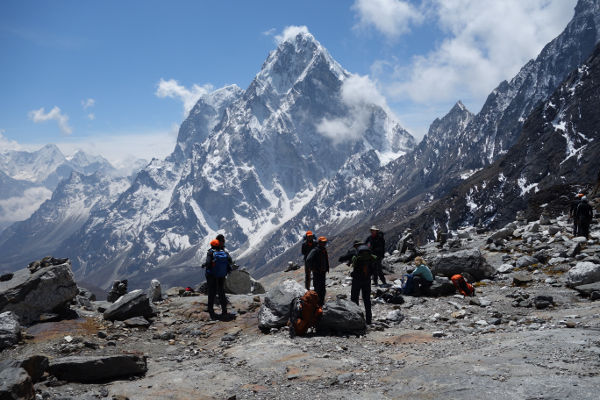
The Everest Base Camp Trek is one of the most popular and best treks in Nepal .
Home to four of the six highest mountains in the world – Mt. Everest (8,848 meters), Mt. Lhotse (8,516 meters), Mt. Makalu (8,470 meters) and Cho Oyu (8,201 meters) – the Everest (or Khumbu) region affords trekkers the opportunity to hike in one of the grandest and most awe-inspiring trekking areas in the world.
Trekkers get to retrace the footsteps taken by Sir Edmund Hillary and Tenzing Norgay on their historic Everest expedition in 1953.
On this page, you will find a comprehensive and impartial guide to the Everest Base Camp Trek.
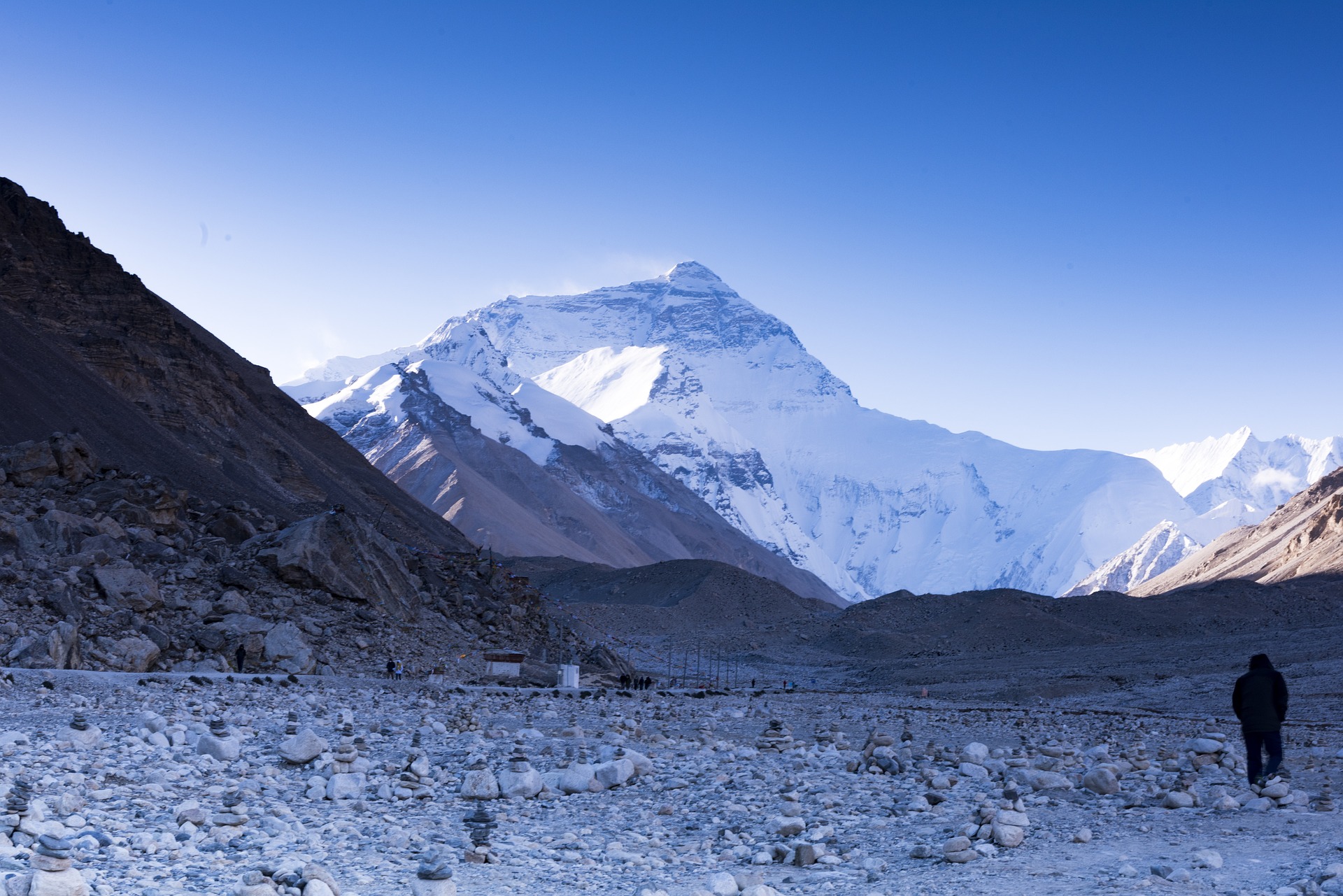
Everest Base Camp Trek
Ebc hike overview.
In this detailed Everest Base Camp trek article, you will find information on the typical route and its variations; a day-by-day itinerary breakdown of the trek; practical information on accommodation, meals, permits, equipment and insurance; as well as guidance on the best time to trek Everest Base Camp.
Key Highlights
Highlights on the trek include: unforgettable mountain views from Kala Patther , including Mt. Everest; the chance to see the famous Everest region Sherpas and Sherpa town – Namche Bazaar; sightseeing in the Sagarmatha National Park – a World Heritage Site; glimpses of the highest Buddhist monasteries in the world; and a sneak preview into the inner workings of the base camp to the world’s highest mountain.
Everest Regional Map
The Everest Base Camp trek is situated in the Everest, or Khumbu region of Nepal (see map below). It is the most popular trek in the region, if not the country.
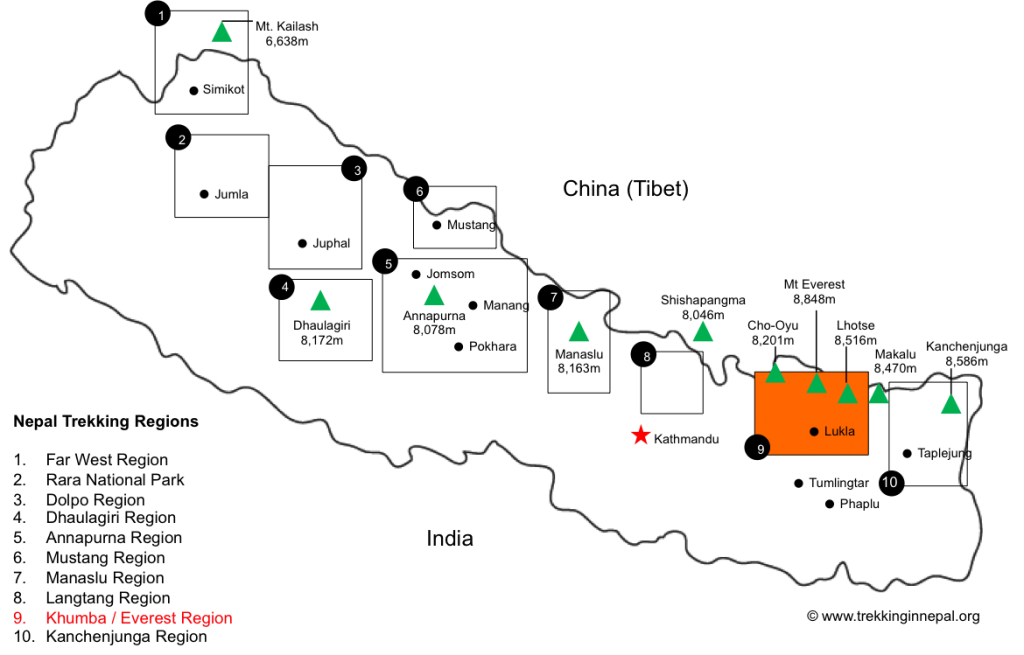
EBC Recommended Map
This map is one of the better representational schematics of the Everest Base Camp trail (we believe it is from GlobeTrekker but can’t be certain as there are many maps scattered across Google Images).
The map above shows the classic Everest Base Camp trek running up from Lukla to Namche Bazaar and then veering North-east up to Periche / Dingboche. From Dingboche / Periche the trail turns North-west to Lobuche before heading north gain to Gorak Shep. From here Everest Base Camp can be seen to the East and Kala Patthar in the North-west.
The map also shows the route to Island Peak in the East, via Dingboche and Chhukung, and the Gokyo Lakes in the West.
Please Note: The above recommended map is not to scale and should not be used as an accurate representation of the Everest Base Camp trek route. We provide links below to excellent maps of the Everest region.
EBC Trek Itinerary
Most trekkers fly from Kathmandu to Lukla Airport to begin their Everest Base Camp trek. The ‘classic’ or typical route follows straight up the Khumba Valley and through the Sagarmatha National Park to Everest Base Camp.
Variations via Gokyo Lakes or Chhukhung Valley are also popular (see the variations section below).
The typical Everest Base Camp trek duration is between 14-16 days (including transfers between Kathmandu and Lukla). The trek itself (excluding sightseeing in Kathmandu and transfers) usually lasts about 12 days with acclimatisation days at Namche Bazaar and Pheriche.
Here is a brief overview of a typical itinerary on an EBC trek, with approximate trekking times and altitudes.
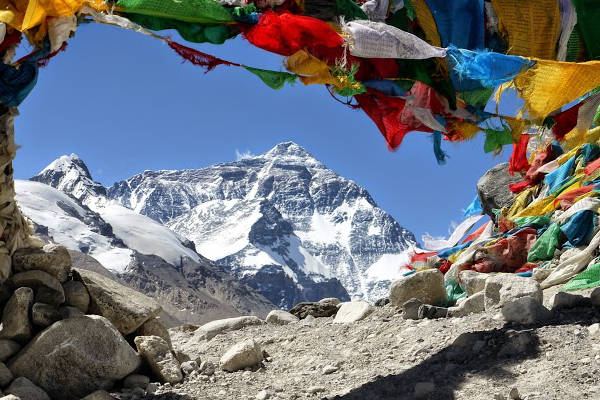
Day 1: Arrive Kathmandu
Arrive in Kathmandu. Rest and tour Kathmandu (often your tour operator will have pre-organised tours around Kathmandu).
See more in our guide on things to do in Kathmandu .
Day 2: Fly Kathmandu to Lukla. Trek to Phakding
Fly from Kathmandu to Lukla (expect a slightly scary landing at Lukla but rest assured the pilots are very experienced!). Weather can sometimes be a problem, so delays are common.
The flights afford great views of the Everest region, so have your camera ready. Try to sit on the right side of the plane to see Mt Everest. Upon arrival you will be transported to the trailhead and take a relatively easy trek from Lukla (2,800 meters) to Phakding (2,652 meters).

Namche Bazaar, Khumbu District
Day 3: Trek from Phakding to Namche Bazaar
Phakding (2,652 meters) to Namche Bazaar (3,440 meters) via Monjo (2,840 meters) and the beginning of Sagarmatha National Park. Weather permitting you might get your first glimpses of Mt Everest from the steep trail to Namche.
Day 4: Acclimatisation in Namche
This is usually a rest acclimatisation day in Namche (3,440 meters). If you are lucky enough to be in Namche on a Saturday, then make sure to visit the weekly market. Most operators will encourage you to take an acclimatisation trek to the Everest View Hotel (3,880 meters) where you can have lunch and capture views of Mt. Everest.
Day 5: Trek from Namche to Tengboche
Trek from Namche (3,440 meters) to Tengboche – also written Thyangboche (3,860 meters), home to the largest gompo (a Buddhist ecclesiastical fortification of learning). The trek is an undulating one which provides great views of beautiful mountains including Everest, Nuptse, Lhotse and Ama Dablam. Some treks go via Thame to visit the Thame Monastery, before continuing to Tengboche.
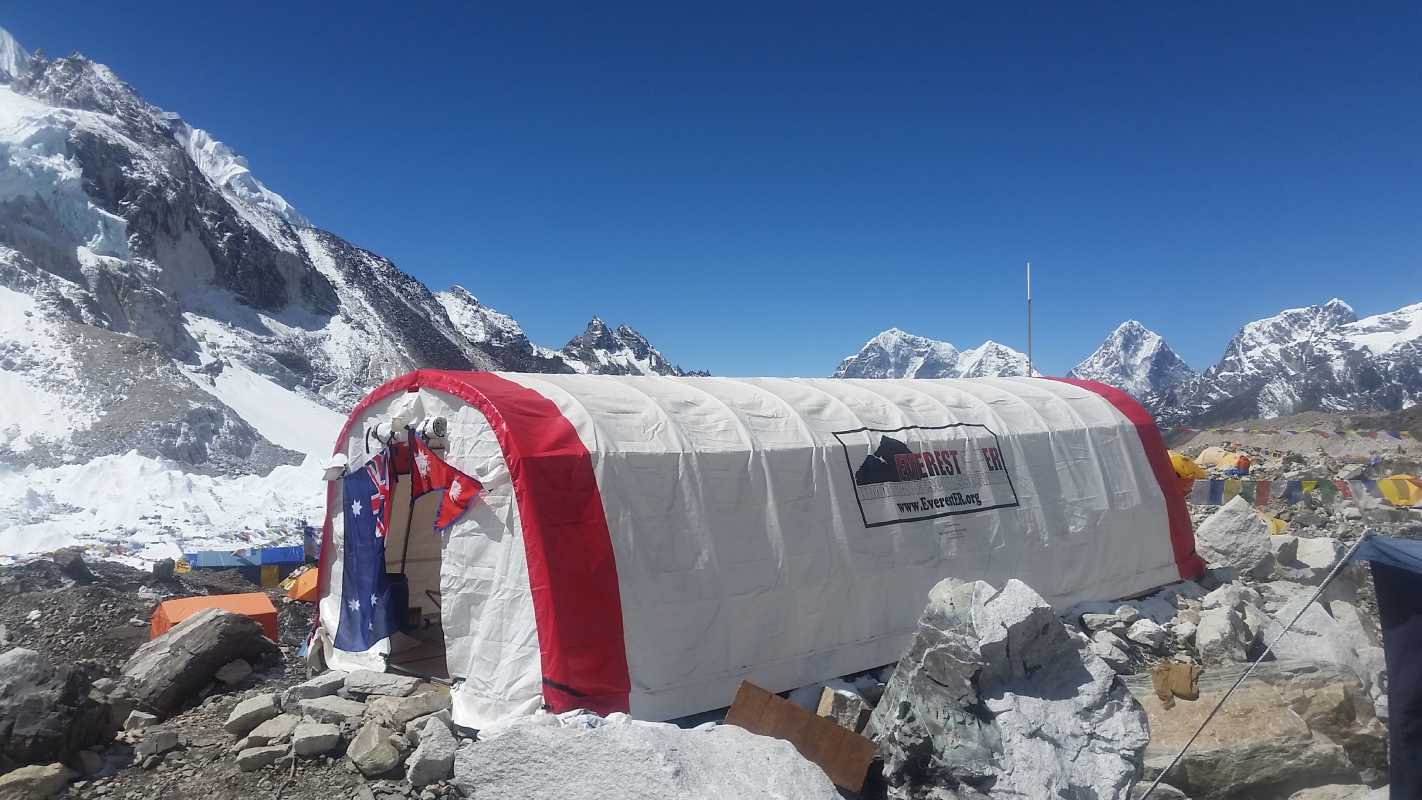
Day 6: Trek from Tengboche to Periche
Trek from Tengboche (3,860 meters) to Periche (4,280 meters) via the town of Pangboche. The Himalaya Rescue Association are based here, and it is well worth visiting them if your operator hasn’t already organised a tour.
Day 7: Acclimatisation day in Periche
Periche (4,280 meters) is usually used as the location for your second rest and acclimatisation day. Depending on your operator you will likely visit the Tshola Tsho Lake and then take a short trek towards Dingboche (4,360 meters) where you will get great views of the south face of Mt. Lhotse and Island Peak.
Day 8: Trek from Periche to Lobuche
A fairly long and steep trek from Periche (4,280 meters) to Lobuche (4,940 meters) via the Khumbu Glacier. You will see Sherpa Memorials built of stone cairns in remembrance to the many Sherpas and climbers that have died climbing Everest.
Day 9: Trek from Lobuche to Gorak Shep
Trek from Lobuche (4,940 meters) to Gorak Shep (5,170 meters) where you will have lunch and then onto Everest Base Camp (5,364 meters).
Most treks are not allowed to stay at Everest Base Camp without specific permission. The rules and regulations have changed around this issue over recent years, so it is worthwhile checking with your tour operator.
Visits to the icefall require mountaineering permits and are usually not part of a standard Everest Base Camp trek. After visiting Everest Base Camp you will return to Gorak Shep for the night.
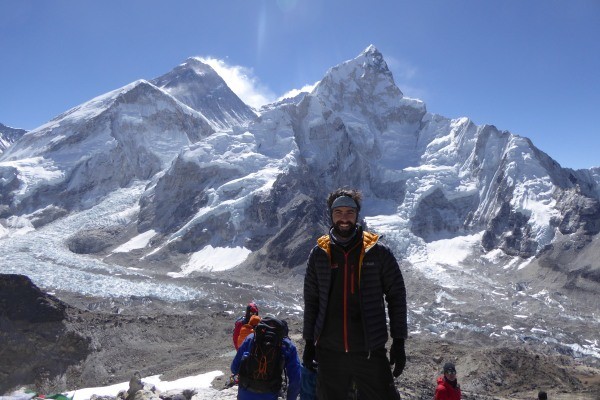
Kala Patthar
Day 10: Trek from Gorak Shep to Kala Patthar and EBC (Return to Dingboche)
A trek from Gorak Shep (5,170 meters) up the steep slopes to Kala Patthar (5,554 meters), a peak west of the Everest Base Camp which affords the best views of Mt. Everest, Nuptse Nup II and Changtse; as well as the northern flank and summit of Lhotse. You will leave Gorak Shep early to reach Kala Patther before the clouds roll in.
On a typical Everest Base Camp trek, Kala Patthar will be the highest altitude you will reach. It is also home to the worlds highest webcam – Mount Everest Webcam. From Kala Patthar, you then descend all the way back to Dingboche (4,360 meters).
Day 11: Trek from Dingboche to Namche
Trek from Dingboche (4,360 meters) to Namche (3,440 meters) via the rhododendron forests around Tengboche.
Day 12: Trek from Namche to Lukla
Trek from Namche (3,440 meters) all the way back to Lukla (2,800 meters) – a long and tiring walk to finish what is an incredible Himalaya trek.
Day 13: Fly from Lukla to Kathmandu
Fly from Lukla to Kathmandu.
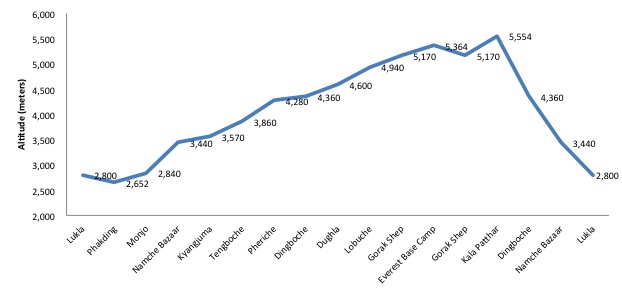
EBC Route Altitude Profile
Above is an altitude profile chart for a typical Everest Base Camp hike. The highest peak is Kala Patthar, at a staggering altitude of 5,554m.
Everest Route Variations
Below are typical route variations for the Everest BC hike.
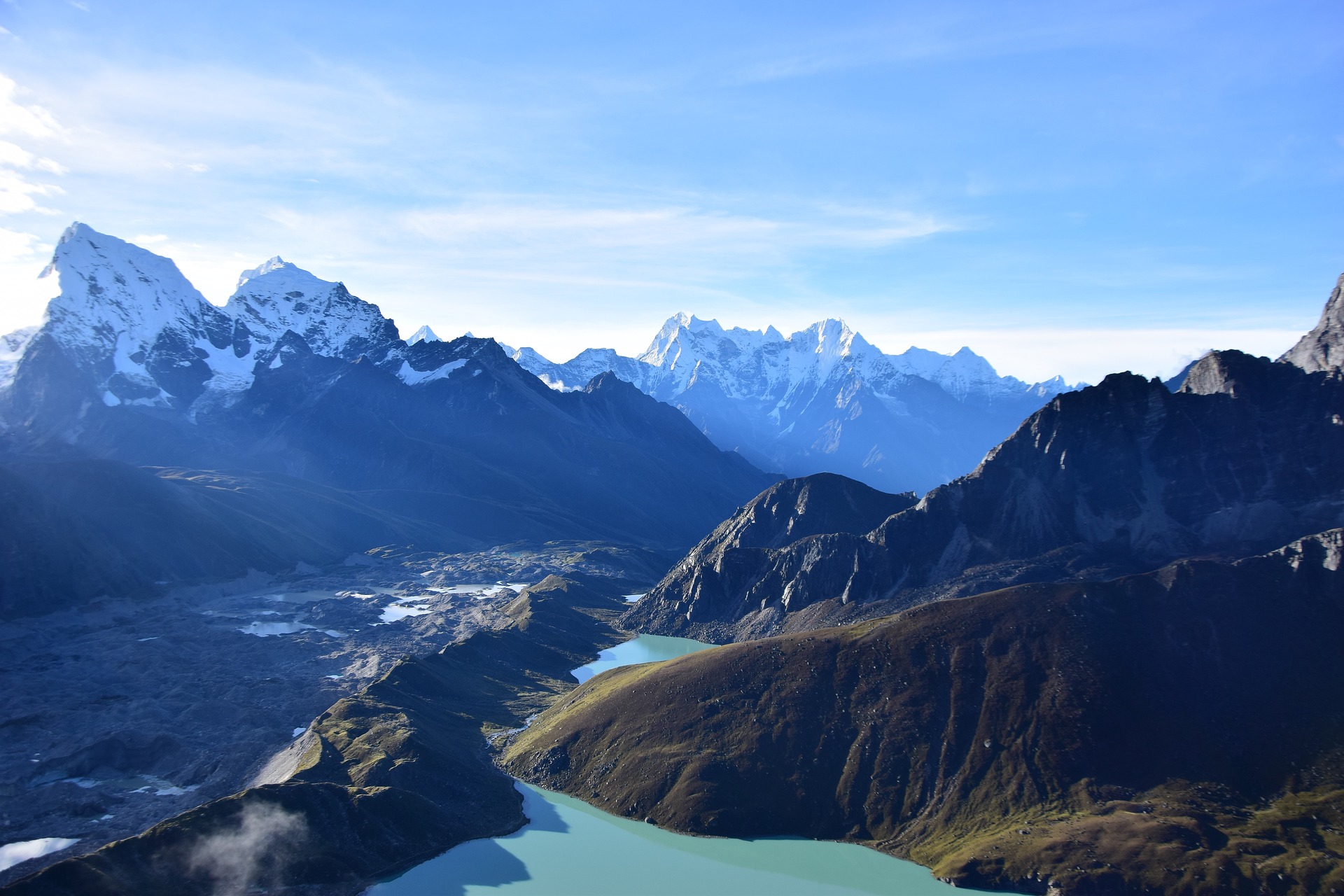
Gokyo-Ri glacier
Gokyo Lakes
The Gokyo Lakes or Gokyo Ri Trek is a fantastic variation on the Everest Base Trek. The route begins in Lukla and follows the traditional EBC trek itinerary for the first three days up to Namche Bazaar. Here it veers off to the North-west via the towns of Dole and Machemo, up to the stunningly beautiful Gokyo Lakes . The trail then ascends Gokyo Ri (5,483 meters) and traverses Cho La Pass (5,420 meters) before joining back up with the classic base camp trek at Lobuche.
The variation adds 2-3 days to an average Everest Base Camp trek but provides an excellent opportunity to avoid the crowds on the busy everest trail, as well as gives one the opportunity to trek up and down on different routes.
Chhukhung Valley
The Chhukhung Valley sits east of Dingboche and provides an alternative and longer passage to Lobuche than the traditional Everest Base Camp trail. Trekkers stay a night in Chhukhung (4,730 meters) before returning to Lobuche via Kongma La Pass (5,535 meters), an epic Himalayan pass .
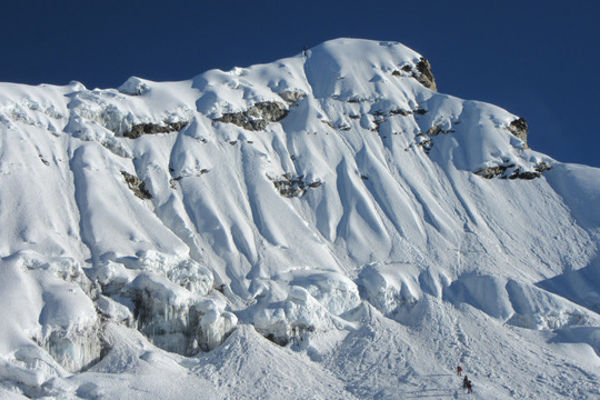
Island Peak headwall
Island Peak
Island Peak is one of Nepal’s 33 trekking peaks. Standing at 6,189 meters, Island Peak is a real challenge in terms of altitude, but only requires beginner level climbing skills (you will need to be comfortable with ice axes and crampons though). Most climbers use the traditional Everest Base Camp trek to acclimatise for Island Peak.
Returning from Everest Base Camp, you can either trek to Cchukhung via Dingboche from Lobuche or veer South-east from Lobuche traversing the Kongma La Pass to Cchukhung (4,730 meters). From here you can trek to Island Peak Base Camp (5,120 meters) in preparation for their trek / climb up to Island Peaks summit. The summit typically takes 2 days and the total trip, including Everest Base Camo, between 18-20 days.
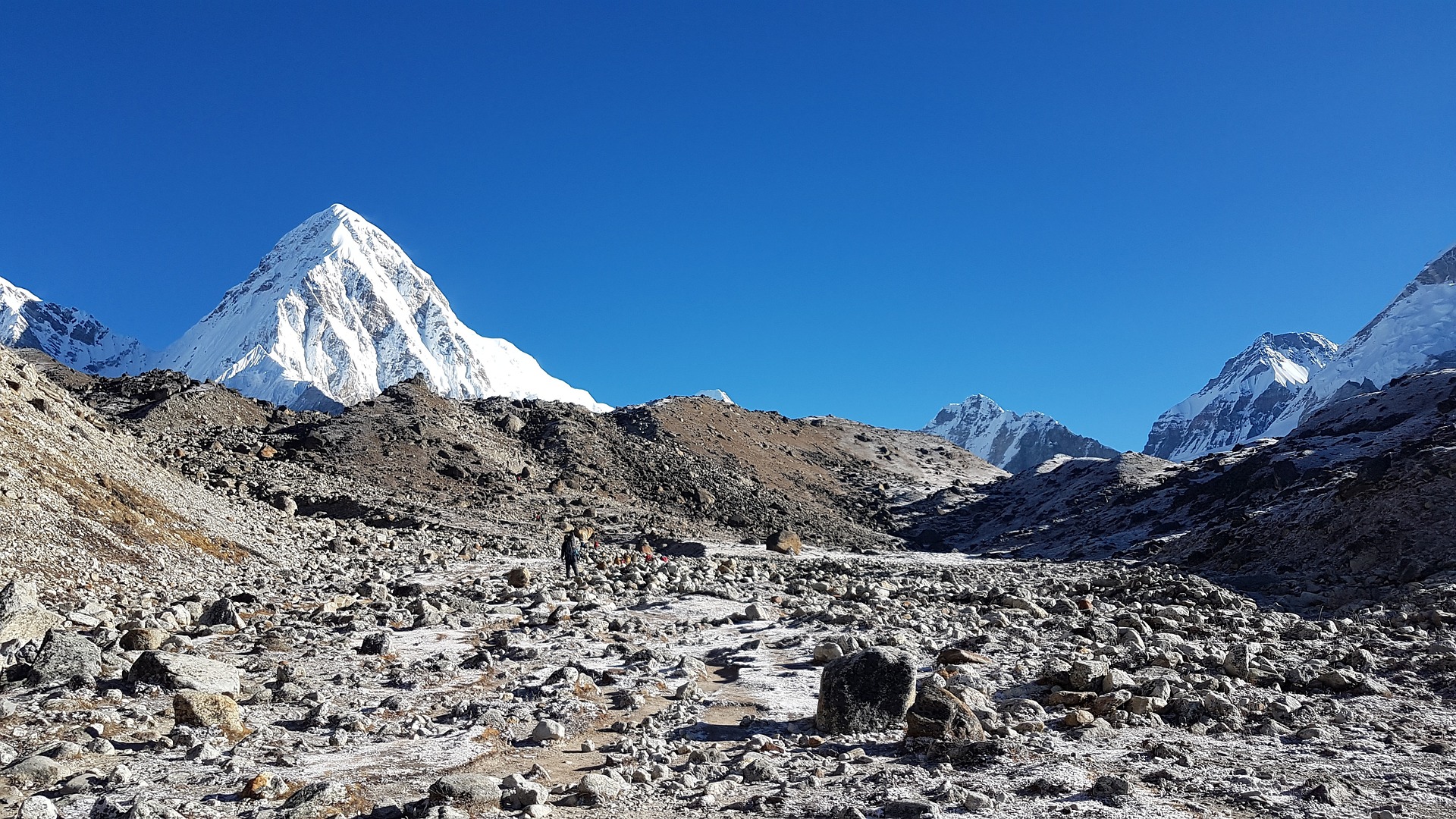
Everest Base Camp Trek FAQ
How much does the ebc trek cost.
Like many treks in Nepal, there are three ways you can plan your Everest Base Camp trek. See more in our guide on a detailed breakdown on the cost of an Everest Base Trek .
Below are four options for Everest Base Camp treks and their estimated costs.
Independent Trekking
Here you organise your trek. You will need to get yourself from Kathmandu to Lukla (a flight is the fastest and easiest; there are buses but these are rather unpleasant). You can employ the services of a porter or guide in Lukla or indeed in Namche, but it is important to note that as an independent trekker, it is illegal to use a guide or porter that is not licensed as a trekking agent through TAAN, or affiliated with a licensed trekking agent. You will need a Green TIMS card (costing NPR 2,000), money to buy food and water, a reliable and accurate map, and negotiations skills to book teahouse accommodation.
The estimated cost for an independent trek excluding flights is between $500-$800.
Local Tour Operator
There are many local tour operators in Kathmandu who organise guided Everest Base Camp treks. Generally local Nepal trekking companies are quite good. You will join a group of trekkers (up to 15 people) and have a team of porters, assistant guides and lead guides (who can speak English) of a similar size to the trekking group.
It is important to check that your local operator is a licensed trekking agent. We recommend shopping around and asking for recommendations from other trekkers. The cheap local operators tend to be the least reliable, often only providing tent accommodation or access to old and poorly run teahouses. Their ethical standards towards staff and the local environment may not be to the highest standard as well.
The estimated cost for an Everest Base Camp trek organised by a local tour operator is between $800-$2,000.
Western Run / Operated Tours
There are many Western run companies that offer Everest Base Camp treks. Most of these Western companies have their own ground teams or strong relationships with the best local tour operators who they outsource their on-the-ground operation to, whilst managing the overall tour experience.
The best Western companies own their on-the-ground operations. Expect a well-run tour with either a Western guide or a very well-trained local guide who understands the subtle service nuances expected of a Western trekker.
The estimated cost for an Everest Base Camp trek organised by a Western run tour operator is between $1,200-3,000.
Everest Climbing Expedition
A fourth option of joining an Everest climbing expedition is also possible. Major climbing operators like Adventure Consultants, Jagged Globe or Alpine Ascents usually offer Everest Base Camp trekking spaces on their Everest climbing expeditions. Securing a trekking space can be a little pricey but offers one an incredible insight into an Everest expedition as well as the chance to spend a night or two at Everest Base Camp.
If you think a base camp trek is expensive, wait till you hear how much it costs to Climb Mount Everest !

Are permits required for the EBC trek?
Yes, there are two permits you require for standard treks from Lukla to EBC. They are:
1. Trekkers Information Management System (TIMS Card)
TIMS cards are issued by the Tourism Agency Association of Nepal (TAAN). There are three different types:
- Organised TIMS Card (Blue in colour, USD 10). If you are trekking with an organised tour these will be arranged for you. You will need to provide your passport number and one passport photograph
- Individual TIMS Card (Green in colour, USD 20). If you are trekking independently (without support) you will need to get one of these TIMS cards from the Nepal Tourism Board in Kathmandu
- SAARC Country TIMS Card (Red in colour, USD 3). These cards are for nationals from the South Asian Association for Regional Cooperation, i.e. India, Bhutan, Pakistan, Sri Lanka, Maldives, Bangladesh and Afghanistan.
2. Sagarmatha National Park Entry Permit (USD 30 + 13% Govt. Tax)
The Sagarmatha National Park or Solukhumbu is the region through which the EBC trek runs. A National Park entry permit is required to enter Sagarmatha. Permits can be acquired at the first checkpoint along the route, north of Lukla called Monjo. The cost is US$30 + 13% tax for trekkers using a trek operator or agency, as well as for independent trekkers. Permits can also be acquired in Kathmandu, but we recommend getting it in Monjo as it is more straightforward.
For treks from Jiri to Everest Base Camp, there is another permit required called the Gaurishankar Conservation Area Project permit. It costs US$20 (no discount for independent trekkers or SAAEC nationals). The checkpoint is at at Shivalaya (just after Jiri). We recommend getting the permit in Kathmandu before departing as the cost is double if they have to issue the permit in Shivalaya.
As a rule of thumb, we recommend bringing at least 4 passport size photographs for all your permit requirements.
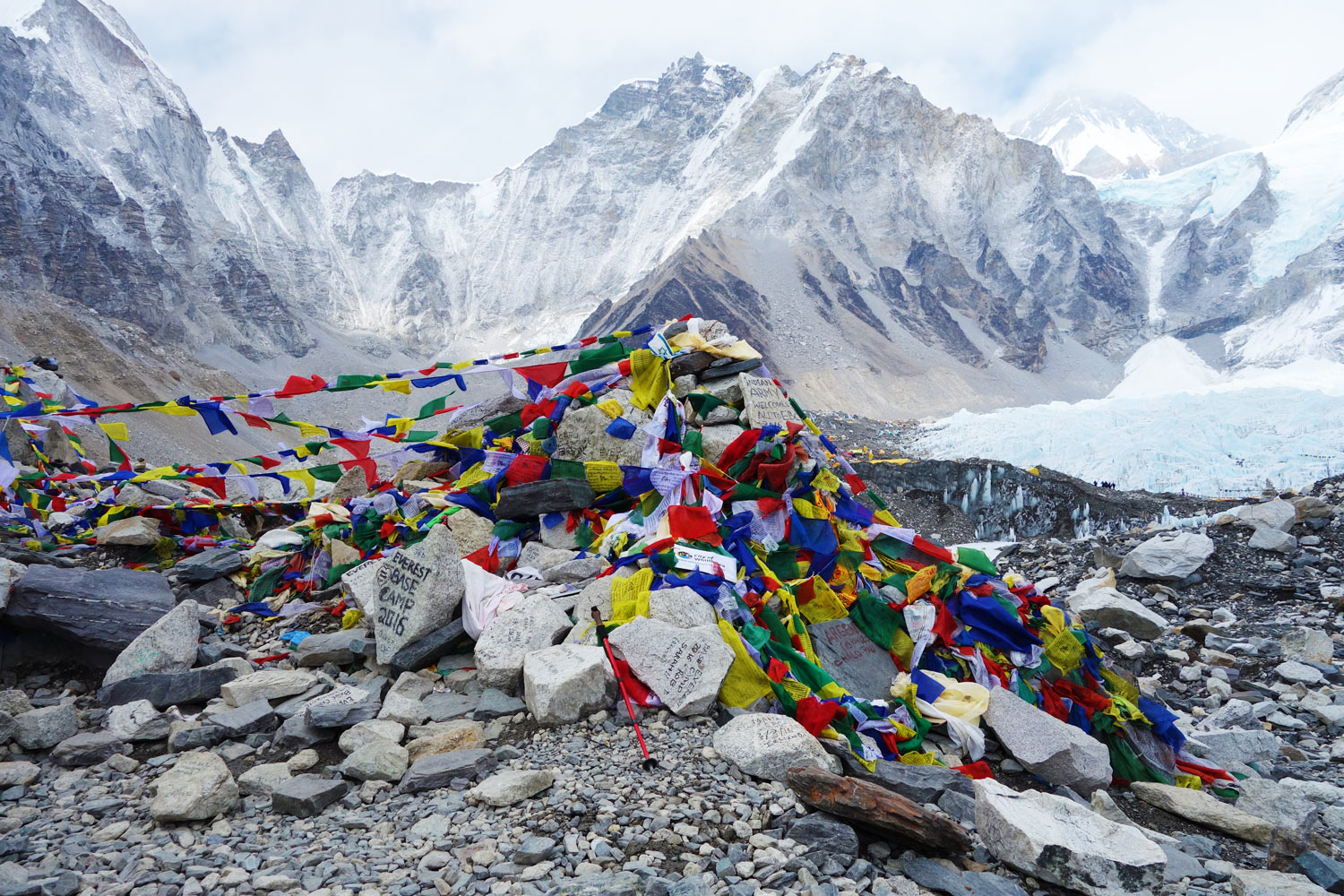
When is the best time to trek to Everest Base Camp?
The best time to trek Everest Base Camp is during the dry and warm months of September through November of March through late May / Early June.
The monsoon rains arrive in mid-late June and get into full swing for the months of July and August (as seen in the average rainfall map below). The route is really too wet for trekking and you would be better placed to explore treks in rain shadow areas like the Upper Manang, Mustang, Annapurna or Dolpo region.
December, January and early February are very cold. Treks run during these periods but be prepared for freezing temperatures and possible snow flurries. The upside is that the route is a lot quieter than in the peak seasons.
The chart shows average temperatures and rainfall in Nepal (data from 1960-1990 compliments of the Climate Change Knowledge Portal at the World Bank ).

Is altitude sickness a risk on the Everest Base Camp hike?
Yes, altitude sickness is a risk on the Everest Base Camp route. The trek takes one from a moderately high altitude, 2,800 meters in Lukla, to high altitude, over 5,300 meters at Everest Base Camp and over 5,500 meters at Kala Patthar. At these higher altitudes, the body needs to have acclimatised to the lower saturation of oxygen in the air in order to avoid the symptoms of altitude sickness (or what is sometimes referred to as Acute Mountain Sickness – AMS).
The good news is that a typical Everest Base Camp hike has a slow ascent profile which maximises the amount of time available to acclimatise. Nonetheless, every year 100s of people suffer altitude sickness symptoms and some need to cut their trek short due to more severe complications.
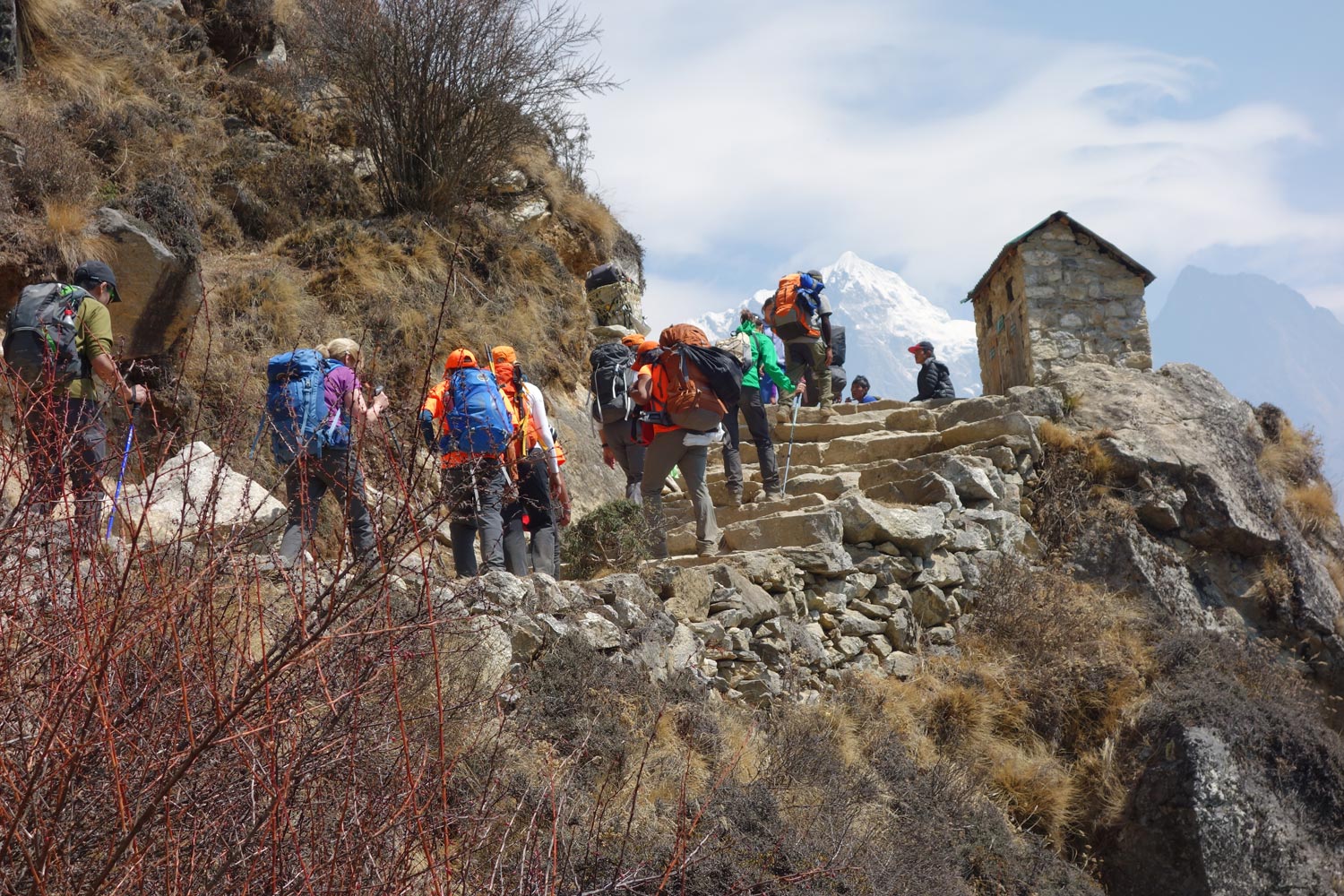
How difficult is the Everest Base Camp Trek?
The difficulty of the Everest Base Camp Trek is relatively low. It should be noted that the Everest Base Camp trek requires no climbing expertise and there are certainly no technical climbing sections. With determination and a basic fitness level, you should be able to trek the route. We have seen old and young, overweight and underweight complete the trek – all with a smile on their face!
With that being said, there are certainly some factors that should be considered prior to your trek, such as altitude, length and training that will enable you to better understand what you are getting yourself into before deciding.
What gear do I need for the EBC Trek?
One of the most frequent questions that we get asked is what gear should be packed for an Everest Base Camp trek.
To make your life a lot easier we have written a very detailed Everest Base Camp packing list article. The list is fairly exhaustive but includes all the absolutely necessary items of clothing and outdoor gear that you should bring with you.
You will have the opportunity to either buy or rent gear in Kathmandu, Lukla or even in Namche Bazaar, but in general we recommend you bring with you the main items (i.e. hiking daypack , hiking boots, warm down jacket, sleeping bag and sleeping mat , trekking poles , appropriate trekking clothes, headgear and headlamp and gloves etc.)
What travel insurance do I need for the EBC hike?
Trekking Everest Base Camp comes with obvious risks. We recommend you get travel and trekking insurance for all treks in Nepal .
On the Everest Base Camp route, you will reach a maximum altitude of 5,416 meters, so it is important you choose an insurance package that covers you up to that altitude.

Are there any recommended guidebooks for the Everest Base Camp Trek?
Absolutely. There are some great guidebooks and trekking maps to choose from when doing the Everest Base Camp Trek.
The classic EBC trail itself is well-worn, but there are many smaller yak trails that can confuse people.
We recommend taking a detailed trekking map. The region is sparse, and it is possible to get lost in the many valleys that lie on either side of the main trail. The most recent Lonely Planet Trekking in the Nepal Himalaya provides the most up to date information and maps of the region.
Sian Pritchard-Jones and Bob Gibbons’s book: A Trekking Guide to Everest is also rather good.
For a more general guide to Nepal, you may want to check out the Nepal Lonely Planet Travel Guide .
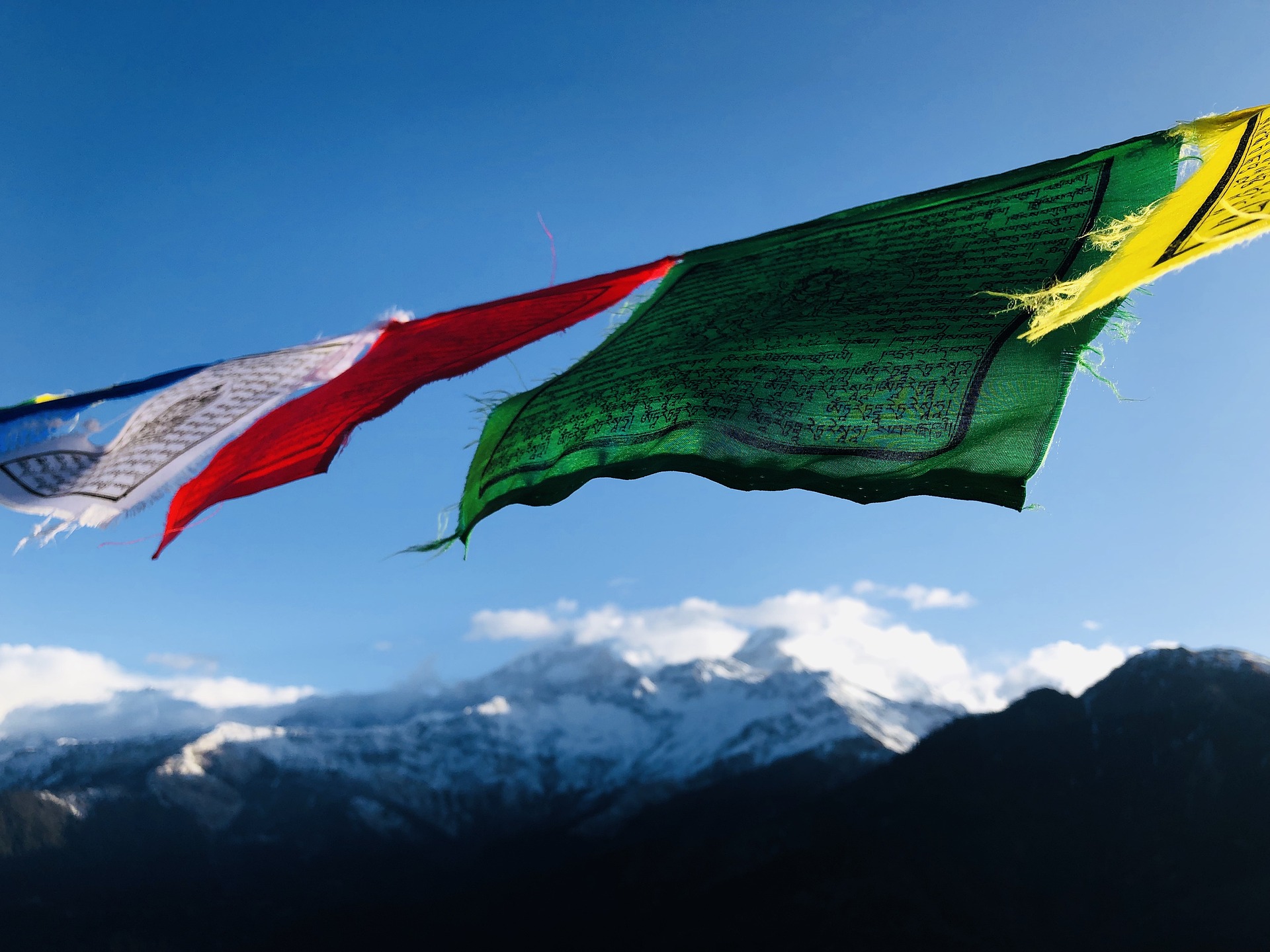
Are there any other hikes in Nepal you would recommend?
Yes, there are many other hikes in Nepal that I love.
Some of the most popular alternative Nepal trekking routes are the Annapurna Circuit Trek , the Langtang Valley Trek and the Manaslu Circuit Trek . If you're looking for some easy Nepal hikes , then check out the Poon hill hike or the Royal hike . For short Nepal hiking routes see the Helambu hike , which is near Kathmandu.
Continue browsing
See more information on Nepal . Or check out these other Everest/Nepal articles:
- Best Climbing Mount Everest Tips
- Food on the Everest hike
- Internet Access on EBC hike
- Everest Base Camp Trek Deaths and Statistics
- Best Places to Visit in Nepal
- What to Expect in Nepal Tea Houses
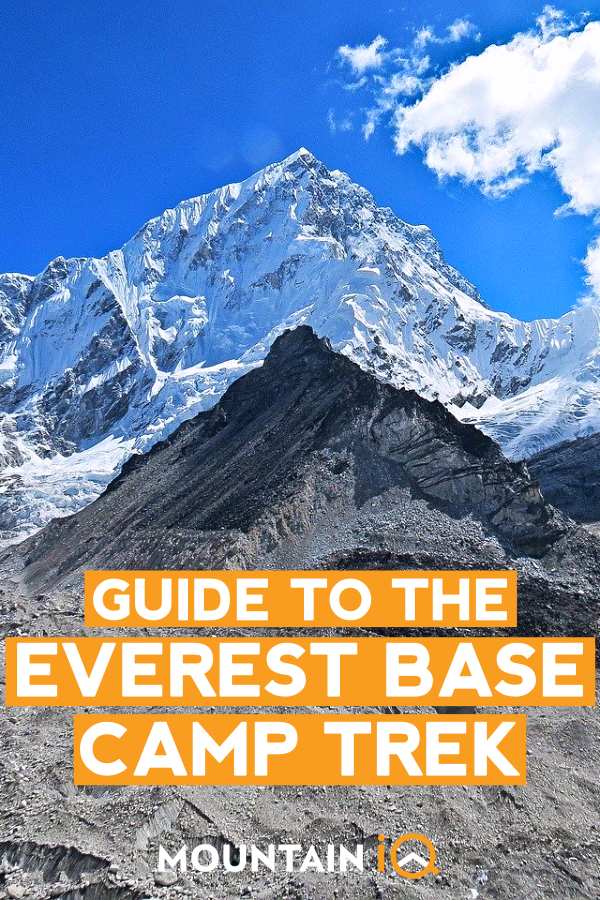
About the author
Mark Whitman
Mark has trekked extensively in Asia, Europe, South America and Africa. He founded Mountain IQ in 2014 with the sole aim to be the best online information portal to some of the most popular mountain destinations around the world. When not writing for Mountain IQ, Mark is out exploring the outdoors with his wife!
Leave a Reply
Your email address will not be published. Required fields are marked
Nice article. Full of true information and very supportive for new trekkers.
We work with local guides to offer great value adventures at unbeatable prices
How To Do The Everest Base Camp Trek In Nepal
The Mount Everest Base Camp Trek in Nepal is one of the world’s best bucket list hikes. In less than 2 weeks, you can trek to the foot of Mt Everest and other snowy peaks in the Himalayan mountains.
The good news is that it’s not a super difficult hike, and you don’t need a big budget to do it. The EBC trek is worth it for the fun and accomplishment alone, but you also get views of the Himalayas that are out of this world.
This travel guide will explain how you can do the Mt Everest Base Camp hike independently (with or without a tour guide), along with a recommended packing list and everything else you need to know before you go!
Best Everest Base Camp Tours
First of all, if you’d rather skip the hassle of planning your own EBC Trek, Klook has Everest Base Camp Tours starting as low as $900 USD for a full 12-day trek.
You may be able to find something cheaper than this once you land in Kathmandu, but booking online with a vetted tour company has some big advantages, and the reviews on their website are very positive.
We’ve used Klook for lots of tours and activities around the world, and they’re great! Highly recommended.
Book Now: Everest Base Camp Tours

When To Do The EBC Trek
The Mt Everest region has 4 different trekking seasons:
- March – May: High season. Best weather, with stable temperatures and bright sunny days, but the trails can get crowded. During these months you may share the EBC trail with pro climbers on the way to go summit Everest.
- June – August: Monsoon season. There’s a lot more rain during these months, and the trails are mostly empty.
- September – October: Clear days and busy trails. This is one of the most popular trekking seasons.
- November – February: Coldest season, but the weather is stable and dry. The trails are mostly clear.
I trekked in early February, and even though it was nice having the trail mostly to myself, the cold in the evenings and mornings was straight up misery.
My home state of Missouri can get very cold in the winter, but the cold has just never been my thing. If I could go back and change it, I would definitely do my Everest Base Camp hike later in the season.

Everest Base Camp Weather
Temperatures on the Mt Everest Base Camp Trek can range from 5 °C (40 °F) to 20 °C (70 °F) depending on month, and as low as -30 °C (-22 °F) at night during the winter months.
If you trek during the warmer months (Mar-May and Sep-Oct), the cold is not a big problem and shouldn’t be hard to cope with. Winter is a different story. Your snot will freeze in your nose at Gorak Shep.
Sunshine is key for winter trekking in Nepal, and thankfully you should have lots of sun in most months outside of the monsoon season. On my February hike, I often found myself shedding all my layers while trekking because I was heating up in the sun.
If you do your Everest Base Camp hike during the winter, the biggest issue is staying warm in the evenings and at night. For this, you’ll definitely want a top quality down jacket and sleeping bag.

All About Everest Base Camp Trekking
My everest base camp itinerary.
- Day 1: Kathmandu to Lukla to Benkar .
- Day 2: Benkar to Namche Bazaar .
- Day 3: Namche Acclimatization Day .
- Day 4: Namche to Deboche .
- Day 5: Deboche to Pangboche .
- Day 6: Pangboche to Dingboche .
- Day 7: Dingboche Acclimatization Day .
- Day 8: Dingboche to Thukla .
- Day 9: Thukla to Gorak Shep .
- Day 10: Everest Base Camp .
- Day 11: Kala Patthar to Gorak Shep to Pheriche .
- Day 12: Pheriche to Namche .
- Day 13: Namche to Lukla .

If you ever need motivation to keep going on the Everest Base Camp hike, just look at how much the porters are carrying!

Mount Pumori as seen from the Kala Patthar viewpoint, just a short distance from Mt Everest Base Camp.

Ama Dablam, one of my favorite mountains on the Mt Everest Base Camp Trek.
EBC Trek Packing List / Gear
This isn’t a complete list of everything to bring on a Mt Everest Base Camp Trek, and you may have to change things up a little depending on what month you go, but these are just some of the basics.
You can find most of this gear in Kathmandu, but in my opinion you’ll get higher quality and a wider selection if you order online.
- Beanie: I only wore this at night, but it definitely helped keep my ears warm.
- Down Jacket: Bring the biggest, warmest DJ possible. This is your most important piece of gear. You can use it as an extra cover at night.
- Fleece Sweater: This is the only jacket you’ll need to wear while trekking most days, especially if it’s sunny.
- Shirts: Something comfy with quick dry material.
- Trekking Pants: Something lightweight and breathable.
- Thermal Underwear: May not be needed if you trek in the warmer months.
- Gloves: I only wore these at night, but they definitely helped keep my hands warm.
- Socks: Merino wool is best for staying warm and stopping moisture.
- Headlight: Smart to have at least a small one, just in case.
- Tumbler: 1 liter water bottle to refill daily on the trek.
- Sunblock: It’s easy to sunburn at high altitudes. A small bottle is plenty.
- Sunglasses: Good for snow. May not be necessary unless you plan to hike a mountain pass like Cho La.
- Hat: I wore old faithful throughout the hike.
- Watch: An altimeter watch would be fun to play with here.
- Camera: Duh. You can’t do the Mt Everest Base Camp Trek without taking lots of pictures.
- Power Bank: Bring a big power bank and you might only need to recharge it once on the whole trek.


Everest Base Camp Trek Cost
For a 13 day trek, I paid about $21 USD per day for food, drinks, and room. Porter/guide was an extra $25 per day, although it’s not a requirement. Flights to Lukla were $330 return, but again not a requirement if you hike in.
You can read the sections below for more info on the daily trekking costs and what you get for your money. It’s not a very expensive trek, all things considered!
Keep in mind, these numbers are from 2020. They’ll go up a little over time. Exchange rates may also vary, so check the latest rates .

The flight to Lukla from Kathmandu is $165 USD each way. You can shop for flights to Lukla at Skyscanner.
If your budget is tight or you have extra time, you can skip this flight by hiking from Jiri to Lukla rather than flying. It only adds a couple days to the itinerary.

Guide / Porter / Solo
You can do the EBC trek with a guide, porter, OR independently (solo).
A guide will show you the way to Mt Everest Base Camp and help with lodging, navigation, advice, taking pictures for you, etc. A porter-guide will do these same things and also carry a 20 kg (45 lb) pack for you.
A porter or guide is NOT a requirement to do this hike, especially if you go in the warmer months when you may not need as much gear. In 2023, they were supposedly introducing a guide requirement for EBC, but so far that has not been enforced at all, thankfully.
With that said, there are some good advantages to hiring a guide, and it’s pretty cheap by Western standards. A porter is only $15 or $20 USD per day, and a porter-guide is $25 per day. A popular arrangement is to hire one porter for two hikers, splitting the cost and still making things easier for both of you.
In the end, this all depends on your budget and hiking preferences.

Hiking Fees
If you’re hiking EBC independently, you’ll need to be aware of two fees you have to pay near the start of the trek.
There’s a local government tax that they’ve now started collecting in Lukla. This one is currently 2,000 Rupees ($17 USD).
There’s also an Everest park fee/ticket you have to pay at the Sagarmatha National Park entrance just beyond the small village of Monjo, Nepal. This one is currently 3,500 Rupees ($30 USD).
No TIMS card is needed anymore for independent hikers. That fee has been retired for the Mount Everest Base Camp Trek.

Accommodation & Amenities
Throughout the Everest Base Camp hike, you’ll stay and sleep at small guesthouses along the way, called teahouses.
This is where you get your meals and drinks for the trek, along with the occasional amenities like showers, charging, or WiFi. The teahouses start out decent, but quickly get more shabby as you go further up the trail.
You have to pay for everything you use, of course, and the prices get quite high as you go, because everything has to be hauled up on the backs of the poor porters.

Guesthouses
The teahouses on the EBC trek are cold and dingy, with drop toilets and cracks in the walls. Don’t expect luxury.
Most rooms are free as long as you buy your meals there (the meals are how they make their money). If you stay at a lodge and don’t eat there, you’ll be expected to pay for the room.
In some cases, I was charged 500 Rupees for a room on top of my meal costs. I’m not sure why some teahouses do this and others don’t, but I never paid more than 500 Rupees for a room, and most were free with the meals.

Food & Drink
I’m happy to report that the food and drinks on the Everest Base Camp hike are top notch, especially after you’ve worked up an appetite trekking.
You have western food choices, or the standard local staples like veggie fried rice, steamed momos (dumplings), and mushroom soup. Everything was hot and fresh. Meal prices for these ranged from 250 to 750 Rupees depending on altitude. Not too bad.
For drinks I tried hot chocolate, lemon/apple/mint tea, and occasionally bottled water for my tumbler. These ranged from 100 to 400 Rupees. If you want to avoid plastic bottles, there’s usually boiled water available and this is safe to drink too.
Getting enough water on the trek is never a problem. Just fill up a 1 liter tumbler in the morning, and this will last you until evening, especially since you’re likely to pass more tea houses along the trail as you’re hiking throughout the day.

Showers are only available at a few lodges, depending on the season and how high up you are, and they cost 600 to 1200 Rupees. In the winter, water higher up will be frozen most of the time.
I never had a shower on my February EBC trek, and that seems to be the norm (although I got one or two opportunities in Namche). Yes, it’s gross. I could smell myself by trek’s end, and it wasn’t pretty.
But aside from the fact that I hate to fork out money for something as basic as a shower, I also never really got close to other people for very long on the trek, so I didn’t feel too guilty about it.
Most days were cold enough that the thought of stripping down for a shower was not really appealing, either. Your best bet is baby wipes and deodorant.

WiFi / Cell Service
WiFi costs anywhere from $5 to $10 USD per day if you buy it from the teahouses.
Alternatively, you can buy a 10 GB/30 Day Everest Link WiFi card in Namche Bazaar and use this for the entire EBC trek. During my Mount Everest Base Camp Trek the WiFi was down across the whole region, so unfortunately I wasn’t able to use either of these options.
I bought an Ncell local SIM card in the Kathmandu airport and had 3G service for half the days of the Everest Base Camp hike. Coverage is still improving in the area, so if you need to stay connected I’d definitely bring a local SIM.

Electricity
All of the teahouses on the way to Mt Everest Base Camp sell outlet charging for electronics, and the prices range from $2 to $10 USD for a full charge, depending on how far up the trail you are.
The key is to bring a big power bank and then use this to charge all of your other electronics (phone, camera, etc). I did this and only paid once to recharge my power bank on the whole trek.

How Much Cash To Bring
Everything you buy during the Everest Base Camp hike (meals, WiFi, charging, etc) will have to be paid for with cash. Credit cards won’t work. There are no ATMs outside of Lukla and Namche Bazaar (Days 1-4), and even the ATMs there are not reliable.
What this means is that you’ll have to withdraw enough cash (Nepalese Rupees) at an ATM in Kathmandu to cover your entire trek. The ATM fees will bite you, and I hate to carry large amounts of cash, but it’s not really avoidable here.
All up, I spent about $20 USD (2,400 Rupees) per day on the Mount Everest Base Camp Trek, and never spent more than $25 USD in a single day. With that said, I didn’t splurge on WiFi, showers, charging, or alcohol. The only things I bought were the bare necessities: room, food, and drinks.
If you hire a porter/guide, you don’t need to factor that into your daily cash carry. That’s paid before the trek starts. But do reserve a little cash for a decent tip.

Mount Everest Base Camp Trek Difficulty
I’m not going to lie, this is a difficult trek. And if you do it in the winter like I did, it’s even harder. With that said, if you are in decent shape, determined, and obey the guidelines for altitude sickness prevention (more on that below), then you’ll have no problem reaching base camp.
There is a lot of elevation gain and loss on this hike. At times near Lukla, the constant ups and downs will make you feel like you’re hiking a roller coaster, but the trail is never too steep or dangerous. After Namche, it’s mostly a slow uphill plod.
This trek has been completed by old seasoned hikers in their 70s, and young kids in their pre-teens. It’s also been flunked by healthy 20-30 somethings who try to push through it quickly without enough acclimatization to altitude.
Patience and discipline are key for trekking to Everest Base Camp. Slow and steady wins the race here.

Trekking Distance
The one way trekking distance from Lukla to Mt Everest Base Camp is about 65 kilometers (40 miles).
That means the total roundtrip distance of an EBC Trek is about 130 kilometers, even if you don’t do any of the detours.
Don’t let that scare you off. It’s a lot of hiking, but every step is worth it.

Altitude Sickness
By far your biggest danger on the Mount Everest Base Camp Trek is altitude sickness, also known as Acute Mountain Sickness (AMS).
No one is immune to this, and it doesn’t matter how fit you are. If you gain altitude too fast, you can get sick and in some cases even die. Plenty of people have died from AMS on the EBC Trek.
The problem is that overzealous hikers push the envelope on this hike all the time, and a lot of them end up needing a very expensive helicopter evacuation to lower ground.
The best way to avoid altitude sickness is to go slow . At altitudes above 3,000 meters (10,000 feet), don’t increase your sleeping elevation by more than 300-500 meters (1,000-1,500 feet) per night.
Every 1,000 meters (3,000 feet) you should also spend a second night at the same elevation. If you get a bad headache, dizziness, or nausea, descend to a lower altitude until you feel better. As long as you follow these general guidelines, you shouldn’t have any issues.
You can take Diamox (acetazolamide) on the trek for extra AMS prevention. This medication can be found in Kathmandu or Namche. I bought mine in Namche and it seemed to help my headache and slight foggy feeling. I didn’t have any side effects aside from the usual tingling toes/fingers.

Everest Base Camp Altitude
The Mount Everest Base Camp altitude is 5,364 meters (17,598 feet). At this elevation, there is 50% of the oxygen at sea level.
However, most treks also go to Kala Patthar, a viewpoint even higher than base camp where you can get the best views of Mount Everest.
The elevation at Kala Patthar is 5,644 meters (18,519 feet). From there, you’ll be rewarded with an incredible panorama of Mount Everest and other icy peaks like Pumori, Lhotse, and Nuptse.
Happy travels!

If you’d rather skip the hassle of planning your own EBC Trek, Klook has Everest Base Camp Tours starting as low as $900 USD for a full 12-day trek.
You may be able to find something cheaper than this once you land in Kathmandu, but booking online with a vetted tour company has some big advantages, and the reviews on their website are very positive for this Mt Everest Base Camp tour.
More Nepal Travel Tips
Hopefully you were helped by this guide for the Everest Base Camp Trek. Let me know in the comments below if I can help answer any questions.

You may also like
Fulidhoo island guide: shark & stingray beach in maldives, how to visit dhigurah island: budget paradise in maldives, 10 best hikes in aruba: family friendly trails, how to visit tanjung puting national park in indonesia, sanur bali travel guide: 24 best things to do, coron vs el nido: which is better all differences explained.
So much useful detailed information.
Thanks for the straight forward information. Beautiful photos

Leave a Comment Cancel Reply
Save my name, email, and website in this browser for the next time I comment.

- Classic EBC Trek
- EBC + Gokyo Trek
- Jiri to EBC
- 3 Passes Trek to EBC
- Island Peak and EBC
- Acclimatisation
- Packing List
- Get a Trek Quote
Start planning your Everest base camp trek
We help adventure-seekers plan and book their dream trek to EBC
Welcome to EBC Trek Guide
Reaching Everest Base Camp has become the goal of thousands of avid trekkers the world over. There is a sense of grandeur that comes with trekking through an area considered a Mecca for climbing and mountain enthusiasts.
This website is the most comprehensive online guide to the Everest Base Camp Trek. On it you will find all the information you need to trek safely and successfully in the region.
On this page we provide a general overview to the Everest Base Camp Trek, along with many links to further reading on topics like: Altitude Sickness, Packing Lists, Route Variations and many FAQs!
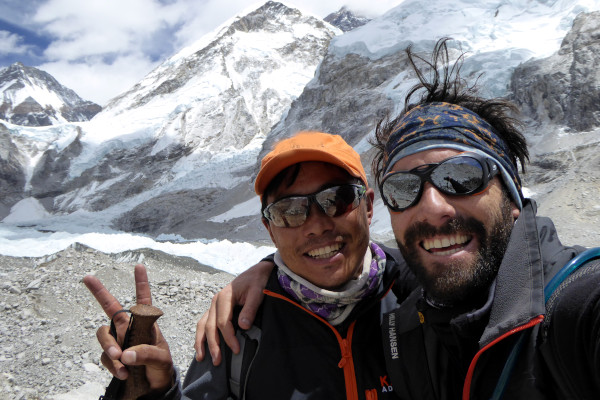
Plan your EBC Trek
Get a quote from our recommended local EBC trek operator
Everest Base Camp Trek FAQ
What makes the everest base camp hike special.
The iconic Everest Base Camp Trek leads you through the Khumbu Valley, allowing you to experience the immense beauty of the surrounding Sagarmatha National Park while simultaneously providing breath-taking vistas of 4 of the 6 highest peaks in the world – My. Everest (8.848m), Mt. Lhotse (8,516 meters), Mt. Makalu (8,470 meters) and Cho Oyu (8,201 meters).
The classic trek retraces the footsteps of Sir Edmund Hillary, Tenzing Norgay and the countless other early pioneers of Mount Everest as you trek from Lukla to the Base Camp.
As a teahouse trek you will stay in some of the highest villages in the world as you explore the local culture and traditions of the native Sherpas by learning about their spiritual connection with the mountains.
On the trek you will have the chance to ascend Kala Patthar , reaching an altitude of 5,500m and witness awe-inspiring views of Mount Everest.
You will also have the chance to explore the various Buddhist monasteries dotted along the trail and learn about a culture steeped in history and tradition, inextricably linked to the very mountains on which you have unforgettable views.
Below we have provided a brief overview of the classic route itinerary, with regional and trekking maps. We have also answered some of the most frequently asked questions on the logistics of the trek, permits, tour guides, weather, insurance, cost, difficulty and what to pack.
Where is the Everest base camp trek located?
All treks in the Everest region are located within the orange rectangle on the map below. The block represents the Everest or Khumbu region of Nepal and shows its location in relation to Kathmandu, where flights to and from Nepal arrive and depart.
The starting point of the Everest Base Camp Trek, Lukla , is also visible on the map. Other variations of the trek which don’t involve flying to Lukla generally start at Jiri – you can read more about this route variation here .

What is the best Everest region map?
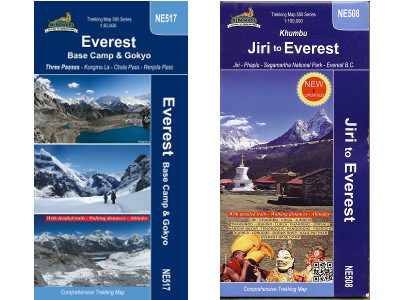
There are many great trekking maps for the Everest Region. Some take in the Gokyo region, whereas others cover Jiri and further Southern and Western aspects of the region.
We recommend Nepa Maps .
What is the best Everest guidebook?
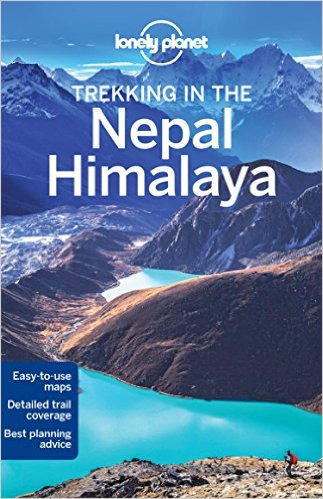
We recommended taking a detailed guidebook with you on the trek.
The Lonely Planet Trekking in Nepal Himalaya guidebook is updated regularly and is a well-known, trusted resource used by many trekkers worldwide.
The guide is very detailed and contains information for many treks, meaning you can use it more than once!
How high is Everest base camp?
Everest base camp is 5,364 metres (17,598 ft) high. The graph below shows the altitude profile for the classic Everest Base Camp trek. The order of the names on the horizontal axis shows the typical progression of the hike with the major stops on the way. The graph makes it easier to see the gradual ascent and more rapid descent of the trek.
The highest point on the EBC hike is Kala Patthar at 5,554 meters.
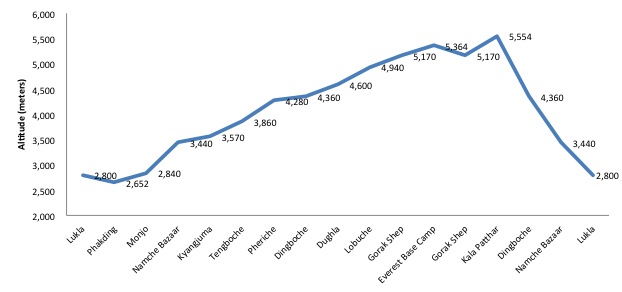
What is the day-to-day itinerary on the Mt Everest base camp hike?
The classic Everest Base Camp Trek starts in Lukla and leads you through the Khumbu Valley to the Everest Base Camp situated on the south-side of Mount Everest.
Most trekker’s adventures, however, begin in Kathmandu where the international airport for Nepal is located. From there it is a short, yet unforgettable flight into Lukla from where you will start the actual trekking (try get a seat on the left hand side of the plane for best first views of the Himalaya).
The entire journey including the trek typically lasts between 14 and 16 days, with 12 days on the trail. Of these 12 days, 2/3 will be spent acclimatising to the high altitude, so 9-10 days of actual trekking can be expected.
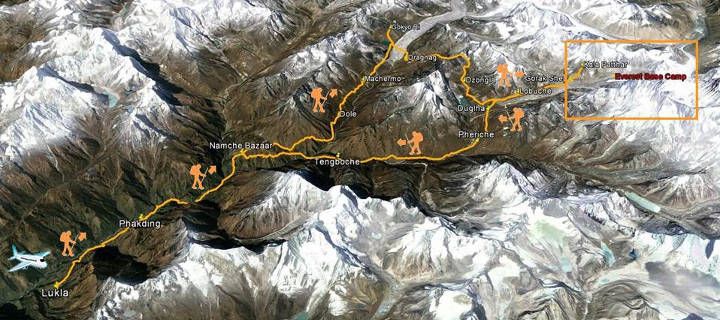
For those who don’t want to start their trek by flying into Lukla Airport, the Jiri to Everest Base Camp Trek variation provides a unique alternative. This trek starts with a bus ride from Kathmandu to Jiri from where the trekking starts. Because Jiri is considerably further away than Lukla, this variation will add around 5 days onto the trek.
Here is a standard itinerary for a 14-day Everest Base Camp Trek experience.
Day 1: Arrive in Kathmandu
If you have organised a trip with a tour operator they will usually provide airport transfers, otherwise there are loads of taxis available at the airport. Top tip: make sure to agree a price before getting in the taxi. Meters are sometimes used, but rare. We recommend staying in Thamel (which is about 15 minute drive from Kathmandu airport). There are many hotels in Thamel, Kathmandu, with varying degrees of hospitality.
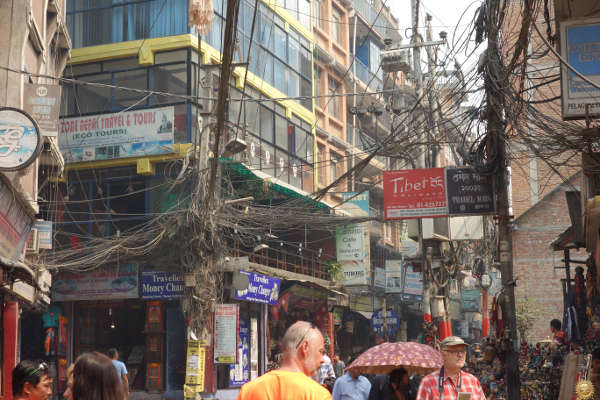
Vibrant streets of Thamel, Kathmandu
Day 2: Fly Kathmandu to Lukla. Trek to Phadking
Weather permitting you will fly from Kathmandu International Airport to Lukla in the morning. Flights to Lukla are prone to delay due to weather. We recommend building as much flexibility into your itinerary to cater for delays (i.e. having a day or two spare after the trek).
If trekking with a tour operator they will have arranged your flight, otherwise you can purchase tickets at the airport for around US$250-$300 return. If you are taking a guide the cost of his flight with be charged at a local rate of about $100 return.
Expect a nerve-racking flight into the famous Lukla Airport that provides great views of the region and of Everest – try to get a seat on the left side of the plane. Once landed, you will start the trek to the village of Phadking – on the way you will pass incredible boulders, carved with Buddhist prayers.
Day 3: Trek from Phadking to Namche Bazaar
This day will be spent trekking from Phadking through Mojo, ending up in Namche Bazaar. Some people cut this day short by stopping in Mojo (if you do the Mount Kailash Teahouse is great, and offers hot showers!).
You will enter the Sagarmatha National Park (a UNESCO World Heritage Site) on this day. You will have plenty of time spent in Namche Bazaar – a small Sherpa market town, with countless sightseeing opportunities including the potential to catch your first glimpse of Everest.
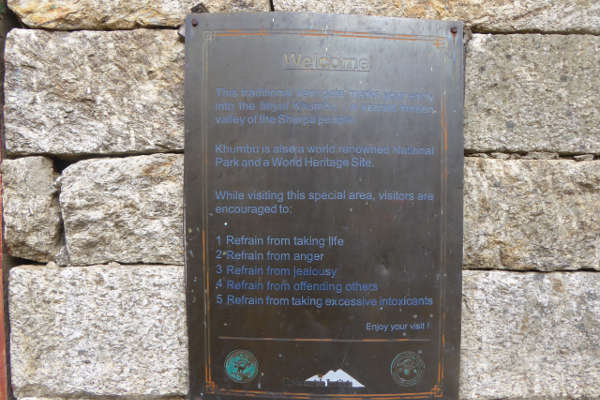
Sign with rules about entering Sagamartha National Park
Day 4: Acclimatization day in Namche Bazaar
At close to 3,500m, Namche Bazaar acts as an important acclimatization stop while doubling up as an opportunity to explore the village and surrounding areas. If it happens to be a Saturday, be sure to check out the market. Most tour guides will take you on a short acclimatization trek to the Everest View Hotel.
If it’s a clear day you should be able to snap some awesome pics of Ama Dablam in the foreground, and Mount Everest in the background. The hotel also provides WiFi at a cost so if you’re looking to call back home or just to connect, bring your device with you. For more information on internet on the trek, check out our detailed article .

Namche Bazaar
Day 5: Trek from Namche Bazaar to Tengboche
The day is spent trekking from Namche Bazaar to Tengboche, the home of the Tengboche Monastery – the largest in the region.
Some variations will take you through the ancient Tibet-Nepal trading route over the Nanpa La pass to Thami.
Day 6: Trek from Tengboche to Periche
The next stop on the trek is Pheriche – the home of the Himalaya Rescue Association . The route takes you through Phangboche, which offers amazing views of Ama Dablam towering above you.
Day 7: Acclimitization Day. Potentially Trek from Pheriche to Dingboche
Pheriche is usually used as a stop for the second acclimatization day. There are various activities to do in the area. Tshola Tsho Lake is a popular destination for trekkers stopping in Pheriche.
Your tour guide might even take you to the nearby village of Dingboche where you will be able to see great views of Lhotse and Island Peak to the east. Dingboche is used as the start to the variation trek to Island Peak .
Day 8: Trek from Pheriche to Lobuche
This day is long and is spent climbing over 600m from Pheriche to Lobuche. On the way, you will pass the well-known Khumbu Glacier as well as various memorials to those Sherpas and climbers who have died on Everest.
You will be able to see Scott Fischer’s memorial here. You will also see Lobuche East (make sure to use the zoom on your camera or if you have binoculars to try see any climbers on the peak)
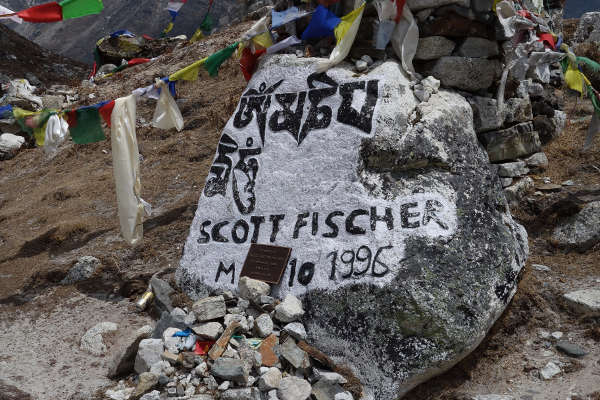
Scott Fischer's memorial
Day 9: Hike from Lobuche to Gorak Shep
Hike from Lobuche to Gorak Shep, the highest permanently inhabited village in the world. Here, you will rest for a while and have something to eat before climbing further to the Everest Base Camp.
The trekker stop point is just before the actual base camp.
Most tour groups are not allowed to enter or stay in Everest Base Camp so take the chance to experience the buzz and excitement of the climbing groups is often limited.
After getting your iconic picture taken at EBC you will descend back to Gorak Shep where you will stay for the night.
Day 10: Gorak Shep to Kala Patthar, then onto Dingboche
Another day of steep trekking allows you to reach Kala Patthar – the highest point on the trek at just over 5,500m. Its location and height result in the best views of Everest, Nuptse and Lhotse in the area. Just hope that the weather is kind to you on this day as it is one of the highlights of the whole trek.
That same day you will descend over 1,000m down to Dingboche where you will spend the night.
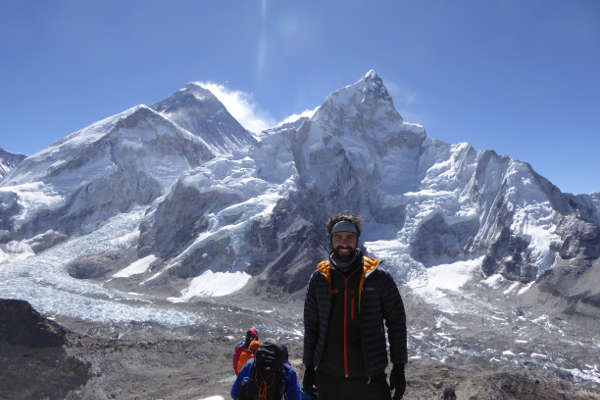
View from Kala Patthar with EBC, the Khumbu Glacier, Nuptse and Mount Everest in the background
Day 11: Hike back to Namche Bazaar from Dingboche
Descend back to Namche Bazaar via Tengboche. Keep your camera on you as you pass through the rhododendron covered slopes – making for a great photo.
Day 12: Hike from Namche Bazaar to Lukla
Return all the way back to Lukla with a long day of hiking. Your last night on the mountain will be spent celebrating in Lukla.
Day 13 and 14: Fly back from Lukla to Kathmandu
Catch the return flight from Lukla to Kathmandu in the morning. Onward travel back home our to your next destination!
More Everest Base Camp hike FAQs
How much does it cost to trek to everest base camp.
You can trek to Mt Everest base camp for as little as $700 if you go solo without a guide. Guided tours that often include return flights to Kathmandu cost around $1000-1300 per person depending on the operator. For a detailed breakdown of costs, see our article on the cost of the Everest Base Camp Trek .
Can you trek to Everest Base Camp independently or without a guide / support?
Yes, but it is only advised for trekkers that have experience of high altitude multi-day trekking, and are comfortable carry 15-20kg a day.
Trekking independently is the cheapest option because you forgo any of the amenities and expertise that is typically offered with a guided trek. You will have to arrange your own domestic flights to and from Lukla airport, and arrange accommodation for each stop in the trek.
If you are comfortable organising the logistics of the trek, then this might be an option for you.
Should I join a guided EBC trek / group?
If this is one of your first high altitude trekking experiences then we recommend using a tour operator and joining a guided group. The typical package will include domestic flights, transport to and from the airport, accommodation for every overnight stop, all permits and passes, porters to carry your luggage and of course the expertise of a guide who will provide you with an insight into the region.
Local tour operators are abundant and often cheaper than western operators, but their level of service will be reflected in their price. Hygiene and ethical standards of some of these operators is also questionable. Prices range from £600 ($750) to £1200 ($1500). To book with one of my vetted local operators, check out our booking platform, Skyhook .
Western tour operators will provide a much more consistent service. Without cutting prices, they offer affordable yet comfortable accommodation and will employ the best guides in the region who will be able to converse in English. Prices range from £1200 ($1500) to £2500 ($3200).
When is the best time to hike to Everest Base Camp?
Contrary to what you might think, the best time to go on the Everest Base Camp trek is not during the height of summer. The spring months of February through May is widely considered the peak season or best time to hike to Everest base camp. This is also the time when the region is at its busiest.
Weather during these months is stable and dry – perfect for trekking and for sightseeing. The lower mountains and foothills are most colourful during this time as well, so you can expect verdant fields and hillsides covered in rhododendrons.
September and October is another popular trekking period on the other side of summer that tends to be a little less busy. Another way to avoid the hustle and bustle of peak season is to try some of the trek variations such as the Gokyo Lakes hike .
Trekking in the winter months (November-January) is still possible, but be prepared for temperatures below freezing. Peak summer is known as monsoon season, characterised by short, sharp downpours. The trails are very wet and trekking during these months is not advised.
Read our detailed article on the best time to trek to Everest Base Camp .

How difficult is the Everest Base Camp Trek?
Contrary to popular belief, Everest Base Camp trek is not very difficult. It requires no prior trekking experience or mountaineering skills of any sort. We have seen people from all walks of life, shapes and sizes completing the trek.
The round-trip length of the trek is 130km, which is spread over just short of two weeks of trekking. Expect to cover around 15km over 5/6 hours of trekking each day – a very achievable number. The hardest part of the trek is the altitude and the effect that it can have on your body.
All good tour operators will factor in acclimatisation days into their itinerary and will aim for a gradual pace of ascent that will ensure your body slowly gets used to the altitude.
We recommend undertaking a gym training programme and practice hikes 6-8 weeks prior to embarking on the trek. Read up more on the difficulty of the EBC trek and how to train for the EBC trek .
Do I need a visa or permit for the EBC Trek?
Yes. If you are a national of a country other than India, you will need to purchase a visa. The 15-day multi entry visa starts at $25 and the 30-day visa goes for $40. The usual guided trek lasts around 15 days, but there is always the possibility of travel delay so we recommending opting for the 30-day visa for a slightly higher price.
You will need a Trekkers Information Management System card (TIMS) as well as a Sagarmatha National Park Entry Permit. Tour operators will include both in their price and will obtain them for you beforehand. If you plan to trek independently, however, you will need $20 for the TIMS card and roughly $40 for the Sagarmatha entry permit.
Make sure you bring at least four passport sized photos in case they are needed for permits.
Will I get altitude sickness on the trek to Mt Everest base camp?
Most people who follow the standard route itinerary, take a gradual ascent with acclimatisation days built in and monitor their symptoms will not suffer from any sort of altitude sickness.
That being said, altitude sickness is not correlated to age or fitness and can affect some people worse than others.
Because it is a potential risk, you must read up about acclimatisation and altitude sickness so that you understand the symptoms and how to prevent them.
What should I pack for the Mt Everest trek?
Condensing a packing list into one short answer is impossible, so we have compiled a very detailed and comprehensive EBC Packing List guide to help you plan and pack for the trek.
It is possible to buy most gear in Kathmandu, but we recommend bringing all the important stuff with you from home. Read our guide for recommendations on what to bring, which brands are trusted as well as items you won’t need during the trek.
What insurance do I need for EBC?
You will need to take out insurance that will cover you for hiking up to altitudes of 6,000m.
Typical travel insurance will not cover this so we have compiled an article that will help you find the right insurance policy that adequately covers delays, accidents and altitude related illness.
World Nomads provide insurance for treks to Everest Base Camp.
Read our detailed guide on travel insurance for the Everest Base Camp Trek .
EBC Trek Route Variations
There are a number of route variations for the trek to Everest Base Camp. Below we briefly discuss the three most popular options.
Gokyo Lakes Trek
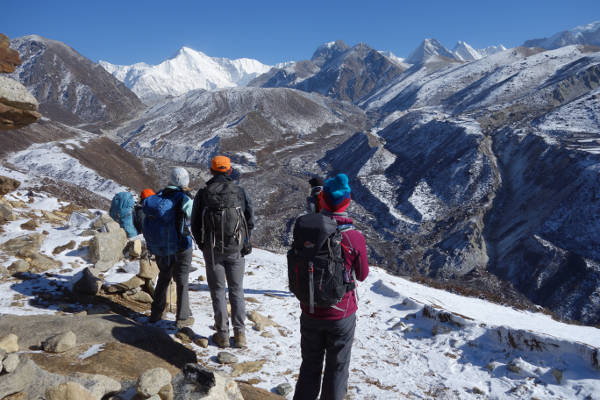
One of the more popular variations of the Everest Base Camp Trek, the Gokyo Lakes Trek , also starts at Lukla and follows the classic base camp trek to Namche Bazaar where it forks north-west.
The trek proceeds through the towns of Dole and Machermo before reaching the stunning Gokyo Lakes. From there you can ascend to the peak of Gokyo Ri in the north, before crossing the Ngozumba glacier and Cho La Pass and re-joining the classic trek at Lobuche.
The detour adds 2/3 days onto the trek but provides the wonderful opportunity to summit a peak while also avoiding some of the busier parts of the trek.
Jiri To Everest Base Camp

This variation of the classic trek offers an alternative to flying into Lukla from Kathmandu to start the trek. The Jiri variation starts with an 8-hour bus ride from Kathmandu to Jiri, where the trek begins.
The variation adds an extra 5/6 days onto the trip as you trek through the Solukhumbu region and make your way past Lukla, where the trek then follows the same route as the classic Everest Base Camp Trek.
It involves a scenic, yet long, bus ride as well as a lot more exposure to the Tibetan and Sherpa cultures. Expect to trek through more forests and streams as you start at the relatively low altitude of 1,800m and work your way up to Lukla and beyond.
Three Passes Trek

The Three Passes Trek is a tougher variation than the classic Everest Base Camp Trek because it involves crossing three very high passes as well as summiting some walking peaks which are not included on the classic trek.
The variation starts by following the classic trek from Lukla to Namche Bazaar before veering west towards Thame and the remote Nangpa Valley. The first of the three passes encountered is the Renjo La, where you will be afforded magnificent views of Everest before descending to the idyllic Gokyo lakes.
The next pass, Cho La, involves walking up a fairly steep and icy trail before reaching a small glacier at the top. From here, you descend and re-join the main base camp trek where you summit Kala Patthar – the iconic viewpoint. You continue onto base camp itself before descending to Lobuche.
You then head east over the third pass of Kongma La and continue onwards to summit the third peak of Chukking Ri. Once again you will have amazing views of the surrounding peaks that you would not get to see on the classic trek. The circuit is completed by returning to Lukla through the main Everest trail.
Island Peak Climb via EBC
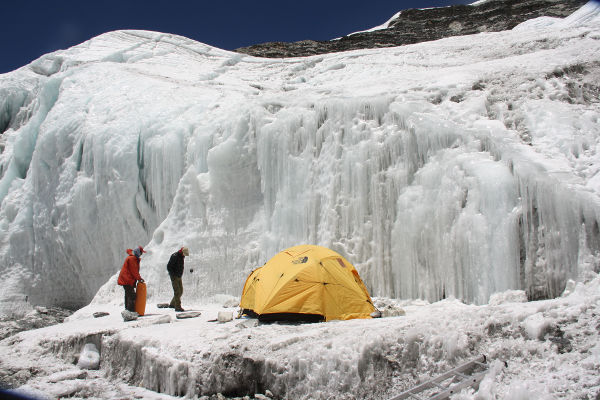
Island Peak is not so much a variation as it is an expedition in it’s own right. Summiting Island Peak is significantly harder than the trekking any of the routes mentioned above, but it does usually involve a visit to Everest Base Camp to acclimatise before the summit attempt. The climb to the peak is not considered technical although it still requires basic knowledge of jumaring, abseiling, using crampons and ice axes. Standing at just under 6,200m, altitude is a real factor.
Most climbers of Island Peak use the traditional base camp trek as a means of acclimatising before heading to the Island Peak Base Camp via Dingboche on the main trail, or by traversing the Chongma La pass. Summiting from the base camp typically takes two days and the whole variation will add around 4 days onto the classic EBC trek.
Recent EBC Blog Posts
Coronavirus pandemic: can i still hike to everest base camp (covid 19 update), mount everest deaths rise due to overcrowding, everest base camp trek packing list – exactly what you need to bring, dj paul oakenfold plays gig at everest base camp, food on the everest base camp trek, teahouses on the everest base camp trek.
References: EBC Trek Guide is maintained by a group of passionate Nepal guides and independent trekkers, many of whom live in Kathmandu and are experts on the trekking trails to Everest and throughout the region. Much of the site is based off personal experiences which are then cross-referenced with secondary sources like trail and travel guides (i.e. Trailblazer, Lonely Planet ), and third party websites. If you find any inaccuracies on the site please contact us.
Tags: Everest Base Camp Trek, Trekking to Everest Base Camp, EBC Trek

EVEREST BASE CAMP TREK

EVEREST BASE CAMP

Pin Tweet Share WhatsApp
THE ESSENTIAL GUIDE
In this guide we cover everything you need to know about the Everest Base Camp Trek in Nepal. This includes suggested itineraries and practical information about accommodation, costs, what to pack, independent vs. guided treks, transport, and more. We also offer a route map with GPX download for use on the trek. And along with this written guide, we also share ‘silent hiking’ films that work well as a visual guide to the trail.
A chance for an adventurous and exciting journey, the Everest Base Camp Trek serves up spectacular scenery and gets you close to the world’s highest mountains, and as one of Nepal’s best known treks, it attracts people of all ages and experience levels. The trek ascends to high altitude (5000 m +) and is challenging, but it is achievable with a sensible itinerary that includes proper acclimatisation. Read on to discover more and start planning your own EBC trek.
Use the drop down menu below to jump to each section of this guide
TABLE OF CONTENTS
EVEREST BASE CAMP TREK OVERVIEW
EBC TREK FILMS
EVEREST BASE CAMP MAP & GPX DOWNLOAD
ELEVATION PROFILE & 3D ROUTE MAP
EVEREST BASE CAMP ITINERARIES
- THE CLASSIC EBC TREK
- EBC TREK VIA KHUMJUNG & PHORTSE
- EBC VIA KONGMA LA (5514 m)
- EBC AND GOKYO LAKES TREK
- BUFFER DAYS
EVEREST BASE CAMP TREK SUMMARY
- LULKA TO NAMCHE BAZAAR
- NAMCHE ACCLIMATISATION DAY
NAMCHE BAZAAR TO DINGBOCHE
- ALT. ROUTE VIA KHUMJUNG & PHORTSE
DINGBOCHE ACCLIMATISATION DAY
Dingboche to everest base camp.
- ALT. ROUTE VIA KONGMA LA
EVEREST BASE CAMP TO LUKLA
- ALT. ROUTE VIA CHO LA & GOKYO LAKES
BEST TREKKING SEASONS
HOW TO GET TO LUKLA
HOW TO GET TO LUKLA WITHOUT FLYING
EVEREST BASE CAMP TREK PERMITS & FEES
TREKKING INDEPENDENTLY
TREKKING WITH A GUIDE (& PORTER)
RECOMMENDED TREKKING AGENCY
ACCOMMODATION ON THE EBC TREK
FOOD ON THE EVEREST BASE CAMP TREK
SAFE DRINKING WATER
WIFI, PHONE SIGNAL & CHARGING
EVEREST BASE CAMP TREK COST & BUDGET
MONEY & ATMs ON THE EBC TREK
WHAT TO PACK FOR THE EBC TREK
ALTITUDE AWARENESS & AMS
TRAVEL INSURANCE
GETTING TO NEPAL
NEPAL TOURIST VISAS
Nepal visa on arrival process.
WHERE TO STAY IN KATHMANDU
BUDGET KATHMANDU ACCOMMODATION
Mid-range kathmandu accommodation, high-end kathmandu accommodation.
MAPS, GUIDEBOOKS & APPS
*Some of the links in this post are affiliate links – if you purchase a product or service via these links, we may earn a small commission at no extra cost to you . This helps offset the cost of running this blog and keeps us travelling so that we can continue to produce great content for you. As an Amazon Associate, we earn from qualifying purchases. We greatly appreciate your support!*
- DISTANCE | 120 -143 km depending on route taken (incl. acclimatisation/day hikes)
- DURATION | 12 – 15 days depending on route (incl. flying to/from Lukla)
- START/END | Lukla
- PERMITS REQUIRED | Khumbu Trek Card 2000 NPR; Sagarmatha National Park Fee 3000 NPR (SAARC nationals 1500 NPR / Nepali nationals 100 NPR)
- TREKKING SEASON | Best Seasons: April to Mid-May , October to Mid-November ; Shoulder Seasons: March, Late May, September, Mid-November to December ; Avoid: June to August, January to February
- TREK DIFFICULTY | Moderate (challenging if including Kongma La or Gokyo Lakes)
- ELEVATION GAIN/LOSS | +/- approx 7600 metres (Classic EBC Trek incl. acclimatisation/day hikes)
- MAX ALTITUDE | 5611 m (Kala Patthar)
- GUIDE MANDATORY? | Khumbu Pasanglhamu Rural Municipality has stated that it is NOT mandatory to trek with a guide in the Khumbu region
- ACCOMMODATION | Teahouses/Guesthouses in villages along the trail
- TREK COST | $35 – $144 USD per person, per day (budget independent trekker to fully inclusive package)
- RECOMMENDED TREKKING AGENCY | Himalayan Masters , Quote HOGG5 for 5% discount
DISTANCE 120 -143 km depending on route taken (incl. acclimatisation/day hikes)
DURATION 12 – 15 days depending on route taken (incl. flying to/from Lukla)
START/END Lukla
PERMITS REQUIRED Khumbu Trek Card 2000 NPR Sagarmatha National Park Fee 3000 NPR (SAARC nationals 1500 NPR, Nepali nationals 100 NPR)
TREKKING SEASON Best Season April to Mid-May October to Mid-November Shoulder Seasons March, Late May, September Mid-November to December Months To Avoid June, July, August January and February
TREK DIFFICULTY Moderate (challenging if including Kongma La or Gokyo Lakes)
ELEVATION GAIN/LOSS +/- approx 7600 metres (Classic EBC Trek incl. acclimatisation/day hikes)
MAX ALTITUDE 5611 m (Kala Patthar)
GUIDE MANDATORY? Khumbu Pasanglhamu Rural Municipality has stated that it is NOT mandatory to trek with a guide in the Khumbu region
ACCOMMODATION Teahouses/Guesthouses in villages along the trail
TREK COST $35 – $145 USD per person, per day (budget independent trekker to fully inclusive package)
OUR RECOMMENDED TREKKING AGENCY Himalayan Masters , Quote HOGG5 for 5% discount
EVEREST BASE CAMP TREKKING FILMS
Get a sense of the Everest Base Camp trekking route in our ‘silent hiking’ style ambient films.
EVEREST BASE CAMP TREK MAP & GPX DOWNLOAD
MAP & GPX DOWNLOAD
We have created a detailed Everest Base Camp trekking map to accompany this guide. It shows the Classic Everest Base Camp trekking route along with the alternative routes outlined in this guide, going via Khumjung and Phorste, Kongma La, and Cho La and Gokyo Lakes. The main side/acclimatisation hike options are included too, and the overland route between Salleri and Lukla is also marked.
Detailed stats and an elevation profile are included for each route section. Guesthouse settlements and tea shops are also marked, as well as key sights and practical info such as checkpoints, hospitals, and transport hubs. Guesthouses as per our own trek itinerary are marked, including info about prices and services, phone numbers (where possible), and a copy of the menu. Photos are included with almost every pin.
You can use the digital map online, or download it for offline use with a mapping app such as Organic Maps, Maps.me or Gaia GPS. This is very helpful for navigation assistance on the trail. It allows you to quickly pinpoint key places and services along the way and calculate distances and elevation differences between destinations.
Note that while we’ve tried to be as accurate as possible when recording and mapping the route, changes on the ground are inevitable (especially on routes crossing glaciers) and this map should not be solely relied upon for navigation.
EVEREST BASE CAMP TREK ELEVATION PROFILE
ELEVATION PROFILE
The image below shows the elevation profile of the Classic Everest Base Camp trek, starting and ending in Lukla. The route shown here includes the various acclimatisation and side hikes as outlined in the suggested itinerary below. Elevation is displayed in metres and distance in kilometres.

3D ROUTE MAP
Watch our 3D relief map video to visualise the landscape and get a sense of the Everest Base Camp trek.
EVEREST BASE CAMP TREK ITINERARY
ITINERARY OPTIONS
There is more than one trekking route to Everest Base Camp . In this section we outline the Classic EBC trek itinerary, but also include three alternative itineraries which enable you to vary your route on the way to and from Base Camp and see much more of the Khumbu region.
We have created an overview table for each of the Everest Base Camp trek itinerary options. These include trekking distances and approximate trekking times for each day (excluding lunch stops, breaks, etc), as well as stats on elevation gain/loss and sleeping altitude. For each itinerary the assumption is that you will fly into Lukla on the morning of Day 1 and start trekking. You will need to add 3 – 5 days if you plan to travel overland from Kathmandu to Lukla or vice versa.
It is also possible to combine the following itineraries to create your own alternative EBC trek. For example, you could trek via Khumjung, Phortse and Kongma La on the way to EBC, or you could include both Kongma La and Gokyo Lakes. A few minor possible alternatives along the way are noted below each itinerary, such as alternate overnight stops.
If viewing the itinerary tables on a mobile device or tablet, scroll to the right to see the full table or flip your screen to landscape mode
CLASSIC EVEREST BASE CAMP TREK ITINERARY
A classic Everest Base Camp trek itinerary is 11 nights/12 days, following the exact same route on the way to and from EBC. If you have limited time, this is the shortest itinerary you can follow while sticking to safe altitude ascent rates.
DAY 1 ALT. INFO*
*Alternatively, continue to Monjo (2830 m) where fewer people stay overnight (a further 5.1 km, approx 2 hours trekking time) . Doing this means the trail will be less busy for both your Phakding to Monjo section, and the Monjo to Namche section the following morning.
DAY 4 ALT. INFO**
**Alternatively, continue to Pangboche (3950 m) where fewer people stay overnight (a further 4.2 km, approx 1.5 hours trekking time). Pangboche is a lovely village with fantastic views of Ama Dablam, and there are many guesthouses. Tengboche, on the other hand, only has two guesthouses and it can be difficult to get a room here in peak season. Continuing to Pangboche also means the trail will be less busy for both your Tengboche to Pangboche section, and the Pangboche to Dingboche section the following morning.
DAYS 8 & 9 ALT. INFO***
***On days 8 and 9 the classic itinerary that most people follow is to visit EBC after lunch at Gorak Shep, then hike up Kala Patthar in the dark for sunrise the next morning (when it is bitterly cold). If you swap these two around as per the above suggested itinerary, you are guaranteed to have a less busy experience at both EBC and on the trail up Kala Patthar. As the skies are usually clearer in the morning you are also likely to have better views at EBC, however it is possible that the views from Kala Patthar will be obscured by afternoon clouds. If you’re lucky and have clear afternoon skies, then you will be treated to a fiery sunset glow on Everest and the surrounding mountains. If you hike up Kala Patthar in the morning, your mountain views will be brief as the sun rises directly behind Everest and you’ll soon be looking directly into the sun.
ALTERNATIVE EVEREST BASE CAMP TREK ITINERARY VIA KHUMJUNG AND PHORTSE
Our first alternative Everest Base Camp trek itinerary is 12 nights/13 days. This itinerary follows a different route between Namche Bazaar and Pangboche on the way to EBC, by trekking via Khumjung and Phortse. The overall difficulty of this route remains moderate, and the additional day allows you to explore more of the region and gives more time for acclimatisation. It’s also a great option for avoiding crowds during the peak trekking seasons, as far fewer people trek this alternative route.
DAYS 9 & 10 ALT. INFO**
**On days 8 and 9 the classic itinerary that most people follow is to visit EBC after lunch at Gorak Shep, then hike up Kala Patthar in the dark for sunrise the next morning (when it is bitterly cold). If you swap these two around as per the above suggested itinerary, you are guaranteed to have a less busy experience at both EBC and on the trail up Kala Patthar. As the skies are usually clearer in the morning you are also likely to have better views at EBC, however it is possible that the views from Kala Patthar will be obscured by afternoon clouds. If you’re lucky and have clear afternoon skies, then you will be treated to a fiery sunset glow on Everest and the surrounding mountains. If you hike up Kala Patthar in the morning, your mountain views will be brief as the sun rises directly behind Everest and you’ll soon be looking directly into the sun.
EVEREST BASE CAMP VIA KONGMA LA TREK ITINERARY
Our second alternative Everest Base Camp trek itinerary is 13 nights/14 days. This changes the route taken between Dingboche and Lobuche on the way to EBC by crossing a high pass called Kongma La (5514 m). This section is more challenging than the rest of the route, but it offers incredible scenery and the chance to explore much quieter sections of trail than you’ll experience on the classic EBC route.
DAY 8 ALT. INFO**
***There are two viewpoints on the Chukhung Ri acclimatisation hike, the lower one (5380 m) which most people visit and the higher one (5516 m) which involves a tough and steep climb towards the end.
DAYS 10 & 11 ALT. INFO****
****On days 8 and 9 the classic itinerary that most people follow is to visit EBC after lunch at Gorak Shep, then hike up Kala Patthar in the dark for sunrise the next morning (when it is bitterly cold). If you swap these two around as per the above suggested itinerary, you are guaranteed to have a less busy experience at both EBC and on the trail up Kala Patthar. As the skies are usually clearer in the morning you are also likely to have better views at EBC, however it is possible that the views from Kala Patthar will be obscured by afternoon clouds. If you’re lucky and have clear afternoon skies, then you will be treated to a fiery sunset glow on Everest and the surrounding mountains. If you hike up Kala Patthar in the morning, your mountain views will be brief as the sun rises directly behind Everest and you’ll soon be looking directly into the sun.
EVEREST BASE CAMP AND GOKYO LAKES TREK ITINERARY
Our third alternative Everest Base Camp trek itinerary is 14 nights/15 days. This varies the route taken between Lobuche and Namche Bazaar on the way back from EBC, by crossing a high pass called Cho La (5368 m) and descending via the spectacular Gokyo Lakes. Again, this route is more challenging than the classic or first alternative EBC itineraries we suggest, due to the extra distance and overall elevation gain. However, it is a highly rewarding trek which includes some of the most spectacular locations in the Khumbu region. The sections of trail that you must repeat on the way to and from EBC are kept to an absolute minimum on this itinerary.
IMPORTANCE OF BUFFER DAYS
Building in buffer days to your Everest Base Camp itinerary is highly recommended, especially if you plan on flying to/from Lukla. Flights are regularly cancelled due to poor weather conditions, sometimes for a number of days. If everything runs smoothly, it takes half a day or less to get to/from Lukla at the start/end of your trek. However, if flights are not operating, it can take up to 3 days to travel overland from Kathmandu to Lukla, using a mixture of buses and jeeps, and by trekking too. Therefore, it’s wise to have at least 3 or 4 days between the end of your planned trek itinerary and any international flight. This would allow you time to get from Lukla to Kathmandu overland if necessary.
Of course, a delay could also happen at the start of your trek while trying to get to Lukla, and this might leave you struggling to catch up with your original itinerary. Having a couple of buffer days built in will mean you don’t have to drastically alter your itinerary, avoiding the need to walk extra long distances to save a day or skipping places because you don’t have time.
Buffer days also allow you to alter your itinerary on the go more easily. For example, if you get sick and need to spend an extra night somewhere, or the weather is bad and you want to wait it out before continuing your trek, then you have the extra days on hand.
It’s worth knowing that should everything go to plan and you don’t need to use any buffer days during your trek, it’s straightforward for a trekking agency to change the date of your flight, bringing it forward a few days for example. However, this is not so easy if you have booked your flight online, independently.
OUR RECOMMENDED TREKKING AGENCY
We partnered with Himalayan Masters for our Langtang Valley, Gosainkunda, EBC and Everest Three Passes treks, and found them to be professional and committed to a high level of service
To enquire about booking your own trek, get in touch via email at [email protected] and mention the code HOGG5 to get a 5% discount off the cost of your trip
ROUTE SUMMARY
LUKLA TO NAMCHE BAZAAR
The first two days of the Everest Base Camp trek are repeated in reverse on the final day of the trek. With only one route connecting Lukla and Namche Bazaar, unfortunately there’s no avoiding this.
This section of the trek passes through numerous villages and teahouse settlements, the last of which is Jorsale, shortly beyond the entrance to Sagarmatha National Park. There are five suspension bridges to cross, including the 125 metre high Hillary Bridge, and numerous smaller fixed metal bridges. The Khumbu Trek Card Registration desk (where you get your Khumbu Trek Card and pay your Sagarmatha NP entrance fee) is shortly beyond Lukla, and there are further checkpoints at Toc Toc, Monjo, and just before Namche Bazaar.
The route follows a mixture of wide stone paths, riverside paths, and forest trail, with plenty of up and down along the way. There is one notable ascent, a 700 metre climb immediately after crossing the Hillary Suspension Bridge, on the last stretch before Namche. This section is a pleasant couple of days and a good introduction to the trek, with greenery and the chance to see colourful rhododendrons and blossoms in spring, plenty of scenic river views, and a definite buzz thanks to all the people coming and going and the numerous villages dotting the trail.
With only one route up and down to Namche, traffic jams are common along this section, with trekkers, porters, and pack mules, yaks and their handlers all sharing the same trail. Bottlenecks are particularly common at suspension bridges and on the steep climb up to Namche. Be sure to wait on the side of the trail without a drop-off when letting pack animals pass, and don’t start crossing a bridge if you can see them coming in the opposite direction – let them cross first. Finally, stick to the left side when walking by any mani stones, mani walls and prayer wheels, as it’s both common practice and culturally appropriate.
For more detail about this section of the route, see Days 1 and 2 of our Everest Three Passes Route Guide .

The Hillary Suspension Bridge as seen from the valley floor, with the old bridge still in place below

NAMCHE BAZAAR ACCLIMATISATION DAY
It’s important to acclimatise properly throughout your Everest Base Camp trek. This allows your body time to get used to the ever-increasing altitude as you ascend to 5000 metres and above. Building in rest days, staying well hydrated, and going on acclimatisation hikes (where you climb higher during the day but sleep lower at night) are all good ways of helping your body acclimatise.
Unless you are already acclimatised (for example you have been at altitudes of 4000 metres and higher within the previous week), spending a second night at Namche Bazaar is highly recommended and this is standard on virtually all Everest Base Camp trek itineraries. You should do this even if it seems like you feel physically fine.
The most common destination for an acclimatisation hike from Namche Bazaar is the Hotel Everest View (3880 m) , where you can get lunch or a drink and enjoy fantastic views from the terrace. It takes around 3 hours to hike up to the hotel and back down again. A must-visit on the way is Sagarmatha Next , a learning / experience / visitor centre and gallery championing waste management solutions for the Khumbu region.

Morning view over Namche Bazaar from the northeast

Morning view of Namche Bazaar from the northeast
For a longer hike and the chance to see more of the local area, doing a loop via Khumjung is a great option. Khumjung is the largest Sherpa village in the region, with an impressive monastery and a school founded by Edmund Hillary in 1960. The original classroom is now the Sir Edmund Hillary Visitor Centre , another great place to visit and learn about the Khumbu region. The loop hike (including Hotel Everest View) is around 7.5 km, and you should allow up to 5 hours for the hike. It’s also possible to include a visit to Khunde village, home to another monastery. This would extend the loop route to around 9.1 km and you should allow up to 6 hours.
If you plan to overnight at Khumjung on day 4 of your trek, following the ‘Alternative Everest Base Camp Itinerary’ outlined above, you might want to opt for a shorter Namche acclimatisation hike. Hiking 100 metres up to the helipad on the western side of the village is a good choice. There is an excellent view over Namche from here, where you can see it curving around the sloping hillside in amphitheatre-like fashion.
Various Namche acclimatisation hiking routes are marked on our EBC Trek map .
CLASSIC ROUTE VIA TENGBOCHE
This two-day section of the Everest Base Camp trek offers fantastic mountain scenery and a beautiful trekking trail, passing through forest and open hillside. There is one notable big climb between Phunki Thanga and Tengboche but otherwise the trail is mostly straightforward, with just a few short steep sections, and plenty of flat, undulating, or gentle climbs. There are a handful of small villages along the route, two suspension bridges, a checkpoint at Phunki Thanga, and an impressive monastery at Tengboche which is well worth visiting (daily 7am – 8am, 9am – 11am, and 1pm – 5:30pm, monks chanting at 3pm). After Pangboche you are more or less above the treeline, surrounded by imposing mountains and expansive views.
For more detail about this section of the route, see Days 4 and 5 of our Everest Three Passes Route Guide .

Trekkers pass through Shomare on the way to Dingboche, with the twin peaks of Ama Dablam rising behind

Trekkers pass through the village of Shomare on the way to Dingboche, with the twin peaks of Ama Dablam rising behind
ALTERNATIVE ROUTE VIA KHUMJUNG AND PHORTSE
This three-day route section follows an alternative trail between Namche and Pangboche before joining the classic Everest Base Camp trail for the final stretch to Dingboche. Opting for this itinerary allows you to vary your route on the way to and from EBC and take advantage of much quieter trails. Plus, the extra day allows for a slower ascent pace, which is a good option for anyone who knows they are slow to acclimatise or prefers to follow a more cautious itinerary.
This route climbs initially to Khumjung, the largest Sherpa village in the region, then stays above the ‘Classic EBC’ route to Pangboche, offering fantastic views throughout. There is a small guesthouse settlement at Mong La (3970 m) which is the highest point on the way to Phortse, a scenic village with a number of guesthouses, local homes, and the Khumbu Climbing Centre .
There is plenty of up and down on this section of the trek, with some notable climbs to Khumjung, Mong La, and both before and after Phortse. However, this route is not considerably more challenging than the ‘Classic EBC’ route, especially as it is split over three days instead of two.
Spending two nights at Dingboche, a sizeable village situated at 4300 m, is advisable in order to ensure you ascend to very high altitude at a safe rate. Going on an acclimatisation hike is also an important part of acclimatising to such altitudes, and Nangkartshang Peak (5039 m) is a great option. This hill rises to the north of Dingboche and there are fantastic views throughout the climb, especially of Ama Dablam. There is an obvious path all the way to the rocky top, which is festooned with prayer flags and spacious enough for plenty of people. The 766 metre climb should take around 2.5 – 3 hours, with the descent about half that. It’s advisable to start early (around 7:30am) for the best chance of clear views and calm conditions.

After a 760 metre climb, people rest and enjoy the views at the prayer flags on Nangkartshang

For a longer and less busy acclimatisation hike, a great option is the side hike up the valley to the east of Dingboche to Chukhung Village and Chukhung Ri, a viewpoint situated at 5380 m. The views from Chukhung Ri are fantastic, looking back down the valley and across to an impressive ice wall, and you’ll be surrounded by numerous majestic snowy peaks including Lhotse, Nuptse, Island Peak and Ama Dablam. Allow up to 8 hours for this return hike.

Plenty of outstanding views to appreciate while hiking up to Chukhung Ri

Plenty of outstanding views to stop and appreciate while hiking up to Chukhung Ri
Whichever acclimatisation hike you decide to do, ensure you have plenty of water, snacks, and warm layers with you.
For more detail about these hikes, see Day 6 (Nangkartshang) and Day 8 (Chukhung Ri) of our Three Passes Route Guide.
CLASSIC ROUTE
If you’re following the Classic EBC route you’ll trek from Dingboche to Base Camp over 2 – 2.5 days, spending a night at Lobuche and then at Gorak Shep. From Gorak Shep you’ll do a return hike to EBC. Most people also include a side hike to Kala Patthar, the highest point of the trek at 5611 m, where you can get a view of Mt Everest (which isn’t actually visible from Base Camp.)
The route heads up the valley to the northwest of Dingboche, climbs to Thok La pass, then heads northeast, running parallel to the Khumbu Glacier all the way to Base Camp. It’s a gradual ascent for most of the way, but at these altitudes (4300 m – 5300 m) even a gentle climb can take your breath away. The climb to Thok La on the way to Lobuche, the short but steep climb on the way to Gorak Shep, and the undulating rocky glacier section immediately before Gorak Shep are among the most challenging sections.
The views are wonderful throughout and the final sight of Everest Base Camp, encircled by soaring peaks, is a memorable one. This is especially true if you’re trekking during the peak climbing season, when a sea of tents sprawls across the glacier at the foot of the Khumbu Icefall – seen from the trail, these tiny yellow dots emphasise the enormity of the surroundings even more.

First sight of Everest Base Camp from the trail

Posing for the obligatory photo on the ‘EBC Rock’
Seen from the Kala Patthar trail about 30 minutes before sunset , the clouds part to reveal the summit of Mount Everest (8849 m)
Lobuche is a small settlement of guesthouses on the edge of the Khumbu Glacier, a very busy spot where everyone going to and from EBC stops for food and/or spends the night. Gorak Shep is even smaller, busier, and more basic with just four guesthouses and no good water supply.
For more detail about this section of the route, see Days 10 and 11 of our Everest Three Passes Route Guide .
ALTERNATIVE ROUTE VIA KONGMA LA
This alternative route to Everest Base Camp is a three day trek between Dingboche and Lobuche, via Chukhung, Chukhung Ri and Kongma La. At Lobuche you rejoin the classic route for the final section to Gorak Shep, Kala Patthar and EBC. This is part of the Everest Three Passes trek and is a challenging but very rewarding addition to the EBC trek. With far fewer people trekking this route compared to the Classic EBC route, you can expect the trail to be much quieter.
The route follows a gently ascending trail up the scenic valley to the northeast of Dingboche before reaching the small guesthouse settlement of Chukhung. It’s advisable to spend two nights here, using the extra day for an acclimatisation hike to the spectacular viewpoint of Chukhung Ri (5380 m) before crossing Kongma La the following day. The scenery around the village is very dramatic, as are the views seen throughout the hike to Chukhung Ri, with Ama Dablam rising to the south, Island Peak to the east, and Lhotse and Nuptse to the north, along with countless other peaks and the dramatic ice wall of the Chukhung Glacier.
The trek to Kongma La (5514 m) involves a long ascent but other than a couple of short steep sections, it’s mostly a steady climb, and the landscape is striking. From the pass you have incredible 360 degree views and you can see all the way down to Lobuche, a small cluster of buildings on the far side of the rocky Khumbu Glacier. The descent is somewhat steep and slippery at first due to loose dirt, shale, and small rocks, but becomes less steep as you work your way down to the eastern side of the glacier. The final section, crossing the glacier itself, involves plenty of up and down as you work your way across jumbled rocks and around small glacial lakes; on the other side, a final downhill stretch leads to Lobuche.
For more detail about this section of the route, see Days 7 – 9 of our Everest Three Passes Route Guide .

On the final approach to Kongma La

The Classic Everest Base Camp trekking route follows the same trail on the return to Namche Bazaar, covering the distance in three days with overnights at Pheriche, Namche, and Lukla. As you drop in altitude more oxygen flows through your blood and the physical strain on your body reduces. This combined with the fact that you no longer need to think about acclimatisation enables you to cover a much greater daily distance than on previous days. The return section of the trek is not all downhill however, and three 17 – 19 km days in a row can be very tiring!
ALTERNATIVE ROUTE VIA CHO LA AND GOKYO LAKES
An alternative route connects Lobuche and Namche Bazaar via Cho La and Gokyo Lakes. This turns your trek into a loop hike commonly known as the Everest Base Camp and Gokyo Lakes trek. Following this route over six days, you’ll cross Cho La (5368 m), a high pass to the west of Lobuche, descend from the pass and traverse the rocky Ngozumpa Glacier to reach Gokyo and a string of brilliant blue lakes, then follow the Gokyo Valley back to Namche where you’ll join the trail to Lukla. The route takes in some of the best scenery in the Khumbu region and is a fantastic alternative to the Classic EBC trek, although definitely more challenging with the addition of the high pass.
This route diverges from the classic trail a little south of Lobuche, working its way around a hillside to the northwest to reach the small guesthouse settlement of Dzonglha. The ascent to Cho La on the next morning is initially gradual, after which there are a couple of steep sections and the crossing of an icy glacier (microspikes recommended) just before the pass. The descent starts off steeply (aided by a fixed metal rope) before becoming more gradual as it works its way down the valley to the guesthouses at Dragnag (Thangnak). On the following morning* you have to cross the Ngozumpa Glacier, the largest glacier in Nepal, with a rocky, undulating trail passing small glacial lakes to reach Gokyo on the other side. The descent onto and climb off the glacier is quite steep.
*If you are looking to save a day it is possible to continue to Gokyo after crossing Cho La, without spending the night at Dragnag (Thangnak). It will very much depend on your energy levels and the weather conditions on the day.

Trekkers crossing the icy glacier towards Cho La (5368 m), the rocky dip ahead

Gokyo, a medium-sized teahouse village, sits on the western side of the glacier, on the shores of Dudh Pokhari, or Gokyo 3rd Lake. The setting is beautiful. You can visit the 4th Lake on a side hike to the north, and climb the steep trail to Gokyo Ri early the next morning for some of the most impressive views in the region. The return to Namche Bazaar is via the Gokyo valley, following the Dudh Koshi river. A good option is to break your journey at the small village of Dole, then continue beyond Namche to overnight at Monjo before the final stretch back to Lukla.

Early morning at Gokyo

Beyond Dole the trail descends towards Phortse Tenga, then climbs to Mong La, on the same route as outlined in the ‘Alternative Route via Khumjung and Phortse’ section. From Mong La it’s possible to descend all the way to Sanasa and take the same trail back to Namche that you followed on the way to Tengboche, or stay higher and follow a trail to the large Sherpa village of Khumjung before descending to Namche. The route between Namche and Lukla is the same as at the start of the trek.
For more detail about the Everest Base Camp to Gokyo section of the route, see Days 11 – 15 of our Everest Three Passes Route Guide .
SEE MORE FROM NEPAL

Everest Base Camp Trek: The Essential Guide

Everest Three Passes Trekking Route Guide

Everest Three Passes Trek: The Essential Guide

Gosainkunda Helambu Trekking Route Guide

Gosainkunda Trek: The Essential Guide

Langtang Valley Trekking Route Guide

Langtang Valley Trek: The Essential Guide

What To Pack For Trekking In Nepal

Upper Mustang Trek: The Essential Guide

Upper Mustang Trek Itinerary: A Day By Day Account

Annapurna Circuit Trek: The Essential Guide

Annapurna Circuit Trek Itinerary: A Day By Day Account

Manaslu Circuit Trek: The Essential Guide

Manaslu Circuit Trek Itinerary: A Day By Day Account
Everest base camp trekking season.
TREKKING SEASON
Like many treks in Nepal , the peak seasons for trekking the Everest Base Camp route are April to mid-May and October to mid-November . These months typically offer the best chance of both clear skies and warmer temperatures, although weather patterns are becoming increasingly unpredictable in Nepal and across the world, so you should still be prepared for snow and colder temperatures during these periods.
The spring trekking season coincides with the Everest climbing season , so the Khumbu region is very busy with helicopters and yaks transporting supplies to Everest Base Camp. If trekking at this time, you will have the chance to see base camp fully set up with all the tents, and there is a great buzz about the place. Outside of the climbing season, there are no tents or any other infrastructure at EBC.

Trekkers crossing the moraine-covered glacier between Lobuche and Gorak Shep on a clear skies spring morning

Trekkers crossing the moraine-covered glacier before Gorak Shep on a clear spring morning
In autumn, expect less wind and higher temperatures than in spring, while in late March and April, blooming rhododendrons and other spring flowers are a beautiful sight at some lower elevations.
The shoulder seasons are March, May, September and mid-November to December. During these times it can be much quieter on the trail. There is typically cold weather in March and December. In March there is a high chance of lingering or fresh snow. December typically has sunny weather and clear skies throughout the day. In late May and early September there is a higher chance of early or lingering monsoon rains and cloudy skies.
The summer months of June, July, and August coincide with the monsoon season . Trekking during this period means lots of walking in rain, muddy trails, leeches, and poor visibility with clouds obscuring the surrounding mountains. Many guesthouses close during this period, and it is not a good time to trek. Flights to and from Lukla are likely to be cancelled regularly and for days at a time.
The winter months of January and February are considered too cold by most to trek and many guesthouses are closed.
PLAN A TREK IN THE LANGTANG VALLEY

PLAN YOUR LANGTANG VALLEY TREK WITH OUR COMPLETE GUIDE

DETAILED TRAIL NOTES AND OTHER INFO FOR THE LANGTANG TREK
Lukla is the gateway for all treks in the Khumbu region, including Everest Base Camp, Everest Three Passes , and Gokyo Lakes. Nestled in the mountains at 2855 m, the closest dirt-road access is approximately 1 day’s walk away, with a tarmac road 3+ days’ walk away. The majority of people arrive in Lukla by air, landing at the small runway or helicopter pad at Tenzing-Hillary Airport (LUA). If you prefer not to fly, it’s possible to get to Lukla overland in 3+ days, by taking a bus/jeep then trekking on foot.
FLYING TO LUKLA
Flights to Lukla operate year-round from either Kathmandu or Ramechhap/Manthali (approx 4 hours’ drive from Kathmandu), although cancellations and delays are common as flights can only run in favourable weather conditions. The flight time is 30 minutes from Kathmandu, and 15 minutes from Ramechhap/Manthali. The Lukla runway is just 527 metres long and is sloped at an 11.7% gradient, making taking off and landing challenging for pilots and a little daunting for passengers.
Flights are operated by Tara (Yeti) Air , Summit Air , and Sita Air , with each company using small 15 seater twin propeller planes . Flights usually only operate in the morning, when the skies are clearer and there is less wind. There is a weight limit of 10 kg checked baggage + 5 kg hand baggage . The cabin is not pressurised and it’s very noisy. There are no assigned seats. For the best mountain views, try to sit on the left while flying to Lukla and the right on the return flight.
During peak trekking and climbing seasons , Lukla flights operate to and from Ramechhap/Manthali in order to ease congestion at Kathmandu Airport. The dates change annually, but this is roughly April 1st – May 20th and September 20th – November 20th . See below for how to get from Kathmandu to Ramechhap/Manthali.

The runway at the Tenzing-Hillary Airport in Lukla, sloped at an 11.7% gradient and just 527 metres long

The runway at Tenzing-Hillary Airport in Lukla, on an 11.7% gradient and just 527 metres long
Flight tickets cost $180 one way from Kathmandu and $152 one way from Ramechhap/Manthali . You can book online directly with the airline, or via an agency in Kathmandu. If you are booking an inclusive trekking package, for example with our recommended local trekking agency Himalayan Masters , your flight will be organised for you. Booking the earliest possible flight time is best as clouds tend to move in and the wind picks up through the morning, with later flights more likely to be cancelled. Note that agencies sometimes have access to earlier flights than are available to book online.
It is free of charge to change your flight date (in advance by calling the airline or in person at the airport) and it’s a good idea to reconfirm the day before you fly to avoid being bumped onto a later flight. Again, if you have booked through a trekking agency, they can take care of any flight changes and reconfirmations for you. This makes the whole process much more straightforward than if you have booked independently (especially if you’re trying to make changes while trekking with limited phone service or internet connection).
Be aware that it can be a bit chaotic at the airport and being bumped onto a different flight time and/or standing around confused about what’s happening is pretty normal. The situation is certainly easier to manage if you are with a guide, who will be used to the process, speaks the local language, and will take care of everything for you.
FLYING TO PHAPLU/SALLERI
Sometimes when flights can’t depart for Lukla, there is an option to fly to Phaplu (2 km north of Salleri) instead. From Phaplu it’s possible to trek to Lukla in about 3 days, or you can take a jeep as far as Thamdada (subject to road conditions) and trek the remaining distance to Lukla in 1 day.
See stages 2 and 3 in the ‘how to get to Lukla without flying’ section below for more details.
HOW TO GET FROM KATHMANDU TO RAMECHHAP AIRPORT (MANTHALI)
You can get from Kathmandu to Ramechhap Airport (RHP) (also known as Manthali) by public bus, shuttle bus, or private car. The journey takes around 4 hours.
Public buses depart between approx 0600 – 1100 from Ratna Park (also known as Old Bus Park) near Thamel, costing approx 600 NPR ($4.50 USD). The journey takes around 4 – 5 hours. You will need to spend one night at a guesthouse in Manthali before flying to Lukla the following morning. There are guesthouses within walking distance of Ramechhap Airport. You can just show up and buy a bus ticket on the day. Buses arrive at the Manthali Bus Park .
Shuttle buses depart from the Thamel area of Kathmandu at 0130 and 0200, allowing you to fly to Lukla the same morning. They also depart at 1100, if you prefer to travel during the day and spend one night in Manthali before flying to Lukla. The journey takes about 4 hours. You must make a reservation in advance. You can do this via a local agency, ask staff at your accommodation to help, or book online via Viator or Get Your Guide . Tickets cost up to $30 USD.
A private car costs approx 14000 NPR ($100 USD), which can be shared by up to 4 passengers. The road condition does not require a jeep/4×4 vehicle. The journey takes about 4 hours, with door-to-door service. You can book a private car via a local agency or ask staff at your accommodation to help organise it.
For the return journey from Ramechhap/Manthali to Kathmandu you must pre-arrange your shuttle transfer or private car transfer. If travelling back to Kathmandu by public bus, you should be able to get one from the Manthali Bus Park after arriving on the flight from Lukla.
HELICOPTER TO LUKLA
It is also possible to fly from Kathmandu to Lukla by helicopter. Helicopters can often fly in weather conditions that would ground twin propellor planes, they are generally considered safer, and they operate out of Kathmandu Airport year-round (unlike planes which only depart from Ramechhap/Manthali during peak season). Flying by helicopter is considerably more expensive though, costing around $500 USD one way per person (assuming there are enough people to fill five seats). You can book via a local travel or trekking agency, or book online in advance via Viator .

Morning mountain views on the helicopter ride to Lukla

Morning mountain views on the helicopter ride
It’s possible to get to Lukla without flying by using a combination of bus and/or jeep and trekking. This takes 3 – 5 days. Eventually there will be a road built all the way to Lukla, but for now the closest you can possibly get by jeep on a dirt road is Thamdada (1 day walk to Lukla), and by bus or jeep on a sealed road is Salleri/Phaplu (3 – 4 days’ walk to Lukla). Buses and jeeps stop for food and toilet breaks along the way. As the road between Salleri/Phaplu and Thamdada is unsealed, its condition can vary greatly depending on how much rain there has been. Sometimes it’s not possible to drive all the way to Thamdada, and you may only be able to reach Bupsa, Kharikhola, or Adderi.
Although it may be possible to get all the way from Kathmandu to Thamdada in one day, we do not recommend this as it means travelling on a dirt road with challenging hairpin bends and steep sections in the dark. Instead, it’s advisable to spend one night in Salleri where there are lots of guesthouses and travel to Thamdada the following day. At Thamdada, there is a guesthouse (Kare Hotel) at the jeep stop and two more approximately 25 minutes’ walk from the jeep stop. Additionally, there are many more guesthouses at Paiyu, which is around 2 hours’ walk away. It’s also possible to stop shortly before Thamdada to stay at a guesthouse in Kare (approx 1 hours’ walk to Thamdada).
The trekking route from Salleri to Lukla goes via Ringmu, Nunthala, Kharikhola, Bupsa, Kari La (Thamdada), Paiyu and Surke. Common overnight stops are at Nunthala, Bupsa, and Surke, after which you join the classic Lukla (or Cheplung) to Namche Bazaar route. There is a lot of elevation gain and loss on the Salleri to Lukla trekking route, so expect plenty of tiring up and down. The driving route from Salleri to Thamdada goes via Adderi and joins the trekking route shortly before Kharikhola.
KATHMANDU TO LUKLA OVERLAND STAGES
Step 1 // drive kathmandu to salleri/phaplu.
9 – 12 hours travel time (mostly sealed road); Phaplu is about 2 km north of Salleri
B us is approx 1700 NPR ($13 USD); departs from Chabahil Chowk (approx 0430) or from Koteshwor Chowk (approx 0500); no advance booking required
Shared Jeep is approx 2600 NPR ($20 USD) per person; d eparts from Chabahil Chowk and Koteshwor Chowk ( approx 0500); b est to reserve seat in advance (ask local travel agency or accommodation staff)
Private Jeep is approx $280 (can be shared between up to 7 people); d oor-to-door service, depart any time in morning; b ook via a local travel/trekking agency
STEP 2 // DRIVE SALLERI/PHAPLU TO THAMDADA (or Bupsa, Kharikhola, Adderi or elsewhere depending on road condition)
6 – 7 hours travel time (unsealed road)
Shared Jeep is approx 2600 NPR ($20 USD) per person; d eparts approx 0600; b est to reserve seat in advance; (ask your accommodation owner to book when you arrive in Salleri)
Private Jeep is approx $235 (can be shared between up to 7 people); d oor-to-door service, depart any time in the morning; b ook in advance in Kathmandu via a local travel/trekking agency
STEP 3 // TREK THAMDADA TO LUKLA OR CHEPLUNG
You can bypass Lukla itself and join the trail to Namche at Cheplung instead (you can get your Khumbu Trek Card from the checkpoint at Toc Toc as you will not pass the checkpoint at Lukla). There is a lot of up and down on this section. It is possible to cover the distance over two days if you prefer, staying at a guesthouse along the way (for example at Chheubas or Surke). The route and villages/guesthouses along the way are marked on our map .
To Lukla: 13.3 km | approx 7 hours trekking time | +1870 m / – 1744 m
To Cheplung: 13.9 km | approx 7 hours trekking time | +1785 m / – 1825 m
EVEREST BASE CAMP TREK PERMIT AND FEES
PERMIT AND FEES
You need two permits for the Everest Base Camp trek. Both are issued locally in the Khumbu region so you don’t need to organise permits in advance in Kathmandu. You will need your passport and the fee in cash in Nepalese rupees.
Keep your permits in a safe place as you will need to show them at various checkpoints during the trek.
KHUMBU TREK CARD
Issued at checkpoint (Lukla or Toc Toc)
C an register in advance online (not mandatory)
SAGARMATHA NATIONAL PARK FEE
(1500 NPR SAARC nationals/ 100 NPR Nepali nationals)
Pay at checkpoint in Lukla or NP entrance beyond Monjo
TREKKING EVEREST BASE CAMP INDEPENDENTLY
The Nepal Tourism Board announced on March 9th 2023 that as of April 1st 2023, all international trekkers in Nepal are required to hire a licenced trekking guide and obtain the TIMS card through an authorised trekking agency registered with the government of Nepal.
However, the Khumbu Pasanglhamu Rural Municipality has confirmed that it is NOT mandatory to trek with a guide in the Khumbu region. This means that you do not need to have a guide for the Everest Base Camp trek , or indeed for any other trek in the region such as the Gokyo Lakes or Three Passes treks. We have included copies of the official press release from April 2nd 2023 and an info card from September 2023 stating that a guide is not mandatory in the Khumbu region. You can check the Khumbu Pasanglhamu Rural Municipality Facebook page for any further updates.

PROS AND CONS OF INDEPENDENT TREKKING IN NEPAL
While having a guide in the Khumbu region is not mandatory, this does not mean that trekking to EBC independently is the right decision for you, especially if you are an inexperienced high altitude trekker. If you are thinking about doing the Everest Base camp trek without a guide, here are a few thoughts on the pros and cons of independent trekking in Nepal.
This is the cheapest way to trek to Everest Base Camp. You won’t have to pay for anything extra beyond your daily food and accommodation costs, permit fee, and transport to/from the trailhead.
You have complete freedom and flexibility. You can choose how long to trek for each day, what route to take and where to stay. If you like somewhere, you can choose to stay an extra day without having to consult anyone else or consider their needs.
It is easier to enjoy a bit of ‘alone time’ on the trail. If you are trekking with a guide or group it can be harder or more awkward to branch out and enjoy walking alone with your thoughts.
You’ll likely have more interaction with locals. If you are trekking with a guide it is common practice for them to deal with everything at your guesthouse and act as a go-between. It’s normal for your guide to take your order, bring out your food, and settle up the bill on your behalf, which means you may have little interaction with the owner or staff yourself. But, you’ll be doing all that by yourself if you trek independently.
With freedom and flexibility comes more responsibility and the need to do more research, preparation and daily planning. You will need to spend time organising things both on and off the trail. You will need to sort out all the logistics like your permit, transport, and accommodation by yourself, and be confident in your route planning and navigation.
You are more vulnerable in an emergency situation or if you get sick. This is especially true if you are trekking solo. You should prepare as best you can with a comprehensive medical kit, emergency contact numbers at the ready, and ideally an emergency communication device like the Garmin inReach .
In peak trekking season you may find it harder to get a room. Many guesthouses prefer bigger groups with organised companies and will give preference to them over independent solo trekkers or those in small groups. Guides with existing local contacts often call ahead to book rooms, something which isn’t as easy for independent trekkers with no personal contacts. Tengboche, Lobuche, and Gorak Shep all have limited accommodation options and it’s not uncommon for guesthouses here to be full during the peak seasons.
You miss out on all the insights a knowledgeable, English speaking guide can offer. Your understanding of the region, and Nepal in general, is likely to be much broader after spending two weeks in the company of a Nepali guide rather than going it alone.
This is the cheapest way to trek the Everest Base Camp. You won’t have to pay for anything extra beyond your daily food and accommodation costs, permit fee, and transport to/from the trailhead.
You have complete freedom and flexibility. You can choose how long to trek for each day, what route to take and where to stay. If you like somewhere, you can choose to stay an extra day without having to consult anyone else or consider their needs.
It is easier to enjoy a bit of ‘alone time’ on the trail. If you are trekking with a guide or group it can be harder or more awkward to branch out and enjoy walking alone with your thoughts.
In peak trekking season you may find it harder to get a room. Many guesthouses prefer bigger groups with organised companies and will give preference to them over independent solo trekkers or those in small groups. Guides with existing local contacts often call ahead to book rooms, something which isn’t as easy for independent trekkers with no personal contacts. Tengboche, Lobuche, and Gorak Shep all have limited accommodation options and it’s not uncommon for guesthouses here to be full during the peak seasons.
TREKKING EVEREST BASE CAMP WITH A GUIDE (AND PORTER)
TREKKING WITH A GUIDE (AND PORTER)
Although not mandatory, many people choose to do the Everest Base Camp trek with a guide, and often with a porter too. If you are an inexperienced high altitude trekker we would absolutely recommend hiring a guide for this trek, but even if you are experienced, trekking with a guide is a great option. Not only can a guide be invaluable when it comes to your safety, a guide can also enrich your experience on the trail, giving you the opportunity to learn more about the history, culture, and geography of the land. Hiring a porter to carry your bag will put less strain on your body, making your trek much easier and perhaps allowing you to better enjoy the surroundings. Hiring a guide and/or porter also provides jobs and supports the trekking tourism economy.
One guide can accompany a maximum of five trekkers. A porter shouldn’t be asked to carry more than 25 kg, ideally no more than 20 kg. If you pack appropriately, one porter can carry two trekkers’ bags. Ensure that your guide and porter have appropriate clothing and equipment for the trail, including warm clothing for high altitudes (a down jacket, hat, gloves), boots, sunglasses, and waterproofs.
WHAT TO EXPECT WHEN TREKKING WITH A GUIDE
If you are doing the Everest Base Camp trek with a guide you may meet them in either Kathmandu or Lukla. If you meet in Kathmandu, you will travel to the trailhead together and return to Kathmandu together at the end. Professional guides in Nepal are both licenced and insured, and will speak English (sometimes other languages too).
During your trek a guide will walk with you on the trail, suggest the best spots to stop for lunch, and take you to their recommended overnight accommodation. At busy times, they may call ahead and pre-book a room for you. They will act as your go-between at each guesthouse, arranging your room, taking your food orders, and settling the bill. It’s normal for a guide to run through the following day’s itinerary each evening, giving you an overview of the trail, trekking time, and any other relevant information.

A guide can help with many practical things, provide insight into local culture, and be a good companion on the trail

Your guide will always be around at your guesthouse, but they won’t stick by you constantly. You will have plenty of freedom to hang out in your room or the dining room, read your book, chat with other guests, play cards, etc. Guides sleep and eat in the same guesthouse as you, always in a separate room. A guide’s meals and accommodation are usually provided free of charge by guesthouses in exchange for their trekking clients’ custom. If a guesthouse is busy, your guide may share a room with other guides or be obliged to sleep in the dining room.
WHAT TO EXPECT WHEN TREKKING WITH A PORTER
If you’re doing the Everest Base Camp trek with a porter, you will usually meet them locally at the start of your trek. It is not common for porters to travel with you from Kathmandu due to the expense of getting to/from the Khumbu region. Trekking agencies usually have a pool of porters that they work with regularly and can arrange a porter as part of any trekking package. As porters usually do not speak English, your guide will communicate and organise the day-to-day logistics with your porter during the trek.
Porters often go at their own pace so you won’t always trek with them. It’s common to pack your bag and have it ready for them before breakfast, and for your bag to already be in your room when you arrive at your guesthouse for the evening.

A porter putting in the hard work on the Everest Base Camp Trek

CONDITIONS FOR PORTERS IN THE KHUMBU REGION
Conditions for trekking porters across Nepal are far from ideal, however they are particularly poor in the Khumbu region. Unlike in other trekking regions, guesthouse owners in the Khumbu do not permit porters to sleep or eat in their guesthouses alongside trekkers and guides (with the exception of a rare few based on our own experience). Instead, porters sleep and eat at designated Nepali hotels or porter shelters in each village or teahouse settlement in the Khumbu region. Also, unlike in other regions, porters in the Khumbu must pay for their meals, with a large proportion of their daily wage being spent on food.
The conditions in which porters sleep, often in one dormitory-style room with up to 100 or more porters, are much more basic than those experienced by trekkers and guides in guesthouses. Sometimes porter accommodation is full, and porters must walk to a different village to find available accommodation, returning to meet their trekking clients in the morning. This is especially common at Lobuche and Gorak Shep, where limited accommodation means that porters often have to walk for hours, back to Thukla or Pheriche to spend the night before returning early the next morning.
You can read more in the informative paper ‘ Uphill Struggle: Impediments and Facilitators to Porter Health in the Khumbu Region ’ by Nate Barott (2018).

Porters stop for a break at Lawi Schyasa, between Namche Bazaar and Tengboche on the Everest Base Camp trail

HOW TO ORGANISE AN EVEREST BASE CAMP TREKKING GUIDE (AND PORTER)
The easiest way to arrange a trekking guide is via a trekking agency . You can book an inclusive Everest Base Camp trekking package which covers your transport, entrance fees, guide (and porter), accommodation costs, and three meals a day. Alternatively, you can pay for a guide (and porter) only, and then pay-as-you-go for your accommodation, food, transport, and entrance fees (although this involves more day-to-day hassle than opting for an inclusive package).
Choosing a trekking agency is often the trickiest part as there are thousands of registered agencies in Nepal and the quality of service can vary greatly between them. Many trekkers will choose a guide or agency based on a trusted recommendation from a friend or fellow trekker, and this is a good approach. An alternative option is to visit a number of trekking agencies in person when you arrive in Thamel (Kathmandu) to get a feel for a company that you like, or to contact agencies online in advance.
Having trekked with three different agencies and three different guides on three visits to Nepal, our best experience has been with Himalayan Masters . We partnered with them for our Langtang , Gosainkunda Helambu , and Everest Base Camp and Three Passes treks, and found them to be very professional, committed to a high level of service, and competitively priced.
We really appreciate the fact that Sandip, the agency owner, is super flexible when it comes to itinerary amendments that don’t just follow the norm. He’s also a problem solver and what we’d call a real ‘go-getter’, a trait that’s highly valuable to his clients, whether he’s retrieving a swallowed bank card from a Thamel ATM in record time, or fixing logistical issues when things go wrong last minute at 2am (both real life examples experienced by us or fellow Himalayan Masters clients we met on the trail!).
We’d also highly recommend our Himalayan Masters guide, Govinda Rai, who we spent over a month trekking with in Nepal. He is very professional, taking care of everything you would expect from a guide, but also tailoring his suggestions and advice specifically to his clients, resulting in a more enjoyable trekking experience overall. We quickly came to trust his choices for lunch stops and accommodation as we felt they were always among the best options available. His knowledge of the trail was excellent, and his advice on trekking times for each day (based on our own pace) was spot-on, making it easier for us to plan our itinerary and make on-the-go changes as we saw fit. And on a personal level, we found Govinda to be easy-going, friendly, and an all-round great person to spend time with.

Govinda, o ur Himalayan Masters guide

Govinda, our Himalayan Masters guide
We also met a number of other Himalayan Masters guides while out on the trail, including Dipak who we chatted with lots, as our Langtang Valley trek itinerary coincided for three nights at the same guesthouses. From our interactions with Dipak, and positive feedback shared over dining room chats with his two trekking clients, we’re confident that Himalayan Masters are working with great guides across the board.
In addition to our guide, Govinda, we’d also highly recommend our porter, Prakas Tamang, organised last minute for us by Himalayan Masters. He knows the trail inside out, portering on the Everest Base Camp route, along with various others in the Khumbu region, multiple times a season. We felt he went above and beyond his role as a trekking porter, especially when breaking trail for us in snowy conditions while crossing Ngozumpa Glacier and Renjo La.
To discuss planning your Everest Base Camp trek you can get in touch with Himalayan Masters at [email protected] and you’ll get a 5% discount off your trip cost by using our code HOGG5 .
HOW ABOUT TACKLING THE MANASLU CIRCUIT?

DAY BY DAY ACCOUNT
ACCOMMODATION ON THE EVEREST BASE CAMP TREK
Accommodation.
Accommodation on the Everest Base Camp trek is in the form of guesthouses, also known as teahouses or lodges. These can be found regularly along the trail in local villages (such as Namche Bazaar and Dingboche) or in guesthouse-only settlements (such as Lobuche and Gorak Shep). In general, the standard of accommodation is decent on the EBC trek, but it becomes more basic at higher altitude, with accommodation at Gorak Shep (5160 m) the most basic (and the toilets the most unpleasant) of the whole trek.

The accommodation at Gorak Shep (5160 m) is the most basic on the Everest Base Camp Trek, but the mountain views are spectacular

Guesthouses provide both accommodation and meals, and you are expected to eat dinner and breakfast at the guesthouse you sleep at. Lunch is usually at a different guesthouse along the trail, unless you arrive early at your destination for the day.
Rooms are basic, but comfortable. They usually have two single beds, although some places will have rooms sleeping three, or just one. Beds always have a sheet-covered mattress, a pillow with a pillowcase, and a blanket. We have seen plenty of bedding hanging out to dry which would suggest sheets, pillowcases, and blankets do get washed, however there is no guarantee that they will be freshly laundered for each guest. Personally, we always trek with our own sleeping bag and silk liner, using the blanket over our sleeping bag for extra warmth at higher altitudes.
There is always a light in the room, powered by mains electricity or solar. Often there is a small table, some hooks on the wall, and a bin, and there is almost always a window with curtains. Some guesthouses will have charging sockets in the room, but this is not always the case. There is no heating in guesthouse rooms, only ever in the main dining room.
DINING ROOM
Every guesthouse has a dining room where you can eat your meals, drink tea, and hang out. There are usually tables and benches around the perimeter of the room, with plenty of plastic chairs for huddling around the central stove. Expect to see a display cabinet of snacks and sundries for sale (eg. chocolate bars, biscuits, Pringles, toilet paper, soft drinks), and often a Buddhist prayer altar, too. The dining room is the only room with a stove. This is usually lit in the late afternoon or early evening as the sun goes down and it starts to get cold, making it nice and cosy.

The dining room of Mountain Paradise Lodge in Dragnag/Thangnak on the Everest Base Camp and Gokyo Lakes Trek

The dining room of Mountain Paradise Lodge in Dragnag/Thangnak, a small teahouse settlement on the Everest Base Camp and Gokyo Lakes Trek
TOILETS AND SHOWERS
There are usually rooms with attached bathrooms (ensuite) available as far as Dingboche. After Dingboche, rooms with shared (common) bathrooms are generally all that is available. If you have an attached bathroom this will usually have a toilet, sink (not always), and shower. Shared bathroom facilities normally consist of separate toilets and shower rooms, with a sink outside, although sometimes there is no dedicated sink and you’ll need to wash your hands/brush your teeth at an outdoor tap.
Toilets may be sit-down or squat style. Toilet paper is never provided , so you’ll need to pack your own and buy more as you go. Do not flush toilet paper down the toilet, always put it in the bin next to the toilet (this may be an old tin can, a cardboard box, a plastic container, or such like.) Sit-down toilets will likely have an automatic flush, although at higher altitudes in cold weather, the pipes can freeze and you may need to flush the toilet using a bucket of water. Squat toilets never have an automatic flush; you always need to flush using the scoop and bucket of water provided.
A gas shower is usually available although sometimes the water is solar heated. If neither are available, guesthouses can provide a bucket of hot water which you can use to wash. You can expect to pay up to 800 NPR for any kind of hot water shower at guesthouses between Namche Bazaar and Lobuche. There are no shower facilities at Gorak Shep.
COME JOIN US ON INSTAGRAM

FOOD AND DRINK
Every guesthouse serves meals and you are expected to eat dinner and breakfast at the guesthouse you are sleeping at, otherwise the cost of the room will be much higher. There are also a few bakeries, coffee shops, and tea shops along the route where you can pop in for treats.
Every guesthouse has a menu, and the options for breakfast, lunch, and dinner are similar at each. Prices increase the higher you go as food and fuel needs to be transported further via porters or pack animals, resulting in additional costs. Meat is on the menu at most guesthouses (usually buffalo, yak, or chicken), but it’s advisable to stick to vegetarian food; meat is not usually fresh or kept refrigerated and the chance of getting an upset stomach is much greater if you eat it.
EVEREST BASE CAMP TREK MENU
Click into the slider to see a typical example of a menu on the Everest Base Camp trek. This menu is from Dingboche, where prices are more expensive than at lower altitudes but fairly representative of prices above 4000 m.
We have included photos of the menu from every guesthouse that we stayed at on the Everest Base Camp trek in our accompanying map .

Breakfast dishes include porridge, muesli, eggs, Tibetan bread (a kind of fried dough), chapati (flat, unleavened bread), and pancakes . Honey, jam, peanut butter, apples, chocolate sauce, and yak cheese are common accompaniments on offer.
Breakfast options are generally priced between 300 – 1200 NPR (approx $2 – $9 USD), depending on location and item.
LUNCH AND DINNER
Dal Bhat is a ubiquitous Nepali meal , eaten twice a day by many locals. It consists of plain rice, a lentil soup, veggie curry, papad (poppadom), and some sort of pickle. Depending on the veggies available, you may also get saag (spinach) or something similar. Everything is served on a big plate, and you can get free refills of each item (apart from the papad!).

There are always free refills of rice, dal and curry with Dal Bhat , giving rise to the familiar catchphrase ‘Dal Bhat power 24 hour’

With Dal Bhat , t here are always free refills of at least the rice, dal and curry, giving rise to the familiar catchphrase, ‘Dal Bhat power 24 hour’
Other options include various soups (some fresh, some from a packet), basic pasta dishes (usually fried), fried rice, fried noodles, boiled or fried potatoes, and momos (steamed or fried dumplings). Ingredients more or less revolve around eggs, cheese, potatoes, carrots, cabbage, onion, garlic, and tinned tuna.
Lunch and dinner options are generally priced between 350 – 1200 NPR (approx $2.5 – $9 USD), depending on location and item.
Various hot drinks include black/green/milk/masala/mint/ginger lemon honey tea, instant coffee, and hot chocolate . You can order a single cup or a small/medium/large thermos (called ‘pots’). Cups or pots of hot water are also available.
Soft drinks like Coke, Fanta, and Sprite are available to buy at each guesthouse shop, along with bottled water (although we recommend purifying tap water to drink instead of buying bottled water). You can also buy beer (bottles/cans) and small bottles of Khukuri rum , however it’s best to avoid alcohol at higher altitudes as this dehydrates you and makes acclimatisation more difficult.
Hot drinks are on average about 80 – 350 NPR per cup ($0.60 – $2.60 USD), or up to 800 – 3000 NPR per large pot ($6 – $22 USD). Soft drinks are about 300 – 600 NPR ($2.30 – $4.50 USD), bottled water is about 100 – 500 NPR ($0.75 – $3.80 USD), and beer is about 800 – 1200 NPR ($6 – $9 USD).
SNACKS AND DESSERTS
You can buy chocolate bars, biscuits, and Pringles at most guesthouse shops. Other snacks like popcorn, papad, prawn crackers, yak cheese, or french fries are often available on the menu, and you can usually get desserts like apple, Snickers, or Mars spring rolls/fritters/pies/momos.

A typical example of what’s on sale in guesthouses

A fairly typical example of what’s on sale
Prices for Snickers/Mars start from 300 NPR ($2.30 USD), packets of biscuits start from 100 NPR ($.75 USD), and Pringles start from 600 NPR ($4.5 USD). Desserts range from 350 – 900 NPR ($2.70 – $6.80 USD).
BAKERIES AND COFFEE SHOPS
You’ll find bakeries and coffee shops (some with even proper coffee machines!) in various villages along the Everest Base Camp trekking route. These include Namche Bazaar, Tengboche and Dingboche. Common bakery treats include brownies, cinnamon buns, and apple pie. A few bakeries in Dingboche also show mountain-related films every afternoon.
Coffee costs around 300 – 400 NPR ($2.20 – $3 USD); bakery treats are usually around 400 – 600 NPR ($3 – $4.5 USD).
FANCY THE BIGGEST TREKKING CHALLENGE IN THE KHUMBU REGION?

PLAN YOUR TREK WITH OUR GUIDE

TRAIL NOTES AND OTHER INFO
SAFE DRINKING WATER ON THE EVEREST BASE CAMP TREK
Bottled water is available to buy along the trail, however a much better option (environmentally and economically!) is to treat tap water and drink this instead. Come prepared with a refillable water bottle and/or water bladder , and a method of treating the water to make it safe for drinking.
The cheapest option is to use water purification tablets . You drop these into the water, wait about 30 minutes, then your water is safe to drink (although it can have a strange taste due to the active chemical in the tablets, ie. iodine or chlorine). You can buy these easily in supermarkets and outdoor shops in Kathmandu.
Our preferred method of water sterilisation is to use a Steripen Ultra in conjunction with a filter . The filter screws onto the top of our Nalgene water bottle and ensures any weird floaty bits or particulates are filtered out. Then we stick the Steripen into 1 litre of water for 90 seconds and the UV light sterilises the water, making it safe to drink immediately and with no change to the taste. The Steripen Ultra model is rechargeable via USB, so we can charge it using our solar panel, power bank, or an electrical socket. We always carry water purification tablets as an emergency backup, although we’ve never had to use them during 6+ years of using the Steripen.
Other common sterilisation methods include a Lifestraw , Grayl , Water-To Go , or a squeeze filter system .
As pipes can freeze overnight at higher altitudes, be sure to fill water for the following day before going to bed . There is usually a tap where you can fill your water bottle, but if not your guesthouse owner/staff can fill it for you from their water storage container.
The only place on the Everest Base Camp trek where it is not possible/advisable to drink the local water is at Gorak Shep . There is no good water supply here. The local guesthouses have to fill water from a questionable spring and store it in containers for use in the kitchen. Given the scarcity of water and the effort involved to carry it to the guesthouse, staff will not fill your bottle for you. The only option is to buy bottled water (500 NPR) or do as we did and carry enough water with you from Lobuche. Given the poor water supply and likely less than ideal hygiene standards at high altitude Gorak Shep (5160 m), it is not uncommon for people to get sick here. We would advise caution with what you order, perhaps avoiding hot drinks (which may not have been properly boiled).

WIFI, PHONE SIGNAL, AND CHARGING ON THE EVEREST BASE CAMP TREK
WIFI, PHONE SIGNAL, AND CHARGING
Nepal Telecom SIM cards work best on the Everest Base Camp trek. With NTC you’ll have a phone signal and usually a data connection for most of the trek between Lukla and Pangboche . You’re unlikely to get much of a signal beyond here.
WiFi is available at most guesthouses and bakeries along the trail. Between Lukla and Pangboche the usual WiFi cost for unlimited use at a guesthouse is around 300 NPR ($2.30 USD), although sometimes it’s free. Beyond Pangboche you can connect to the internet via Airlink . To do so you buy a card with an individual access code and this costs 600 – 700 NPR for 24 hours. Poor weather conditions can affect WiFi connectivity so there are no guarantees it will be working 24/7.
Most guesthouses run off solar power, and free in-room charging isn’t usually available. Instead you pay per device , charging in the dining room. Prices increase the higher you go, with one phone battery full charge costing between 200 – 800 NPR ($1.50 – $6 USD), and a power bank full charge costing between 1000 – 2000 NPR ($7.60 – $15 USD). Some guesthouses do offer free in-room charging (and a hot shower) if you are paying for a more expensive room with an attached bathroom. Depending on how many devices/batteries you need to charge, paying for the more expensive room can sometimes work out better value overall. Some coffee shops (notably in Dingboche) offer free phone charging with the purchase of food or drink.

One of the cafes in Dingboche offering free phone/battery charging for customers

It’s definitely a good idea to pack a power bank (or two, depending on your usage), enabling you to charge your phone and batteries on-the-go. A portable solar panel allows you to charge your devices for free in sunny conditions, and may be worth buying if you’ll continue to use it on future trips.
EVEREST BASE CAMP TREK COST AND BUDGET
COSTS AND BUDGET
The cost of your Everest Base Camp trek will very much depend on how you choose to trek (independently or with a guide), how many people you share the costs with, how much you eat and drink, and how often you want to have a hot shower, connect to the internet, or charge your devices.
EVEREST BASE CAMP TREK BUDGET SUMMARY
An inclusive Everest Base Camp trekking package with a local agency such as Himalayan Masters (quote HOGG5 for a 5% discount! ) usually works out at around $125 per day . This normally covers your accommodation during the trek in a mixture of rooms with attached and shared bathrooms, three meals and three hot drinks per trekking day, a guide and porter, internal flights, all airport transfers, all permits, and a couple of nights accommodation in Kathmandu. You will need to pay for any extras during your trek such as hot showers, charging devices, WiFi, and snacks – budget about $20 per day to cover all of this. You should also budget for a tip for your guide and porter.
An independent trekker with a mid-range budget (travelling without a guide or porter) could expect to pay around $50 – $55 per day on the EBC trek. This would cover flights to and from Lukla, your permits, accommodation in a mixture of rooms with attached and shared bathrooms, three meals and three hot drinks plus one treat a day (such as a Coke, Snickers, or real coffee), connecting to WiFi, charging a power bank, and having a hot shower every other day, and charging a phone or camera battery every day.
The minimum that we estimate a budget independent trekker could spend on the Everest Base Camp trek is about $35 per day . This would mean trekking without a guide or porter, opting to travel overland by public transport (minimum 16 days required Kathmandu to Kathmandu), sharing a twin room and using shared bathroom facilities every night, eating three simple meals a day with no snacks or treats, and not paying for any WiFi, hot showers, or device charging.
DETAILED EVEREST BASE CAMP TREK BUDGET
Below is a complete breakdown of the average costs for an Everest Base Camp trek. This should allow you to plan your budget according to your own style of trekking. We have calculated these costs based on the actual prices charged at each guesthouse we stayed at, averaged out over an 11 night/12 day itinerary as outlined in our Classic Everest Base Camp Itinerary table above .
TRANSPORT COSTS
Flight: Kathmandu < > Lukla; $180 (one way)
Flight: Ramechhap < > Lukla; $152 (one way)
Helicopter: Kathmandu < > Lukla; $500 (one way)
Kathmandu to Ramechhap
Local Bus: Kathmandu < > Ramechhap; 600 NPR ($4.50) (one way)
Shuttle Bus: Kathmandu < > Ramechhap; $30 (one way)
Private Car: Kathmandu < > Ramechhap; 14000 NPR ($100) (one way) (cost can be shared among 4 people)
Kathmandu to Salleri
Local Bus: Kathmandu < > Salleri; 1700 NPR ($13) (one way)
Shared Jeep: Kathmandu < > Salleri; 2600 NPR ($20) (one way)
Private Jeep: Kathmandu < > Salleri; $250 (one way) (cost can be shared among 7 people)
Salleri to Thamdada
Shared Jeep: Salleri < > Thamdada; 2600 NPR ($20) (one way)
Private Jeep: Salleri < > Thamdada; $235 (one way) (cost can be shared among 7 people)
PERMITS/ENTRANCE FEES
2000 NPR ($15) Khumbu Trek Card
3000 NPR ($23) Sagarmatha National Park Fee (1500 NPR SAARC nationals / 100 NPR Nepali nationals)
Twin Room with attached bathroom: 1000 – 1500 NPR ($7.50 – $11) per night (cost can be shared between 2 people)
Twin Room with shared bathroom: 500 – 1000 NPR ($3.80 – $7.50) per night (cost can be shared between 2 people)
11 nights twin room with shared bathroom average cost 750 NPR ($5.70) per night (cost can be shared between 2 people)
11 nights twin room with attached bathroom where possible average cost 1200 NPR ($9) per night (cost can be shared between 2 people)
3 x meals with hot drinks, average 3150 NPR ($24 USD) per person, per day
Costs based on 1 x chapati with omelette (breakfast) + 2 x dal bhat (lunch and dinner) + 3 x masala tea per day
It will cost extra if you want to have soft drinks, snacks, desserts, etc.
For a detailed look at food prices, check out the menus for each guesthouse we stayed at in our Everest Base Camp map
Average 500 NPR ($3.80) per day (if using wifi every day)
PHONE/CAMERA BATTERY CHARGING COSTS
Average 400 NPR ($3) per day (if charging one phone or camera battery every day)
POWER BANK CHARGING COSTS
Average 550 NPR ($4) per day (if charging one power bank every day)
HOT SHOWER COSTS
Average 550 NPR ($4) per day (if taking a hot shower every day)
TREKKING GUIDE
$20 – $30 USD per day (cost can be shared with up to 5 people)
$18 – $25 USD per day (max weight carried 25 kg, cost can be shared between 2-3 people)
GUIDE AND PORTER TIPS
Guides and porters rely on tips to supplement their daily wage and it is expected that you tip at the end of your trek
Recommended minimum amount is:
500 NPR ($4 USD) per person, per day for guides
400 NPR ($3 USD) per person, per day for porters
For larger groups, tip 10% of total tour cost to be split between all trekking staff
Average 500 NPR ($3.80) per day (if using wifi every day)
PHONE/CAMERA BATTERY CHARGING
Power bank charging, money and atms on the everest base camp trek.
MONEY AND ATMs
You will pay for everything in cash on your Everest Base Camp trek. It is best to bring all the cash you need from Kathmandu , in Nepalese rupees . There are ATMs in Lukla and Namche Bazaar, but we advise you to think of these as emergency ATMs only and not to rely upon them. It’s a good idea to have a mixture of large and small bills, as guesthouses, shops, and bakeries don’t always have change.
ATMs in Nepal have maximum withdrawal limits (usually 35,000 NPR) and your bank card is also likely to have a max daily withdrawal limit . Be sure to plan ahead and start withdrawing cash a few days in advance. If this is not possible, for example you plan to depart for Lukla soon after arriving in Nepal, you will need to have enough foreign currency (USD is best) to exchange for Nepalese rupees.
If you are trekking independently you will need to carry quite a lot of cash. You will need less cash if you choose an inclusive trekking package as your guide will pay for accommodation and food during the trek, but you will still need enough to cover daily expenses such as hot showers, snacks, and device charging. You should also ensure you have enough cash to tip your guide and porter at the end of the trek, as one or both may not be returning with you to Kathmandu.
PLAN YOUR JOURNEY ON THIS CLASSIC NEPAL TREK

WHAT TO PACK FOR THE EVEREST BASE CAMP TREK
WHAT TO PACK
Everything you need for your Everest Base Camp trek is covered in our dedicated packing guide, What To Pack For Trekking in Nepal , so be sure to check this out for a complete rundown. You can also download our Nepal Packing List , a useful online or printable checklist for your trek.
In a nutshell, you will need layers suitable for trekking in warm and cold conditions and dry clothes for the evening, gear which you will use on the trail and at your guesthouse, any relevant electronics , hygiene and first aid items, and a few essentials such as cash , emergency contact details , your travel insurance documents, and your passport . We would highly recommend carrying microspikes (crampons) for crossing the icy glacier at Cho La, and in case you encounter any other snow or ice during the trek.
If you arrive in Nepal without the appropriate gear for trekking, you can buy and/or rent everything you need in Kathmandu (either fake or genuine items). Some trekking agencies provide gear free of charge to clients. Himalayan Masters , for example, provide sleeping bags, down jackets, trekking poles, water bottles, purification tablets, caps, T-Shirts, and a duffel bag if you’re trekking with a porter.
There are also lots of trekking shops in both Lukla and Namche Bazaar , with others dotted along the trail in various smaller villages. You can buy genuine gear from the likes of Icebreaker, Osprey, and Black Diamond at Sherpa Adventure Gear stores in Namche. There is also a branch of The North Face in Namche. Most other shops sell counterfeit/cheap gear.
You can leave any excess luggage at your hotel in Kathmandu and pick it up when you return from your trek.

WHAT TO PACK FOR YOUR TREK

Download our handy Nepal packing list to print or fill in digitally using a PDF reader
ALTITUDE AWARENESS AND AMS
Acute Mountain Sickness (AMS) , also commonly referred to as Altitude Sickness, can affect people at heights of around 2500 m and above . It can affect anyone regardless of age, physical fitness, or other factors. The higher you go the less oxygen there is, and it takes time for your body to adjust. Symptoms of AMS, such as headaches, nausea, vomiting, dizziness, fatigue or loss of appetite, can occur when your body is not properly acclimatised to being at a particular altitude.
The highest sleeping altitude on the Everest Base Camp trek is at Gorak Shep (5160 m). The highest point you are likely to trek to is Kala Patthar (5611 m) . These altitudes are considered ‘ very high altitude ’ in trekking terms.
AMS can develop into the life-threatening conditions of HACE or HAPE, therefore symptoms of AMS should never be ignored. Read up on the causes, symptoms, and treatments for AMS prior to your trek – it could save your life or that of a fellow trekker! We have found the altitude.org website helpful, along with the PDF booklet about Travel at High Altitude (available in a number of languages) produced by Medex . A number of other medical websites, such as the NHS , are also good resources.
In a nutshell, the best way to avoid developing AMS (or the life-threatening conditions of HACE or HAPE) is to follow medically advised best-practices . This includes ascending slowly, sleeping no more than 300 – 500 metres higher than the previous night, taking a rest day for every 1000 metres ascended above 2500 m, staying well hydrated by drinking lots of water, and going on acclimatisation hikes where you can climb high but return to sleep at a lower altitude.

Ascending at the correct rate and doing acclimatisation hikes like this one (Nangkartshang) will help your body adjust to high altitude properly

Ascending slowly and doing acclimatisation day hikes like this one (Nangkartshang) will help your body adjust to high altitude properly
If you develop AMS symptoms, do not ascend any higher. Rest, drink water, eat something, take paracetamol and ibuprofen to help with the pain, and assess whether your condition is worsening or improving. If it is worsening, you should descend to a lower altitude immediately. If it is improving or staying the same, rest at the same altitude for a night and allow your body more time to acclimatise before ascending.
Acetazolamide (Diamox) is a tablet that can be taken as a preventative to AMS, or as a treatment to help reduce the symptoms. It helps to speed up the acclimatisation process by causing you to breathe deeper and faster, resulting in higher oxygen concentrations in the body. It usually comes in tablets of 250 mg and the dosage is 125 mg twice a day. You can speak to a medical professional prior to your trip about taking Acetazolamide (Diamox). It is available to purchase over the counter at pharmacies in Kathmandu and trekking guides will often carry it in their first aid kit. Common side effects of taking Acetazolamide (Diamox) are tingling fingers, lips, and/or feet.
Note that many guides and locals will advise you to eat garlic soup as a remedy to AMS, but there is no medical evidence to support this notion.
TRAVEL INSURANCE FOR TREKKING IN NEPAL
You will have the chance to trek up to 5611 m on the Everest Base Camp trek. Trekking to this altitude is NOT automatically covered by most travel insurance providers , but you should be able to pay extra for an add-on ‘activity pack’ or such like which will cover you for trekking at such heights. When choosing your travel insurance policy, it’s also wise to ensure you have Search and Rescue cover and Medical Evacuation cover included.
Always check the inclusions and exclusions of your policy carefully. Some travel insurance providers have specific exclusions or conditions when it comes to trekking in Nepal. For example, the excess for helicopter evacuation may be considerably higher for Nepal than elsewhere. This is due in part to a scam in recent years whereby trekkers who become ill are pressured or encouraged to fly out of the mountains by helicopter for medical attention, with unscrupulous guides, helicopter companies, doctors, and even some trekkers themselves, profiting from the scam.
You should also make a note of the correct procedure for medical emergencies and the insurance company emergency contact number. Add this information to your phone, and keep a written copy with you while trekking.
Whether you are currently in your home country or are already travelling, two travel insurance policy providers that can cover you for trekking in Nepal are World Nomads (for residents of 140+ countries) and True Traveller (for UK and EEA residents only). We have purchased travel insurance policies from both of these companies on numerous occasions and have found their policies to be comprehensive, and their online claims and extension processes straightforward.
If you still need to organise your travel insurance, we’d suggest getting a quote from each to see which suits you best.
Click the links below to get a quote
Click the links to get a quote.
It’s possible to travel overland from India to Nepal, crossing the border at Sunauli. The route and details are described in this post on Seat 61 .
The easiest way to get to Nepal is by flying and this is how the vast majority of people arrive. A number of different airlines operate flights to Nepal’s only international airport, Tribhuvan International Airport, on the outskirts of Kathmandu. There are very few long distance direct flights to Nepal, so you can expect to transfer somewhere in Asia or the Middle East, depending on your direction of travel.
It’s best to book your flights at the earliest possible opportunity . During busy times, such as the peak trekking seasons in spring and autumn, flights are often fully booked.
CHECK FLIGHT OPTIONS HERE
Arriving at kathmandu airport.
There is a money exchange booth next to the visa payment counter , prior to passing through immigration. There is an ATM next to the visa payment counter too, however it is unreliable. More ATMs are available after passing through immigration, but it’s best to have some cash with you just in case.
You can arrange a SIM from NCell or Nepal Telecom at arrivals , and SIM cards are also available from many small shops in Thamel.
AIRPORT TAXI
A taxi from the airport to Thamel costs approximately 800 – 1000 NPR ($6 – $7.50 USD) and takes between 15 – 30 minutes depending on traffic and the time of day. There are prepaid taxi counters at arrivals, or you can negotiate a fare with a taxi driver outside (there are no metered taxis). You need to pay cash .
PLAN YOUR TREK TO UPPER MUSTANG

Tourist visas are available on arrival at Tribhuvan International Airport and at all land border crossings that are open to foreign travellers .
While tourist visas on arrival are available for many foreign passport holders, citizens of some countries are required to get a visa prior to arrival, while those from SAARC countries can get their visa free of charge.
See the Nepal Immigration website for more details.
NEPAL VISA ON ARRIVAL
There are three Nepal tourist visas available and three things you must have to get one on arrival:
- 15 Days – 30 USD
- 30 Days – 50 USD
- 90 Days – 125 USD
WHAT YOU NEED
- A passport valid for at least six months
- At least one blank page in your passport
- The visa fee in cash (US Dollars is best)
The Nepal tourist visa on arrival process is as follows:
- Go to the machines to the right as you enter the arrivals hall. You’ll need your passport details and hotel address . After filling in the required details on the screen, take a photo of the confirmation page on your phone (the printer doesn’t work).
- Next, you need to pay for your visa at the desk on the left as you enter the arrivals hall. You can show the confirmation on your phone. They want a cash payment for the visa. A sign indicates that a number of currencies are acceptable, including EUR, GBP, CAD, USD, AUD, JPY, KRW, AED, SGD, THB, MYR, CHF, DKK, QAD, SAR, CNY, HKD, KWD, and BHD. Note that they will NOT accept Bank of Scotland GBP notes, only Bank of England notes. You cannot pay in NPR. The sign says they accept card payments, but they will refuse and advise you that you must pay cash. If you insist hard enough, then they’ll send you to the desk on the far left to pay at a card machine with a $1 surcharge. The machine can be temperamental and the payment may fail to go through a few times. Also, it’s treated as a cash advance from your credit card, not a transaction, so you’ll probably be charged a cash withdrawal fee by your credit card company. After paying for your visa you’ll get a receipt .
- Take the receipt of visa payment, your passport , and boarding pass for your flight into Kathmandu to the immigration desk and get stamped through.
RECOMMENDED KATHMANDU ACCOMMODATION
Thamel is the main tourist hub in Kathmandu , with plenty of restaurants, bars, shops, and services aimed at trekkers. Here are some recommendations for accommodation before and after your Everest Base Camp trek, with something to suit all budgets.
Flock Hostel | Dorm and Private rooms, modern design, close to Thamel, rooftop bar and terrace, restaurant
Zostel Kathmandu | Dorm and Private rooms, terrace, bar, restaurant, close to Thamel
Flying Yak | Dorm and Private rooms, modern design, central Thamel, bar, terrace
Yakety Yak | Dorm and Private rooms, sleek modern design, rooftop terrace, bar, restaurant, central Thamel
Bag Packer’s Lodge | Budget private rooms with shared or private bathroom, rooftop terrace, restaurant, central Thamel location
9ine Thamel | Sleek minimalist design, central Thamel, excellent restaurant
Nomad Hotel | Tasteful modern design, short walk from Thamel, restaurant and terrace
Oasis Kathmandu Hotel | Good location in Thamel, restaurant, generically ‘nice’ decor
Kathmandu Aagantuk Hotel | Good location in Thamel, restaurant, generically ‘nice’ decor, some rooms with balconies
Hotel Roadhouse | Stylish Modern design with heritage feel, central Thamel, popular restaurant on ground floor
Dalai-La | Central Thamel, courtyard restaurant, artistic Nepali design
Hotel Thamel House | Classic heritage style with lots of brick and wood, leafy courtyard restaurant, central Thamel
Kathmandu Marriott Hotel | Sleek and minimal design, walking distance to Thamel, Nimsdai store on-site
Aloft Kathmandu | Modern design, Thamel location
Baber Mahal Vilas – The Heritage Hotel | Heritage boutique hotel invoking a range of historic styles
The Dwarika’s Hotel | 5* luxury heritage style hotel, half-way between airport and Thamel
SEE MORE KATHMANDU ACCOMMODATION HERE
Everest base camp trek maps, guidebooks and apps.
MAPS, GUIDEBOOKS AND APPS
You can easily pick up trekking maps of the Khumbu region in Thamel, Kathmandu, with many shops selling them. Check that your map covers the full Everest Base Camp route, plus the section to the south as far as Salleri if you’re planning to travel overland to Lukla (or plans change at the last minute and you need to trek instead of fly!).
Good guidebooks for the Everest Base Camp trek specifically, and the Khumbu region and Nepal in general, include A Trekking Guide to Everest: Everest Base Camp, Gokyo Lakes, Thame Valley, Three High Passes, Classic Everest, Arun Valley by Sian Pritchard-Jones and Bob Gibbons (available in paperback or kindle), Cicerone’s Trekking Everest: Base Camp, Kala Patar and Other Trekking Routes in Nepal and Tibet , Lonely Planet’s Nepal Guide , the Lonely Planet Trekking in the Nepal Himalaya guide, and The Rough Guide to Nepal .
We would also suggest having a mapping app on your phone that can be used offline . Our favourite is Organic Maps ( iOS / Android ) (very similar to Maps.me, but with less ads) which is easy to use and has a straightforward interface. You can download maps for the area beforehand and use it offline with the GPS on your phone. Our Everest Base Camp Trekking E-Map includes a KML file with the various routes and all relevant places pinned, which can be imported to Organic Maps or Maps.Me for easy navigation and planning.
We also use the Gaia GPS app ( iOS / Android ) when we want more detailed topographical info, ensuring that we’ve downloaded the relevant map region online in advance. Again, our Everest Base Camp Trekking E-Map includes a GPX file download of the routes and key places, which can be imported directly into your app.
THANKS FOR READING!
If you’ve found this guide helpful, please consider leaving us a small tip. Your support is greatly appreciated and helps cover the costs of running this blog.
Kim and Del Hogg
If you’ve found this guide helpful, please consider leaving us a small tip.
Your support is greatly appreciated and helps cover the costs of running this blog.
That’s it for our guide to the Everest Base Camp trek. We hope you found it useful. If you’ve any thoughts or experiences to share, or any questions about this trek, drop them in the comments below.
ORGANISE YOUR TRIP
Still not sorted your travel insurance it’s not too late get a quote now, liked this guide pin it for later, 3 leave a reply.
Wow, there is nobody ever who even talks about the Sherpa Porters in the region. Exactly, the porters have difficulty in getting the right accommodation and good food. I really love the way it has been explained in this guide. They should be paid more and they should have as good facilities as the guides. They are superhumans.
Thanks Naresh, we were happy to highlight this issue. Ultimately, porters do a valuable job and we believe that both they and trekking guides should be well treated and provided for.
This guide is truly the most comprehensive and accurate I have come across in over 30 years! Still I would like to make a few comments: – about guides and trek packages: some guides want to have total control and not just act as helpers and fixers. Getting a trek package which does not include food and lodgings helps in this regard, as you as the paying client are responsible to pick the lodge to the stay at and also can eat anything from the menu, or nothing in some cases, without the guide having anything to say about it. … Read more »

WORK WITH US
We use cookies to ensure we give you the best possible user experience on Going the Whole Hogg. By continuing to browse this site, we assume you're happy with this.
Cookie and Privacy Settings
We may request cookies to be set on your device. We use cookies to let us know when you visit our websites, how you interact with us, to enrich your user experience, and to customize your relationship with our website.
Click on the different category headings to find out more. You can also change some of your preferences. Note that blocking some types of cookies may impact your experience on our websites and the services we are able to offer.
These cookies are strictly necessary to provide you with services available through our website and to use some of its features.
Because these cookies are strictly necessary to deliver the website, refusing them will have impact how our site functions. You always can block or delete cookies by changing your browser settings and force blocking all cookies on this website. But this will always prompt you to accept/refuse cookies when revisiting our site.
We fully respect if you want to refuse cookies but to avoid asking you again and again kindly allow us to store a cookie for that. You are free to opt out any time or opt in for other cookies to get a better experience. If you refuse cookies we will remove all set cookies in our domain.
We provide you with a list of stored cookies on your computer in our domain so you can check what we stored. Due to security reasons we are not able to show or modify cookies from other domains. You can check these in your browser security settings.
We also use different external services like Google Webfonts, Google Maps, and external Video providers. Since these providers may collect personal data like your IP address we allow you to block them here. Please be aware that this might heavily reduce the functionality and appearance of our site. Changes will take effect once you reload the page.
Google Webfont Settings:
Google Map Settings:
Google reCaptcha Settings:
Vimeo and Youtube video embeds:
You can read about our cookies and privacy settings in detail on our Privacy Policy Page.

IMAGES
COMMENTS
Trekking in Nepal with this iconic Himalayan trek. Everest Base Camp Trek presents grand views of Mt. Everest. Join us in the adventure!
Plan your trek to Everest Base Camp with this complete guide to permits, costs, seasons, altitude sickness, porters and what to expect at teahouses.
The Everest Base Camp (EBC) trek is a spectacular high-altitude trek in the mountains of Nepal. Prepare for jaw-dropping scenery and a unique cultural experience exploring the challenging trekking routes around the highest mountain in the world.
Home to four of the six highest mountains in the world – Mt. Everest (8,848 meters), Mt. Lhotse (8,516 meters), Mt. Makalu (8,470 meters) and Cho Oyu (8,201 meters) – the Everest (or Khumbu) region affords trekkers the opportunity to hike in one of the grandest and most awe-inspiring trekking areas in the world.
The Mount Everest Base Camp Trek in Nepal is one of the world’s best bucket list hikes. In less than 2 weeks, you can trek to the foot of Mt Everest and other snowy peaks in the Himalayan mountains. The good news is that it’s not a super difficult hike, and you don’t need a big budget to do it.
Trekking to 5,550m/18,204ft0 at its highest point (Kala Patthar), the two weeks Everest Base Camp trek (EBC trek) is the most loved and popular trekking route in the World. This amazing adventurous journey takes you around the foothills of the renowned World's highest peak, Mt. Everest (8,848.86m).
Everest (8.848m), Mt. Lhotse (8,516 meters), Mt. Makalu (8,470 meters) and Cho Oyu (8,201 meters). The classic trek retraces the footsteps of Sir Edmund Hillary, Tenzing Norgay and the countless other early pioneers of Mount Everest as you trek from Lukla to the Base Camp.
A chance for an adventurous and exciting journey, the Everest Base Camp Trek serves up spectacular scenery and gets you close to the world’s highest mountains, and as one of Nepal’s best known treks, it attracts people of all ages and experience levels.